Hera
Non-EO
ESA
Exploration
Quick facts
Overview
| Mission type | Non-EO |
| Agency | ESA |
Hera — the asteroid deflection mission of ESA
Spacecraft Launch Development Status Sensor Complement References
Hera – named after the Greek goddess of marriage – is an ESA mission that will be humankind’s first probe to rendezvous with a binary asteroid system, a little understood class making up around 15% of all known asteroids. 1) 2) 3)
Hera is the European contribution to an international AIDA (Asteroid Impact Deflection Assessment) cooperation, the first planetary defense mission. NASA will first perform a kinetic impact on the smaller of the two bodies, then Hera will follow-up with a detailed post-impact survey that will turn this grand-scale experiment into a well-understood and repeatable planetary defence technique.
While doing so, Hera will also demonstrate multiple novel technologies, such as autonomous navigation around the asteroid – like modern driverless cars on Earth, and gather crucial scientific data, to help scientists and future mission planners better understand asteroid compositions and structures.
Hera would travel to a binary asteroid system – the Didymos pair of near-Earth asteroids. The 780 m-diameter mountain-sized main body is orbited by a 160 m moon, informally called ‘Didymoon’, about the same size as the Great Pyramid of Giza. 4)
The technological multinational GMV (Madrid, Spain) leads an international consortium entrusted with designing the analysis of the HERA mission and developing its GNC (Guidance, Navigation and Control) System. The HERA mission is run by the European Space Agency (ESA) and led by OHB-System AG. 5) 6)
Based on the heritage of the Asteroid Impact Mission (AIM) project, HERA aims to be the first interplanetary mission that visits a binary asteroid system, Didymos. This system is composed of a main asteroid (Didymain) and another asteroid that orbits around it (Didymoon).
The mission's main objective is to develop planetary defence technologies. To this end, NASA will send a first spaceship called DART (Double Asteroid Redirection Test), which will crash into the secondary asteroid Didymoon, in order to study how an asteroid could be deflected if it were on a collision course with Earth.
HERA's role will be to characterize the asteroids system after the impact and obtain data of incalculable value that will make it possible to develop strategies to handle an eventual impact on Earth. This mission would place Europe once again as the vanguard of planetary exploration, science and technology, repeating Rosetta's great success.
But planetary defence is not the only purpose of the mission - scientific development and the research of the origins of the Solar System is another of the main pillars of the HERA mission. Asteroids, small moons, and comets are not only dangerous objects wandering the Solar System, but also possibly the most interesting objects that can be visited.
All these celestial bodies are replicas of the primitive Solar System, since they were formed in the very early stages of its development and have remained unchanged, which means that there is an inconceivable amount of scientific information to be gathered.
"It is of fundamental importance that the space sector emphasizes asteroid missions, both in order to be able to react to possible impacts on our planet and to strengthen the scientific knowledge of our universe and develop innovative technologies for planetary protection," states Mariella Graziano, Executive Director of Space Systems and Robotics at GMV.
GMV's role in the mission: The consortium is composed of four companies in the GMV group (Spain, Romania, Poland and Portugal), OHB-SWE and Spinworks. Within GMV alone, the HERA team is made up of 20 professionals who for 12 months will be entrusted with developing the technology required to handle the spaceship.
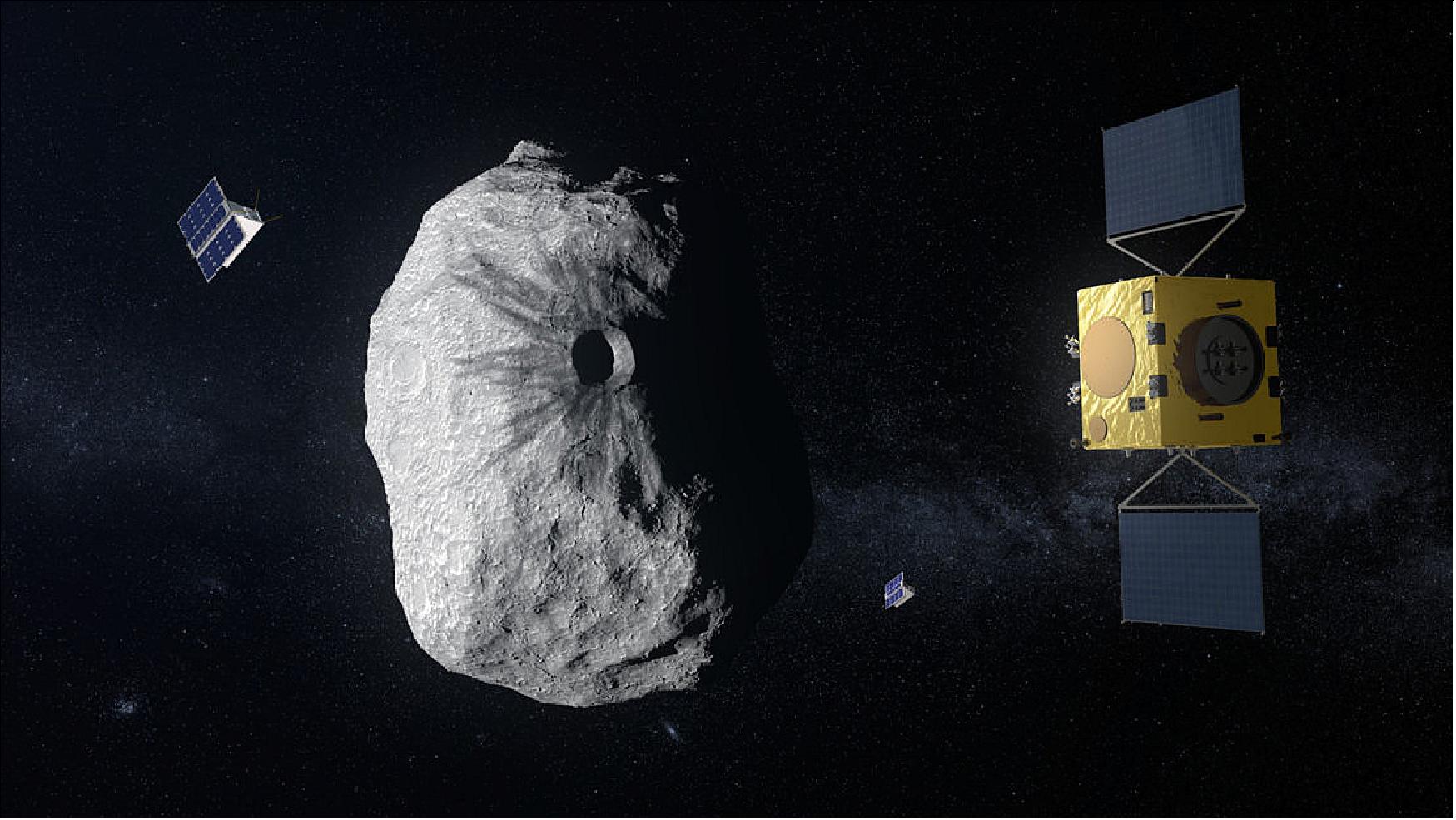
ESA’s Hera mission, now under study, will examine the aftermath of this impact to help determine whether humans can deflect threatening asteroids. Hera will also demonstrate the ability to operate at close proximity around a low-gravity asteroid with some on-board autonomy similar in scope to a self-driving car, going on to deploy Europe’s first deep-space CubeSats, and potentially also a micro-lander, to test out a new multi-point intersatellite link technology.
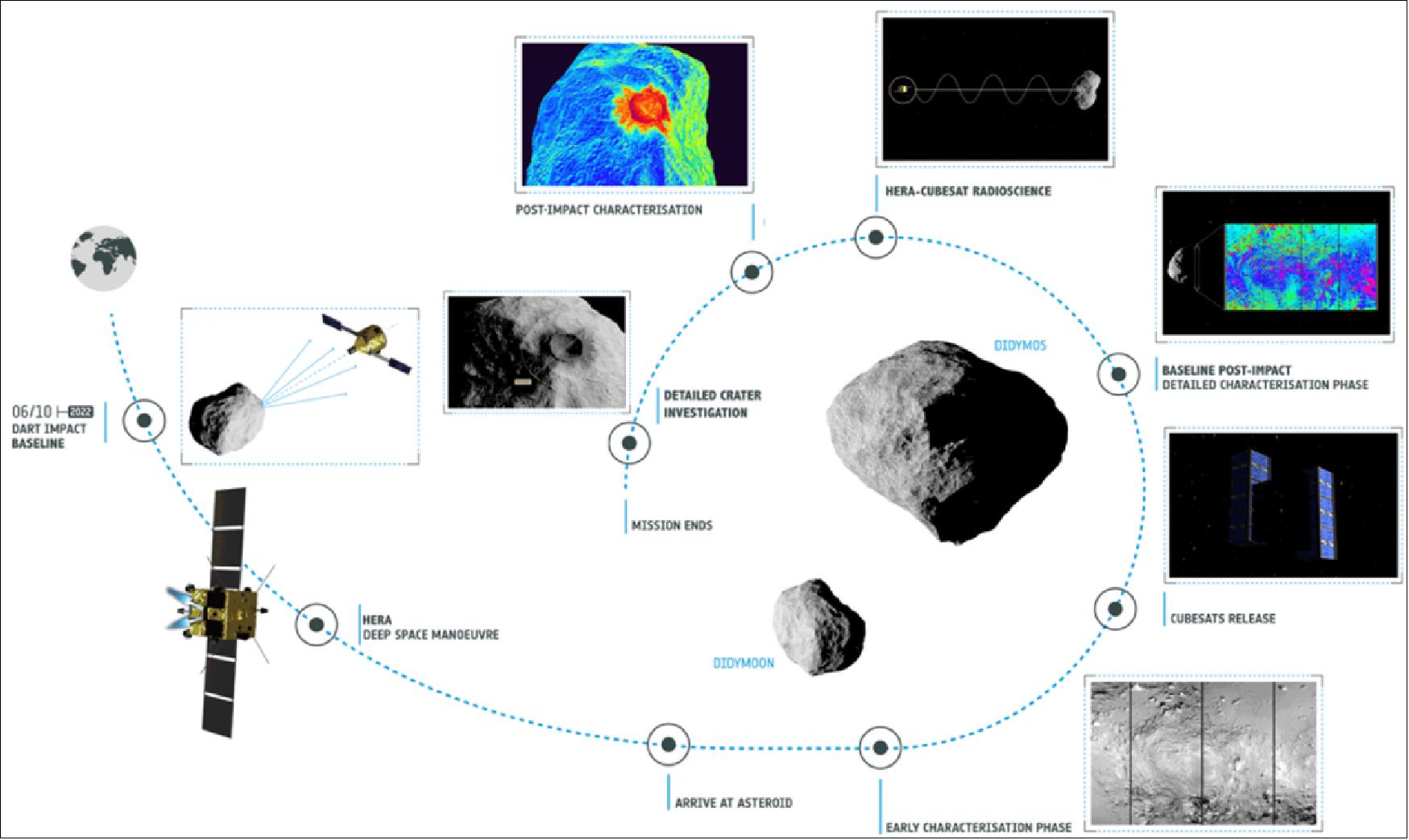
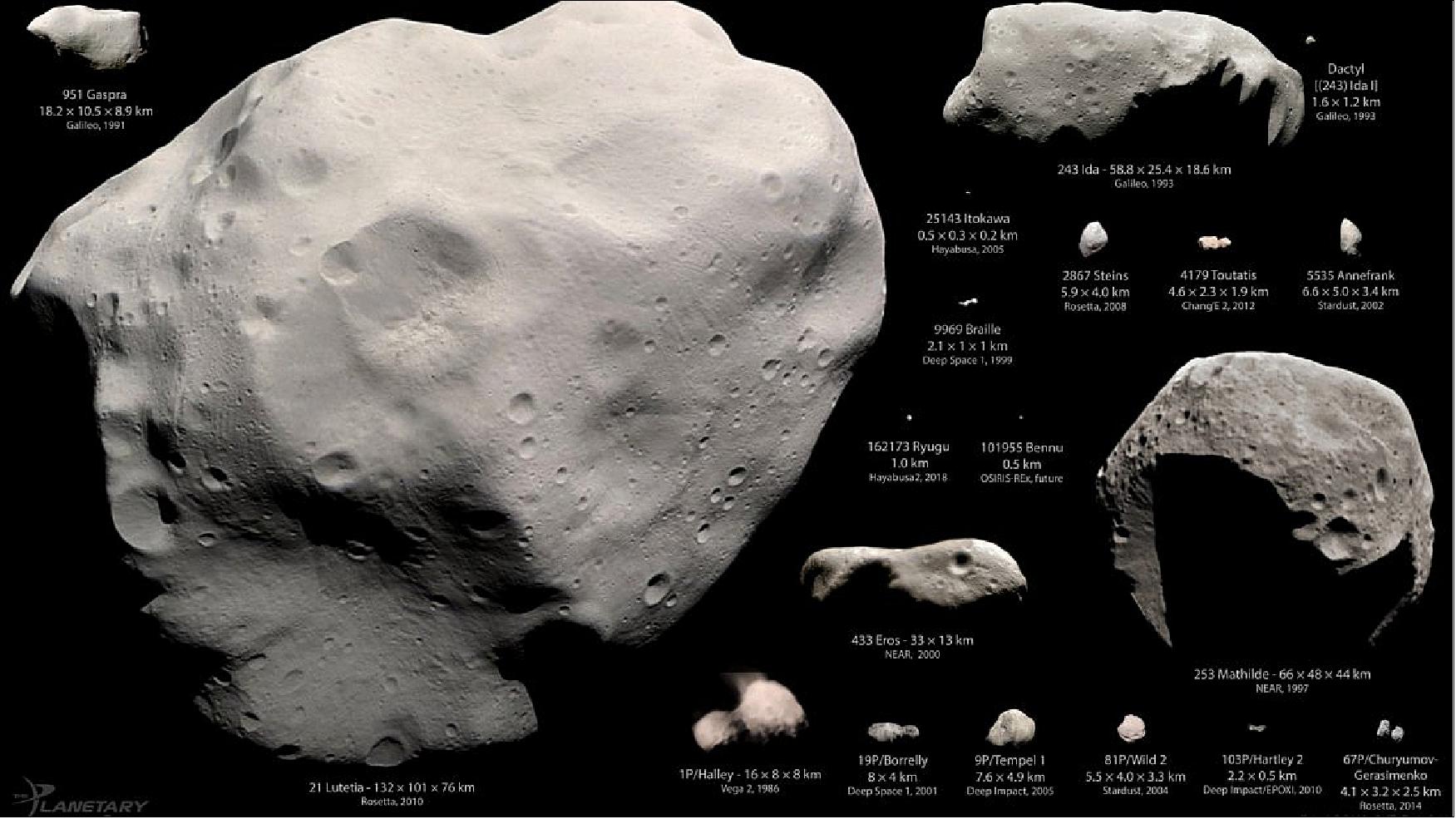
Spacecraft
Hera is a small spacecraft for deep space possessing comparable autonomy to a self-driving car. Its optimized design has benefited from multiple ESA studies of asteroid missions across the last two decades, most recently the proposed Asteroid Impact Mission. - Powered by solar arrays with a hydrazine propulsion system, Hera will be a small-scale mission in interplanetary terms, roughly the size of a large desk and weighing in at 350 kg, and up to about 870 kg full-fuelled – which is compact compared to the van-sized, 3 ton Rosetta comet-chaser.
Hera’s modern design means it will perform its guidance, navigation and control (GNC) tasks through an innovative strategy of data fusion, combining inputs from multiple sensors to build up a detailed picture of its surroundings in space. This would mean, for instance, bringing together the second-by-second visual tracking of distinctive features on the asteroid surface with lidar-based altimeter readings plus on board inertial sensors and star tracker measurements.
Hera has entered its detailed definition Phase B1 with the involvement of industry from Germany, Belgium, Romania, Luxembourg, Sweden, Portugal, Spain, Czech Republic, Austria, Finland, Poland and Switzerland.
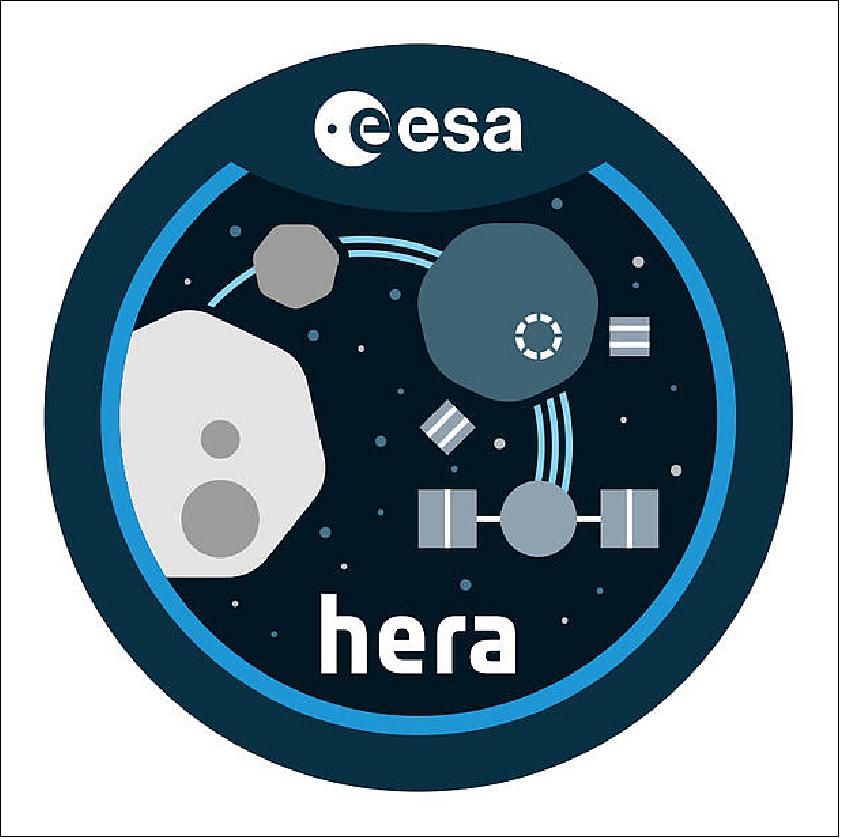
Launch
The Hera satellite is planned to rendezvous with asteroid Didymos in January 2027with the main objective of studying the results of NASA's DART hypervelocity impact (Ref. 6). - Hera will carry two CubeSats that will get up close and personal with Didymos and its partner, Dimorphos. 10)
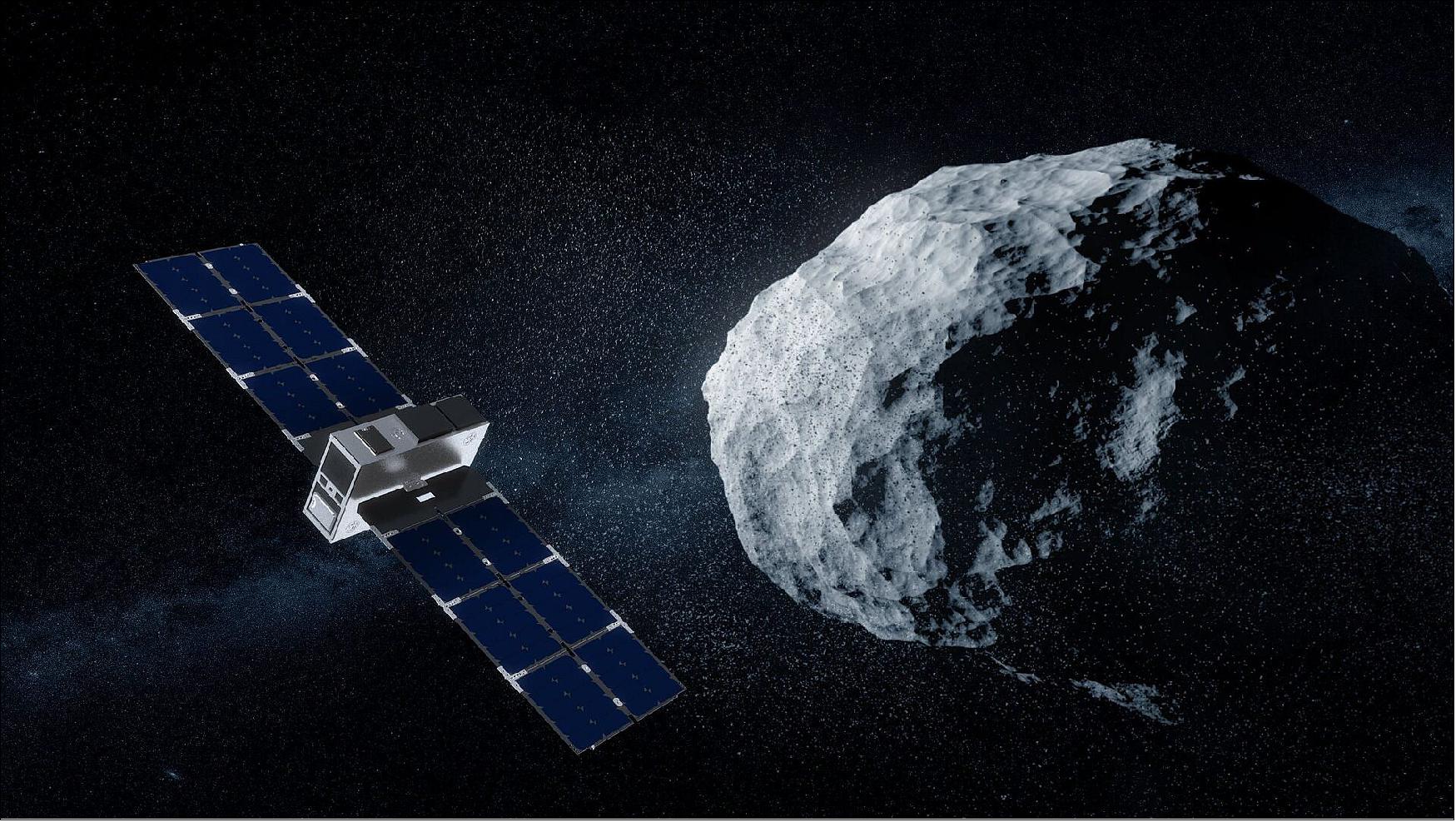
As ESA’s Hera mission reaches the Didymos double asteroid system, it will not be there alone: it will also serve as mothership for Europe’s first two ‘CubeSats’ into deep space. Juventas, performing subsurface radar sounding, is called after the daughter of Hera. The other, spectral surveyor Milani, takes the name of the researcher who began Europe’s asteroid risk monitoring system and came up with the original concept inspiring Hera and NASA’s DART – a double spacecraft mission for planetary defence (Ref. 10).
Mathematician and astronomer Andrea Milani served as professor of mathematics at the University of Pisa until his untimely death in 2018. Andrea led the creation of the first automated system to compute the probabilities that an asteroid could impact the Earth in the future, the well known NEODyS service of the University of Pisa.
This led in turn to ESA’s creation of a centre to monitor Near Earth Objects, resulting in the NEO Coordination Centre based at the Agency’s ESRIN centre in Frascati, Italy.
False impact alarm
“I knew Andrea well, and worked with him over the years on topics such as Pluto, and the dynamics of small bodies; he was an excellent scientist with a wide range of interests,” comments researcher Giovanni Valsecchi, retired from Italy’s National Institute for Astrophysics INAF.

“What spurred us to action in 1998 was the big splash surrounding an asteroid called 1997 XF 11, which was falsely reported in the media as being at risk of hitting Earth. Andrea got mad about that, because the claim was wrong.
“But what the incident made clear was that there was no systematic way of assessing an asteroid’s collision risk, so he decided to change that, with a system that automatically monitored the entire catalogue of Near Earth Objects (NEOs).”
Steve Chesley, then a post-doc student on a NATO fellowship, was recruited by Andrea to come to Pisa and work on what became NEODyS: “My first impression was that he was indignant about virtually everything, but he used that element of his personality almost as a tool to get things done; just look at his staggering list of papers. Once people got to know him well, he was like a big friendly teddy bear, and I learned so much working with him.”
“The project was an important one because while we had a pretty good asteroid search programme then, the pipeline was interrupted when it came to follow-up risk monitoring; there was no rigorous checking in place for protecting the Earth.”
Automated risk assessment
The challenge for Andrea and his colleagues was to devise an automated system that could deliver useful results in a practical timeframe, because the key point about asteroid orbits is that they evolve over time, perturbed by the gravitational pull of the Sun, Earth and other planets.
“What we wanted to do was model the asteroids’ orbits for the next hundred years ahead,” explains Giovanni. “So what you have to do is define the limits of all the asteroid’s potential orbits in six-dimensional space, then do a ‘Monte Carlo simulation’ where points are checked at random. But the problem was that would take weeks, especially using 1990s-era computers.
“We needed to find a better strategy. So instead we represent those orbits most relevant to the risk of collision with a curved 1-dimensional line. It’s based on observations in the end, because of our ignorance of the real orbit of the asteroid. Then as follow-up observations are received through the Minor Planet Center the possible space taken up by the orbit becomes confined to a smaller and smaller region, and we can preclude collision – although beyond a certain point dynamical chaos will always make our predictions foggy. We can also flag those objects that require further observation by astronomers to shrink down their uncertainty.
“The important thing is this gave us a way of speeding up the ‘heartbeat’ of the system, so that when a new asteroid is discovered we can give within a few hours a first estimate of its risk of hitting Earth.”
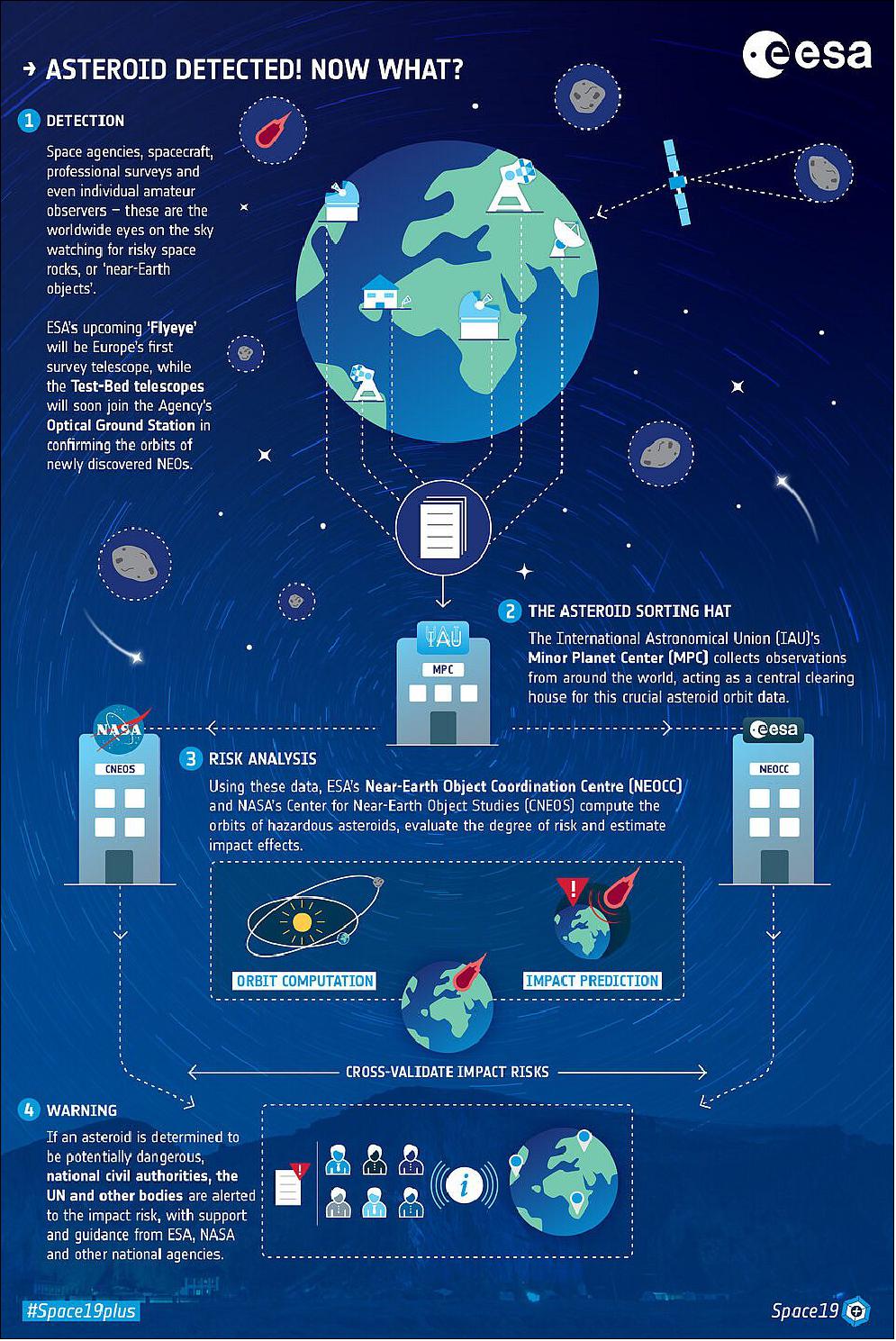
Making spaghetti from asteroids
Steve adds: “I compare this ‘line of variation’ representing an asteroid’s position uncertainty to a banana, thousands of times longer than it is wide, which is shrunk down to more like a wire by subsequent observations. With impact monitoring we highlight the parts of that wire could be cut by Earth.
“Then when I went to NASA’s Jet Propulsion Laboratory, where I set up Sentry as a companion system, which uses substantially the same theory, although running on independent software. So NEODys became operational in 1999, and Sentry followed it in 2002.”
Giovanni recounts: “In the end NEODys was academic in nature, so we started lobbying Italian space agency ASI and ESA to set up an operational centre, which resulted in ESRIN’s NEOCC.”
Today the NEOCC records 26,079 asteroids and 113 comets, of which 1190 are on the ‘risk list’ – having a non-zero probability of hitting Earth – although many are moved out of this status as follow-on observations constrain their possible orbital paths.
Both the European and US systems go on improving their operational efficiency, to keep up with the steady increase in NEO discoveries, which has increased by a factor of ten up to nearly 3 000 per year. And with many new observatories due to come onstream, including the first of ESA’s own ‘Fly-Eye’ telescopes that number is sure to go on growing.
How to deflect an incoming asteroid?
But the whole point of assessing collision risk is not just for an academic exercise but to enable us do something if needed, and Andrea was active here too.
“The idea began with NASA’s Deep Impact, which crashed a washing-machine-sized spacecraft into comet Tempel-1,” says Giovanni. “It was not possible to measure the effect on the comet’s orbital motion, but Andrea worked with the Deimos Space company in Spain to ask: what would be the ideal mission to perform such a measurement?”
The result Andrea christened Don Quijote, from the title of the famous novel written by Cervantes. One spacecraft called Hidalgo – after the story’s brave, windmill-tilting knight – would crash into an asteroid while the other, Sanchez – for his cowardly retainer – would survey the effects of the collision.
Don Quijote was one of six asteroid mission proposals studied in detail by ESA’s ESA Near-Earth Object Mission Advisory Panel in 2004, and highlighted as a mission that could provide a vital missing link in the chain from asteroid threat identification to addressing that threat.
The problem was money. ESA could not afford to mount the entire double-spacecraft mission by itself. Instead it became international in scale: NASA will fly the Double Asteroid Redirect Test spacecraft later this year, to impact the smaller of the Didymos binary asteroids in 2022. Then ESA’s Hera will follow it in 2024, arriving two years later.
Unfortunately Andrea will not be able to watch this grand-scale cosmic experiment he conceived. He passed away suddenly from a heart attack on the way to visit a friend.
“He is sorely missed,” adds Steve. “He had a massive intellect, and a sense of fun. I think he’d be very pleased to have a spacecraft named after him.”
Giovanni agrees: “Andrea had an asteroid named after him, 4701 Milani in the main Asteroid Belt, but I can imagine him thinking lots of scientists have asteroids named after them, very few get a space mission!”
Development Status
• June 15, 2022: A key element of ESA’s Hera mission for planetary defence has left the facilities of its manufacturer OHB in Bremen – a major step in preparation for its eventual odyssey to the Didymos asteroid system. 11)
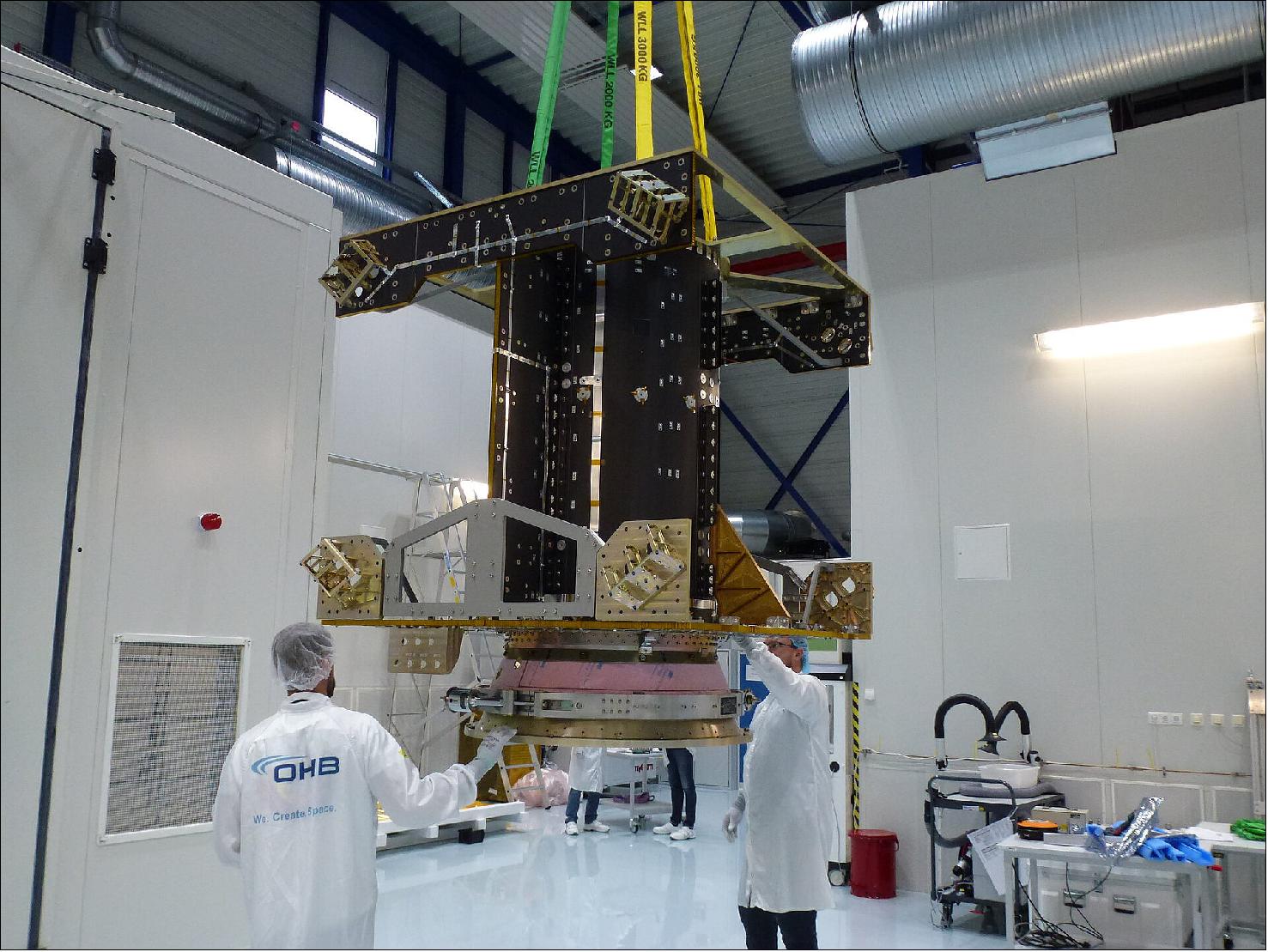
- On 26 September this year Dimorphos will become the very first Solar System body to have its orbit altered by human action in a measurable way, when NASA’s DART spacecraft impacts with it. When Hera arrives at the asteroid in December 2026 the spacecraft will perform a detailed post-crash investigation, assessing the mass and make-up of Dimorphos and measuring the crater left by DART’s impact, helping to validate kinetic impact as a workable planetary defence method.
- Meanwhile Hera’s other half, the Core Module, is also taking shape at OHB in Bremen. The Core Module will carry all the mission’s scientific instruments as well as on-board computer and other subsystems. The spacecraft will be completed when these two halves are eventually joined together.
• March 10, 2022: In a Swiss cleanroom, this historic object has been taking shape. Made of carbon fibre reinforced polymer, this is the central core of ESA’s Hera asteroid mission for planetary defence. 12)
- NASA’s DART spacecraft is currently on its way to the Didymos asteroid pair in deep space, to test the kinetic impact technique of asteroid deflection on the smaller of the two bodies on 26 September this year.
- Hera will fly to the same asteroid system in the aftermath of the impact to perform a close-up ‘crime scene investigation’, including close-up mapping of DART’s crater and assessing the asteroid’s make-up and internal structure.
- It will then be passed on to Avio in Italy to integrate its propulsion module. The bottom aluminum cone includes the Launcher Interface Ring, providing all necessary connections with the launcher.
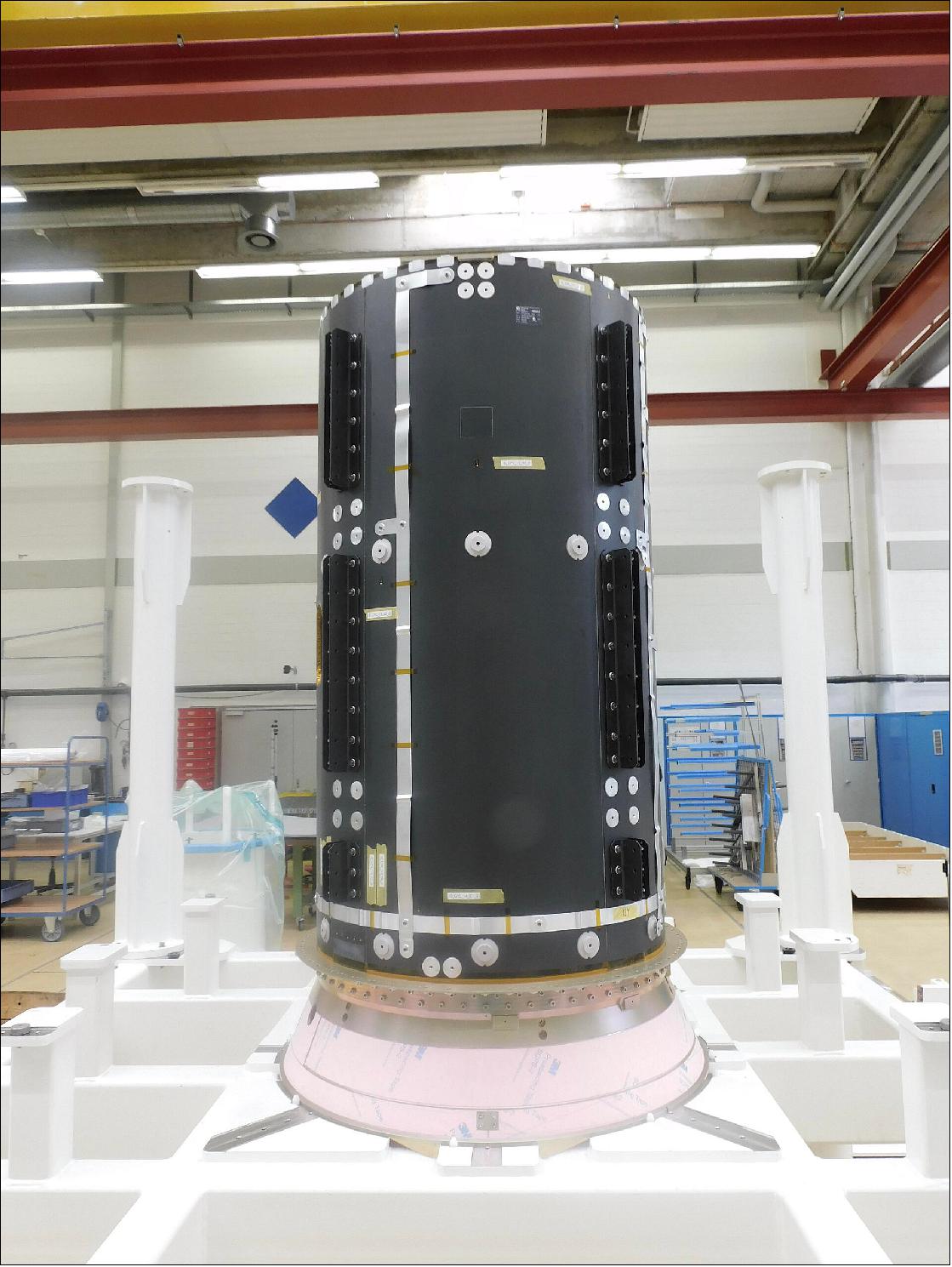
• November 17, 2021: A specially upgraded radio-frequency chamber in ESA’s technical heart (ESTEC) is testing what is set to become the smallest radar system to be flown in space, hosted aboard a breadbox-sized spacecraft. 13)
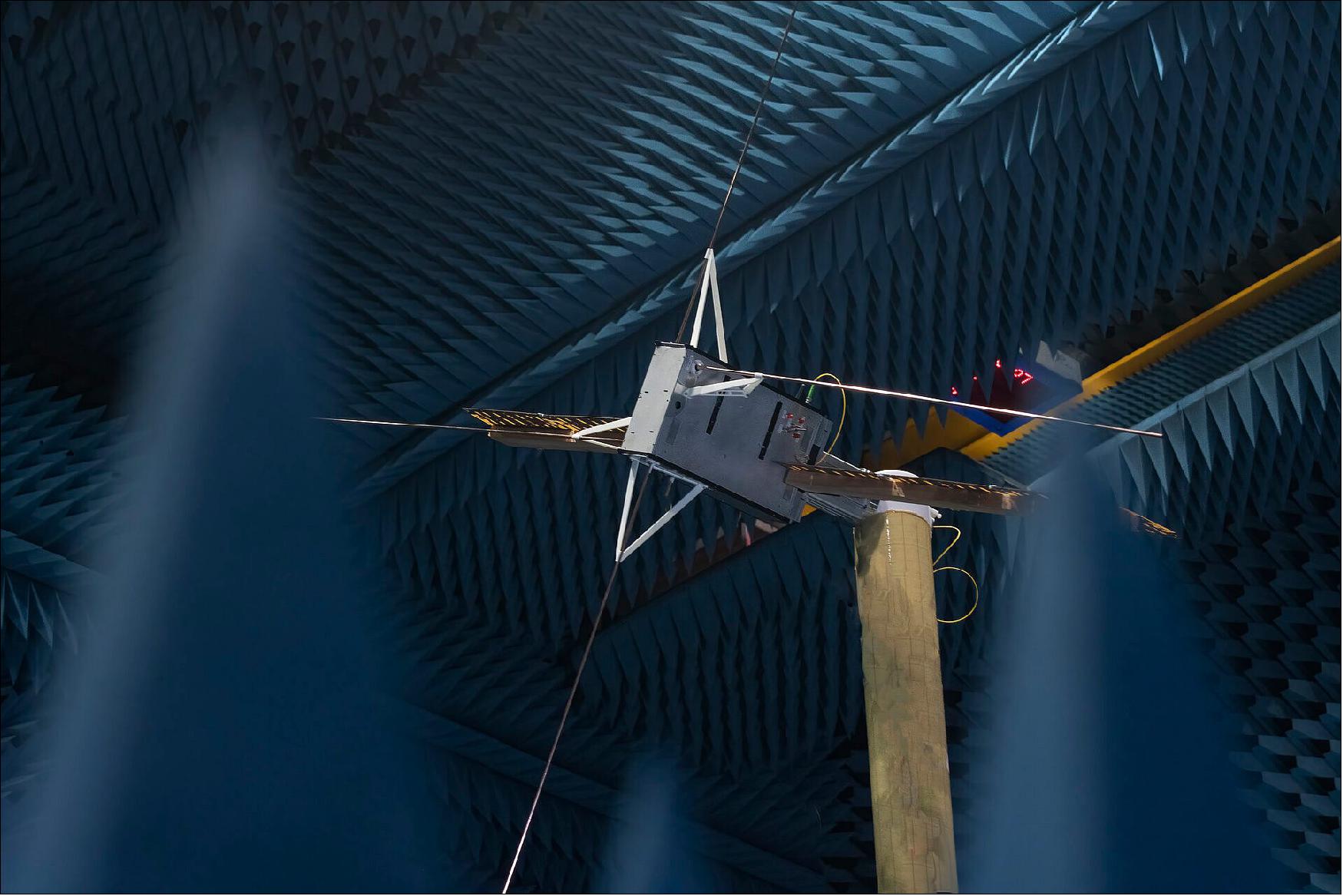
- Juventas is a 6U CubeSat, measuring 10 x 20 x 30 cm, while its quartet of radar antennas measure 1.5 m long each. So the test campaign includes a structural model of the Juventas CubeSat, to evaluate how the body of the miniature spacecraft might affect the radar signals.
- The test campaign is taking place inside the ‘Hybrid European Radio Frequency and Antenna Test Zone’ or Hertz chamber at ESA’s European Space Research and Technology Centre (ESTEC) in the Netherlands. However testing here only became feasible after a skillful upgrade.
- “An essential element of anechoic test chambers like Hertz are the radio-absorbing foam spikes lining the inside walls, allowing tests to mimic the infinite void of space,” explains ESA antenna engineer Paul Moseley.
- “But typically Hertz can only test down to 400 MHz, while Hertz’s main antennas will radiate at 60 MHz. At this frequency the spikes no longer absorb signals, so instead of a dark room the chamber would be turned into a hall of mirrors, throwing out multiple radio reflections that interfere with the accuracy of our measurements.”
- ESA’s Hertz team worked with MVG in Italy to devise a new setup making lower frequency testing possible, initially as part of a general upgrade but then specially targeted to enable Juventas testing.
- Paul adds: “It’s a combination of hardware and software that allows us to measure in this environment but still reconstruct the correct results, including fibreglass support towers that are transparent to antennas and software that combines measurements made at many different points across the room, in order to cancel out the reflection effects.”
- Franco Perez Lissi of ESA’s CubeSats Systems Unit is overseeing the Juventas testing: “We’re measuring the radiation pattern in a full sphere surrounding the antennas- the results of which should also be very useful for Juventas’s critical design review, taking place next month – as well as the total radiated power. This entire campaign additionally serves as a dress rehearsal of sorts for the flight model of Juventas, which is scheduled to be tested here in early 2023.”
- The radar aboard Juventas is developed from the Rosetta spacecraft’s CONSERT radar system, which peered into the interior of Comet 67P/Churyumov–Gerasimenko. It is a synthetic aperture radar design, meaning it will take advantage of Juventas’s orbit 3 km above the surface of Dimorphos to integrate together multiple signal reflections and resolve them into images.
- “We are proud to see Rosetta’s legacy living on in the next generation of deep-space missions,” adds Alain Herique of the University of Grenoble, Principal Investigator of Juventas’s JuRa low-frequency radar.
- Juventas is being led for ESA by GomSpace company in Luxembourg with GMV in Romania, with its radar developed by the Planétologie et d'Astrophysique de Grenoble group at the University Grenoble and Technical University Dresden, with Astronika in Poland constructing the antennas and EmTroniX in Luxembourg contributing the signal generation system.
- Hera will also be embarking a second deep space CubeSat, the Italian-led Milani, which will employ a multispectral imager to prospect the asteroid’s surface composition. Hera will be preceded to the Didymos asteroids by NASA’s DART spacecraft which will perform a test deflection of the smaller body. DART is due for launch next Wednesday, 24 November.
• June 1, 2021: Meet Hera, our very own asteroid detective. Together with two briefcase-sized CubeSats – Milani the rock decoder and Juventas the radar visionary – Hera is off on an adventure to explore Didymos and Dimorphos, an asteroid pair typical of the thousands that pose an impact risk to planet Earth. 14)
• April 14, 2021: This drone hauled a model of the Juventas CubeSat high into the air, as a practical test of the antennas designed to perform the first radar sounding of the interior of an asteroid. 15)
- The shoebox-sized Juventas will be transported to the Didymos double-asteroid system by ESA’s Hera mission. Once it flies freely in space, Juventas will deploy a cross antenna to perform a low-frequency radar scan up to 100 m deep within the smaller of the two asteroids, Dimorphos. Such low frequencies result in long wavelengths of around 6 m, too long for most indoor measurement facilities.
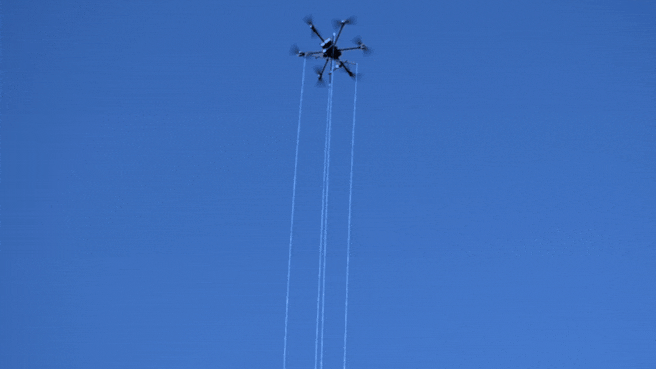
- “For the most accurate measurements of the antennas’ radiation properties, they had to be as far away as possible from other objects, so the Juventas model was hung 10 m down from the drone, which was flown up to 50 m into the sky.”
- The testing allowed them to assess the amount of radiated power of the antennas compared to radio frequency modelling, and also to assess at which altitude interference from ground reflections would cut out.
- TU Dresden is working on the antenna placement, amplification and performance simulation for Juventas’s radar instrument, while Astronika in Poland is constructing the antennas and EmTroniX in Luxembourg is developing the signal generation system. The overall Juventas mission is being led for ESA by GomSpace.
- Juventas's radar instrument, or JURA, is scientifically and technically overseen by Alain Hérique of France’s Institut de Planétologie et d'Astrophysique de Grenoble (IPAG) at the Université Grenoble Alpes and Dirk Plettemeier of TU Dresden.
• March 30, 2021: An international research group, including Queen guitarist and astrophysicist Brian May, has shown how the same forces responsible for building dust bunnies under our beds may be responsible for holding the asteroid Didymos together. 16)
- Didymos is the target of NASA’s DART and ESA’s Hera planetary defence missions. It is a binary near-Earth asteroid, with the 780 m diameter main asteroid orbited by a 160 m diameter moonlet called Dimorphos.
- This year NASA’s DART spacecraft lifts off on a journey to impact Dimorphos and shift its orbit. Then in 2024 ESA’s Hera mission will perform close-up measurements of the asteroid’s impact crater, composition and mass, as well as precisely measuring its deflection.
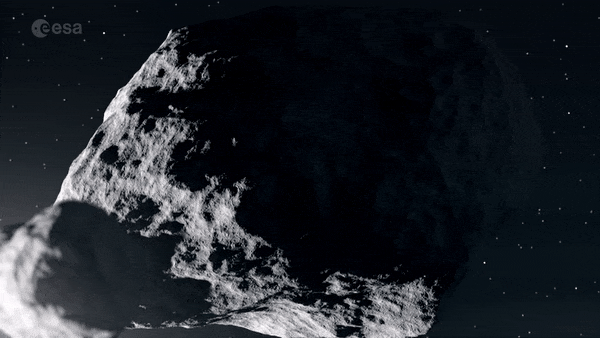
- Based on our current knowledge of how asteroids form, bodies the size of Didymos are expected to be accumulated ‘rubble piles’ of material. Yet Didymos spins relatively quickly, rotating once every 2.26 hours, which could theoretically cause it to break apart depending on its structural properties.
- In our previous study, we showed that if Didymos was a rubble pile made of boulders that are only held together by their gravitational attraction, it would not be stable at its current spin rate with an estimated nominal density of 2170 kg/m3,” says Yun Zhang, Université Côte d’Azur, Observatoire de la Côte d’Azur and CNRS Lagrange Laboratory (UCA, OCA, CNRS), Nice, France.
- To investigate this mystery, Yun and colleagues, used advanced supercomputer simulations to spin the asteroid apart. Then, Brian May and his collaborator, Claudia Manzoni from the London Stereoscopic Company, made stereo 3D movies of the disruption event.
- “Seeing the outcome of our modelling in 3D is absolutely amazing and provides information that we simply could not access through a 2D movie on a computer screen,” says Patrick Michel, Hera principal investigator, also from UCA, OCA, CNRS.
- In this new study, the team estimated the amount of cohesion between the asteroid’s constituent boulders. “Cohesion serves as a glue between the different pieces,” says Yun. “It originates from the so-called Van der Waals forces, most likely caused by the presence of very small grains between the boulders in the rubble pile.” 17)
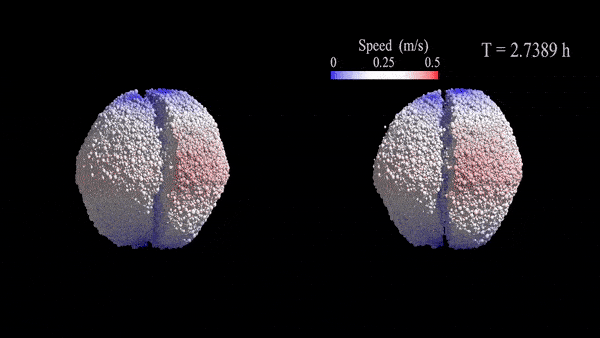
- Van der Waals forces are produced because of the way electrical charge is distributed within atoms or molecules. It is the force that builds ‘dust bunnies’ in neglected corners of our houses and under our beds. This is because in the Earth’s gravitational field, the force is only strong enough to have an effect on particles a few fractions of a millimeter across. But in the ultra-low-gravity environment of Didymos it could come into play on a much wider scale.
- Based on the team’s calculations, Didymos requires a surface cohesion of between 3 to 6 Pascals (the standard unit of pressure), and an internal ‘bulk’ cohesion of between roughly 11 to 17 Pascals, depending on particle arrangement and size distribution. This is minuscule. The pressure of Earth atmosphere at sea level is a huge 101 325 Pascals in comparison. Nevertheless, it makes all the difference. Without it, the virtual Didymos would break apart.
- “It is fascinating to discover that even a very tiny amount of cohesion makes a huge difference in the structural stability of an asteroid,” says Brian. “The equivalent of a small leaf on the top of my hand is what makes the difference.”
- The work also suggests a possible origin for Dimorphos. The team speculate that the moonlet could have been flung off from its parent asteroid via some past ‘spin-up’ event.
- “We’ve recently come to the realization that asteroids are not just dead space rocks,” adds Brian. “These are geologically active small worlds in their own right, experiencing very different conditions from Earth’s, which continue to challenge our assumptions.”
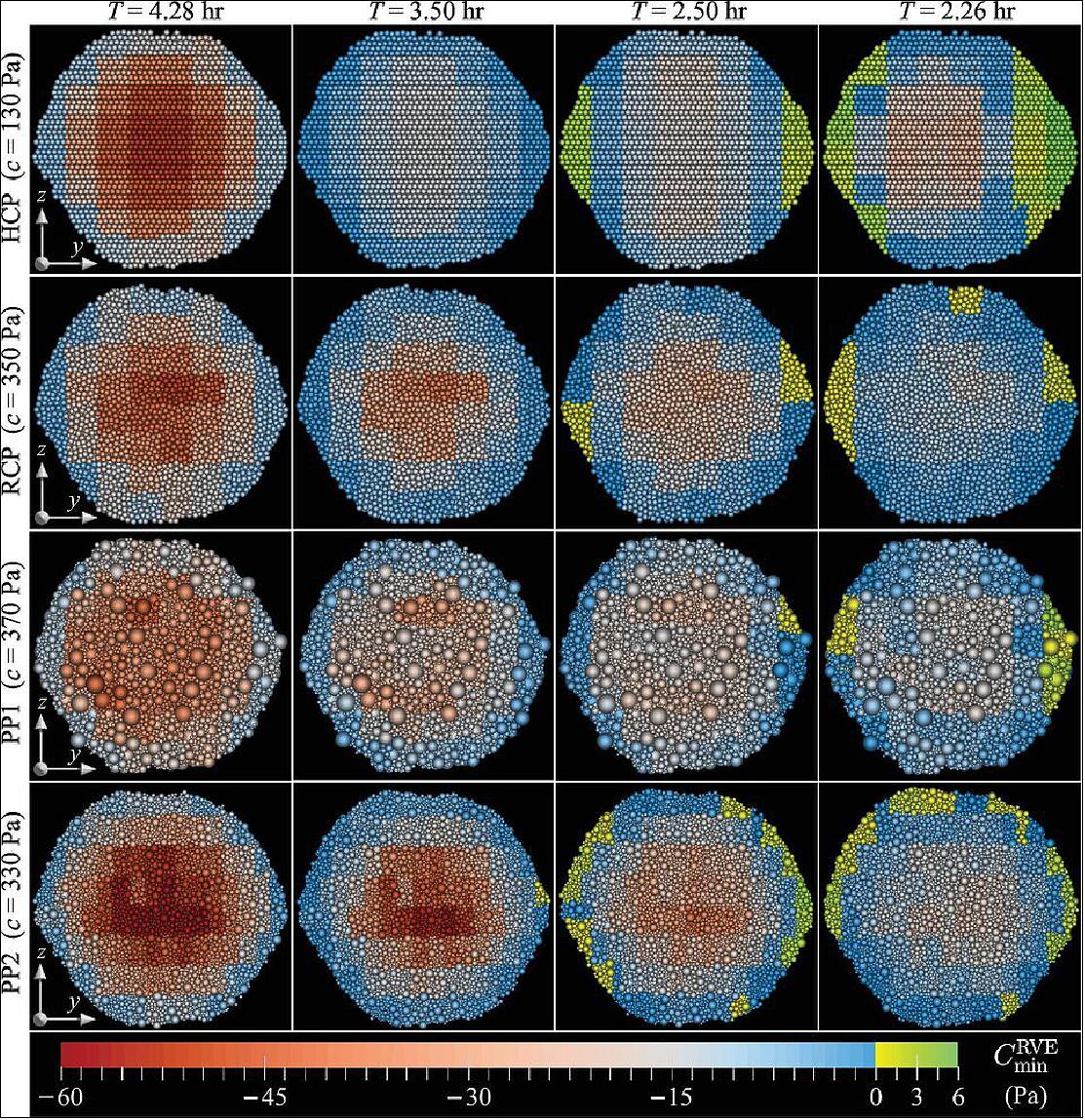
• February 2, 2021: Journey to an asteroid with Hera – a small spacecraft with big ambitions. Hera is ESA’s contribution to humanity’s first ever planetary defence experiment. Its up-close observations of double asteroid system Didymos will help prove whether we could ever deflect an asteroid on a collision course with Earth. 18)
• September 15, 2020: Today ESA awarded a €129.4 million contract covering the detailed design, manufacturing and testing of Hera, the Agency’s first mission for planetary defence. This ambitious mission will be Europe’s contribution to an international asteroid deflection effort, set to perform sustained exploration of a double asteroid system. 19)
- Hera – named after the Greek goddess of marriage – will be, along with NASA's Double Asteroid Redirect Test (DART) spacecraft, humankind’s first probe to rendezvous with a binary asteroid system, a little understood class making up around 15% of all known asteroids.
- The contract was signed today by Franco Ongaro, ESA Director of Technology, Engineering and Quality, and Marco Fuchs, CEO of Germany space company OHB, prime contractor of the Hera consortium. The signing took place at ESA’s ESOC centre in Germany, which will serve as mission control for Hera.
- Hera is the European contribution to an international planetary defence collaboration among European and US scientists called the Asteroid Impact & Deflection Assessment, AIDA. The DART spacecraft – due for launch in July 2021 – will first perform a kinetic impact on the smaller of the two bodies. Hera will follow-up with a detailed post-impact survey to turn this grand-scale experiment into a well-understood and repeatable asteroid deflection technique (see Figure 24).
- While doing so, the desk-sized Hera will also demonstrate multiple novel technologies, such as autonomous navigation around the asteroid – like modern driverless cars on Earth – while gathering crucial scientific data, to help scientists and future mission planners better understand asteroid compositions and structures.
- Hera will also deploy Europe’s first ‘CubeSats’ (miniature satellites built up from 10 cm boxes) into deep space for close-up asteroid surveying, including the very first radar probe of an asteroid’s interior – using an updated version of the radar system carried on ESA’s Rosetta comet mission.
- Hera will travel to a binary asteroid system – the Didymos pair of near-Earth asteroids. The 780 m-diameter mountain-sized main body is orbited by a 160 m moon, formally christened 'Dimorphos' in June 2020, about the same size as the Great Pyramid of Giza.
- DART’s kinetic impact into Dimorphos in September 2022 is expected to alter its orbit around Didymos as well as create a substantial crater. This moonlet asteroid will become unique, as the first celestial body to have its orbital and physical characteristics intentionally altered by human intervention. Hera will arrive at the Didymos system at the end of 2026, to perform at least six months of close-up study.
- Hera’s mission control will be based at ESA’s ESOC centre in Darmstadt, Germany, also the home of ESA’s new Space Safety and Security program, of which Hera is a part.
- This contract signing covers the full Hera satellite development, integration and test, including its advanced guidance, navigation and control (GNC) system. Contracts for Hera’s two hosted CubeSats and relevant technology developments are already ongoing.
• June 24, 2020: The newly-named Dimorphos – at 160 m across, about the size of Egypt’s Great Pyramid – orbits around the main 780 m mountain-sized Didymos near-Earth asteroid. Next year NASA’s Double Asteroid Redirection Test (DART) will leave Earth and in October 2022 will collide with Dimorphos, in an attempt to deflect its orbit. 20)
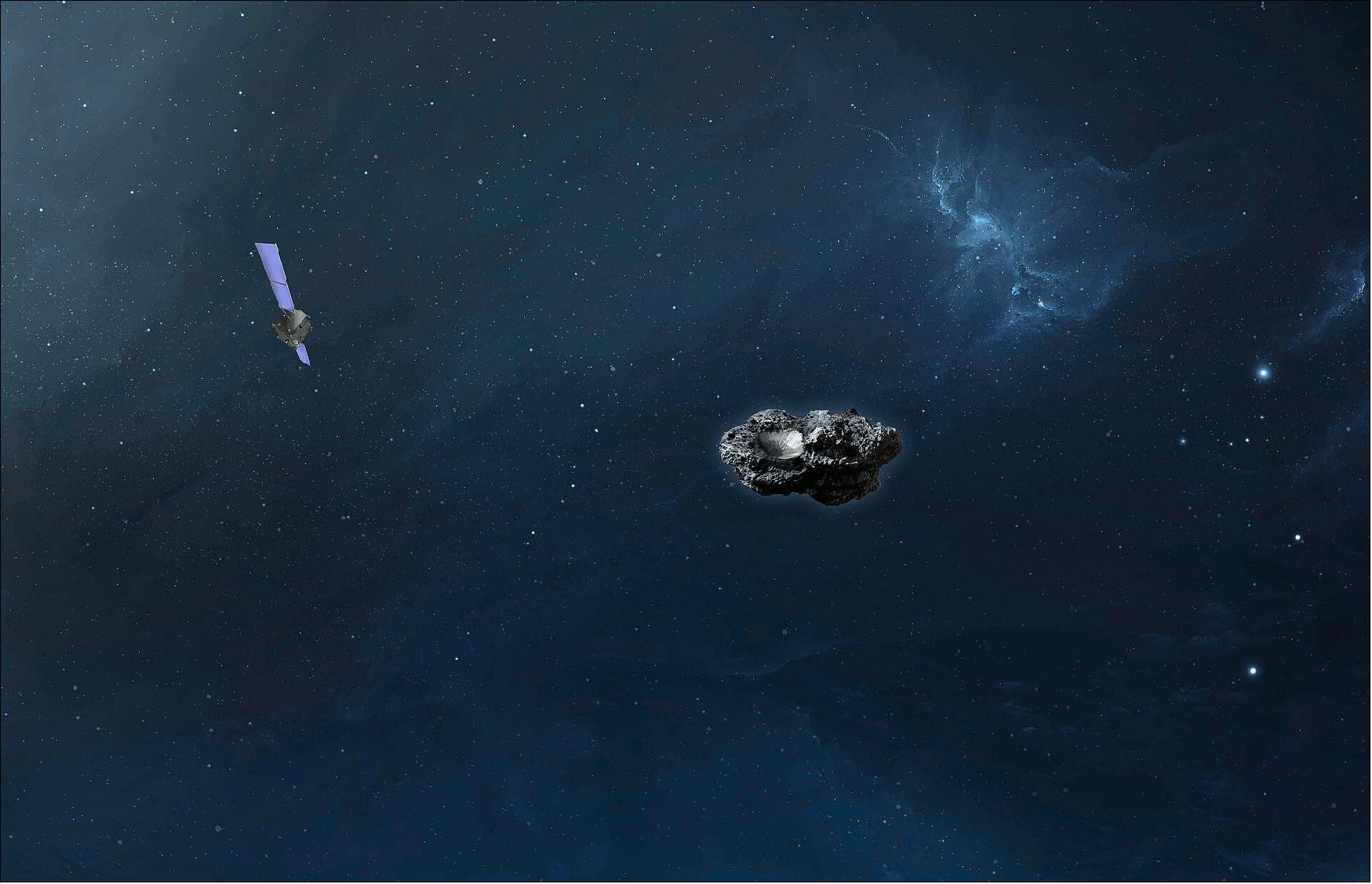
- Then in 2024 ESA’s Hera spacecraft will set off to perform a close-up investigation of the result: the sole object in the Solar System to have had its orbit shifted by humankind in a measurable way.
- By gathering details of Dimorphos’s mass, composition and the crater left by DART, Hera – along with the two CubeSats it will carry with up, for close-up views – will let researchers assess the effectiveness of the deflection technique in as full a manner as possible, enabling its reuse if needed against an oncoming asteroid.
- Hera will also return plentiful bonus science, with its Juventas CubeSat performing the first radar survey of an asteroid’s interior, demonstrate inter-satellite link technology in deep space and provide experience of ultra-low gravity operations.
- This month, ESA is celebrating the UN-recognized Asteroid Day, to inspire the world about asteroids and their role in the formation of our solar system, how we can use their resources, how asteroids can pave the way for future exploration and how we can protect our planet from asteroid impacts.
• June 23, 2020: The destination of ESA’s Hera mission for planetary defense – a tiny asteroid moonlet – has finally received its official name. After years of informal nicknames and temporary designations, the smaller of the Didymos asteroid pair has been formally christened ‘Dimorphos’ by the International Astronomical Union. 21)
- A near-Earth binary asteroid system, named after the Greek word for ‘twin’, Didymos’s main body measures about 780 m across, with its previously nameless moonlet about 160 m in diameter, approximately the size of Egypt’s Great Pyramid.
- In 2022, this moonlet will be the target of NASA’s Double Asteroid Redirection Test (DART), the first full-scale demonstration of an asteroid deflection technology for planetary defense. ESA’s Hera mission will be launched to perform a close-up survey of Dimorphos, along with its parent asteroid, following DART’s impact.
- “Dimorphos is Greek for ‘having two forms’,” says Kleomenis Tsiganis, a planetary scientist at the Aristotle University of Thessaloniki and member of both the DART and Hera teams, who suggested the name.
- “It has been chosen in anticipation of its future status as the first celestial body to have its ‘physique’ intentionally altered by human intervention, the kinetic impact of DART. Hence, it will be known to us by two, very different forms, the one seen by DART before impact and the other seen by Hera, a few years later.”
- DART’s kinetic impact into Dimorphos is expected to alter its orbit around Didymos as well as create a substantial crater, which will be studied by the Hera spacecraft when it arrives several years later. The DART impact itself will be recorded by the Italian-made LICIACube CubeSat, deployed from DART several days earlier, with longer-term effects studied by telescopes on Earth’s surface and in space.
- “In the past we’ve referred to it as Didymos-B, or Didymoon, but the target of our mission finally has an official name, confirmed by the International Astronomical Union, IAU,” comments Ian Carnelli, managing Hera for ESA.
- “It is one more small step towards making our destination seem like a real place, just as astronomers around the globe are observing what is currently just a minuscule dot in the sky to gather all the practical details they can, in support of DART and Hera mission planning. We can’t wait to see what is really looks like from up close and we are excited to plan close proximity investigations for at least six months in 2027.”
- “It is one more small step towards making our destination seem like a real place, just as astronomers around the globe are observing what is currently just a minuscule dot in the sky to gather all the practical details they can, in support of DART and Hera mission planning. We can’t wait to see what is really looks like from up close and we are excited to plan close proximity investigations for at least six months in 2027.”
- The Hera mission will also deploy two CubeSats to perform additional detailed investigations explains Hera mission scientist Michael Kueppers: “The Juventas CubeSat will be the first ever spacecraft to use a low-frequency radar to scan the interior structure of an asteroid. Understanding the interior structure is a fundamental step in the full interpretation of DART’s impact with Dimorphos.”
• June 22, 2020: The United Nations’ International Asteroid Day on 30 June highlights ESA’s expanding efforts to secure our future by understanding and addressing risks posed by near-Earth objects that could impact our planet. 22)
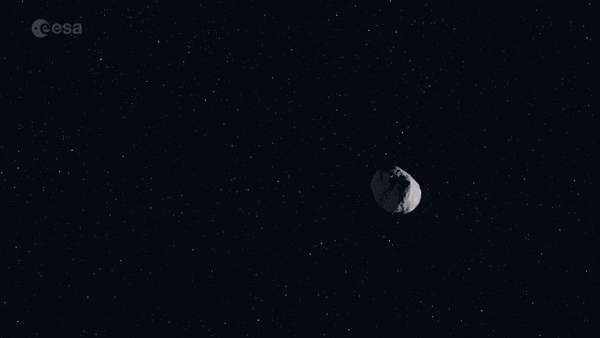
- “The work of ESA and the international planetary defence community is a great example of how to address this important hazard,” says ESA Director General Jan Wörner. “An asteroid impact is the only natural disaster we might avoid, if we see one coming soon enough.”
- “Even when the threat is low, governments and international organisations such as the UN working together show that it is possible to get ready in advance and mitigate damage from a global threat that can affect anyone, anywhere.”
- Current activities include:
a) Detailed design work is proceeding on ESA’s first planetary defence validation mission: the Hera spacecraft will fly to the Didymos asteroid pair, following on from NASA’s DART mission due to be launched next year, which will deflect the smaller asteroid.
b) ESA’s long-running asteroid observations have resumed, following a brief pause due to the COVID-19 pandemic. Near-Earth asteroids are identified and tracked from various telescopes across Europe and the world.
c) ESA’s Near-Earth Object (NEO) Coordination Centre in Italy continues to coordinate asteroid observations and assess risks from newly discovered objects, despite the serious COVID-19 effects in that country.
d) The first of ESA’s new multi-optic ‘Flyeye’ telescopes is under construction near Milan, and will facilitate the automated detection of asteroids once in operation.
e) ESA’s deep-space ground stations have contributed communication coverage for Japan’s Hayabusa2 mission, which is now headed Earthward after collecting samples from an asteroid.
f) ESA is sponsoring a Grand Challenge on In-Situ Resource Utilization for the Moon and asteroids, allowing future explorers to make use of materials found in space. Temporarily suspended due to the COVID-19 pandemic, this €500,000 competition is set to resume soon.
g) The Agency’s suitcase-sized ‘Miniature Asteroid Remote Geophysical Observer’ (M-Argo) spacecraft is about to undergo its Preliminary Requirements Review, where experts will declare this audacious mission feasible. ESA's Comet Interceptor mission, planned to launch near the end of this decade, will wait in space for a suitable body — potentially even an interstellar comet — to investigate.
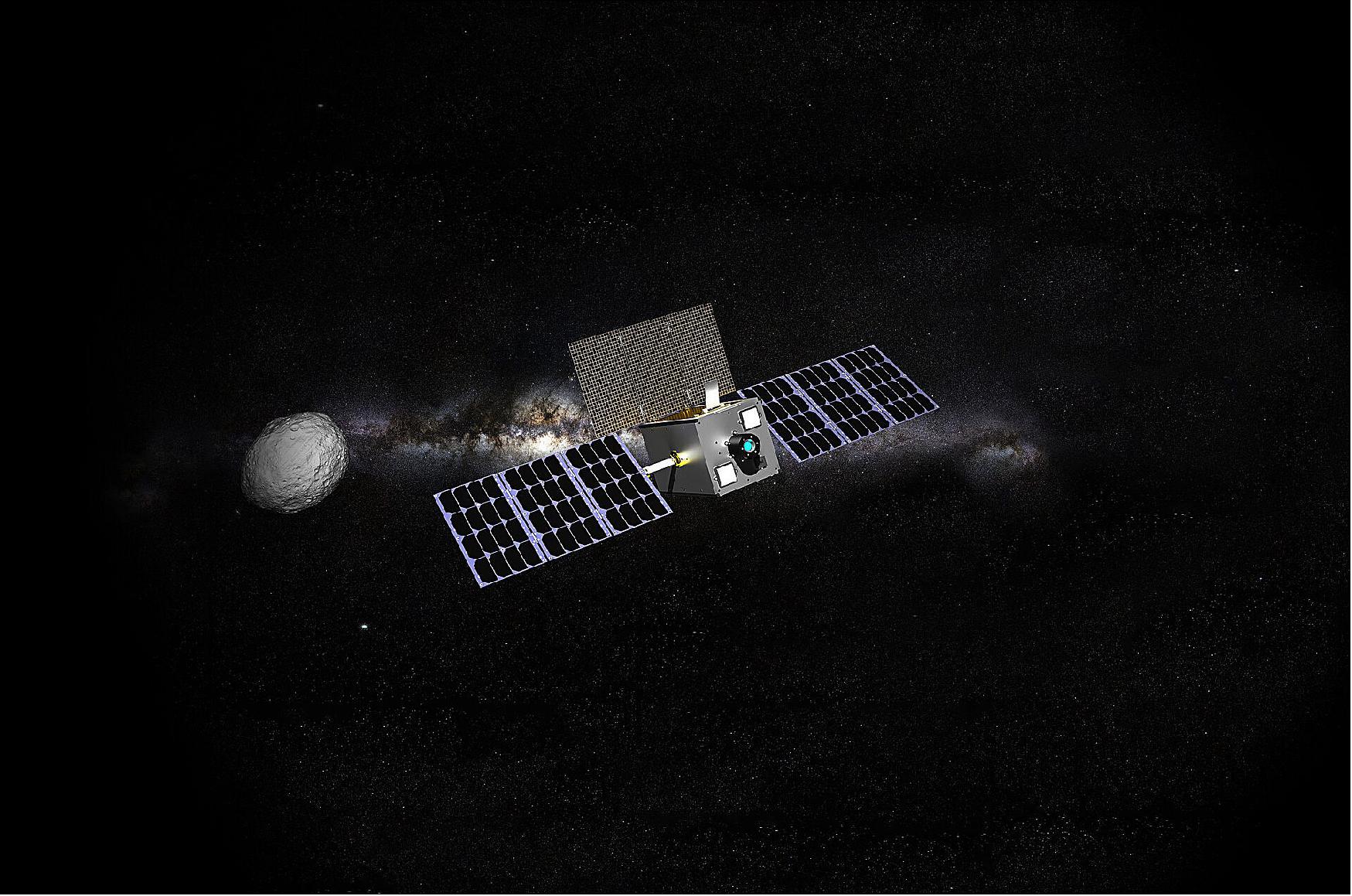
ESA and Space Safety
- Under the Agency’s Space Safety Program, which received an important boost in funding at the Space19+ Ministerial Council in November 2019, ESA is taking action as part of an international effort to mitigate asteroid risks.
- ESA’s goal is to coordinate Europe’s part of a global planetary defence effort, aimed at detecting, studying and following asteroids, predicting if and when they might hit and taking mitigation action if needed.
UN Asteroid Day
- On 30 June 1908, the Tunguska impact felled many millions of trees across 2200 km2 of Siberian territory, only a few hours of Earth rotation away from Europe – the results would have been disastrous over a populated area.
- Asteroid Day, a UN-endorsed awareness campaign day to mark this historic date, was co-founded by astrophysicist and famed musician Dr Brian May of the rock group Queen, Apollo 9 astronaut Rusty Schweickart, filmmaker Grig Richters, and B612 President Danica Remy.
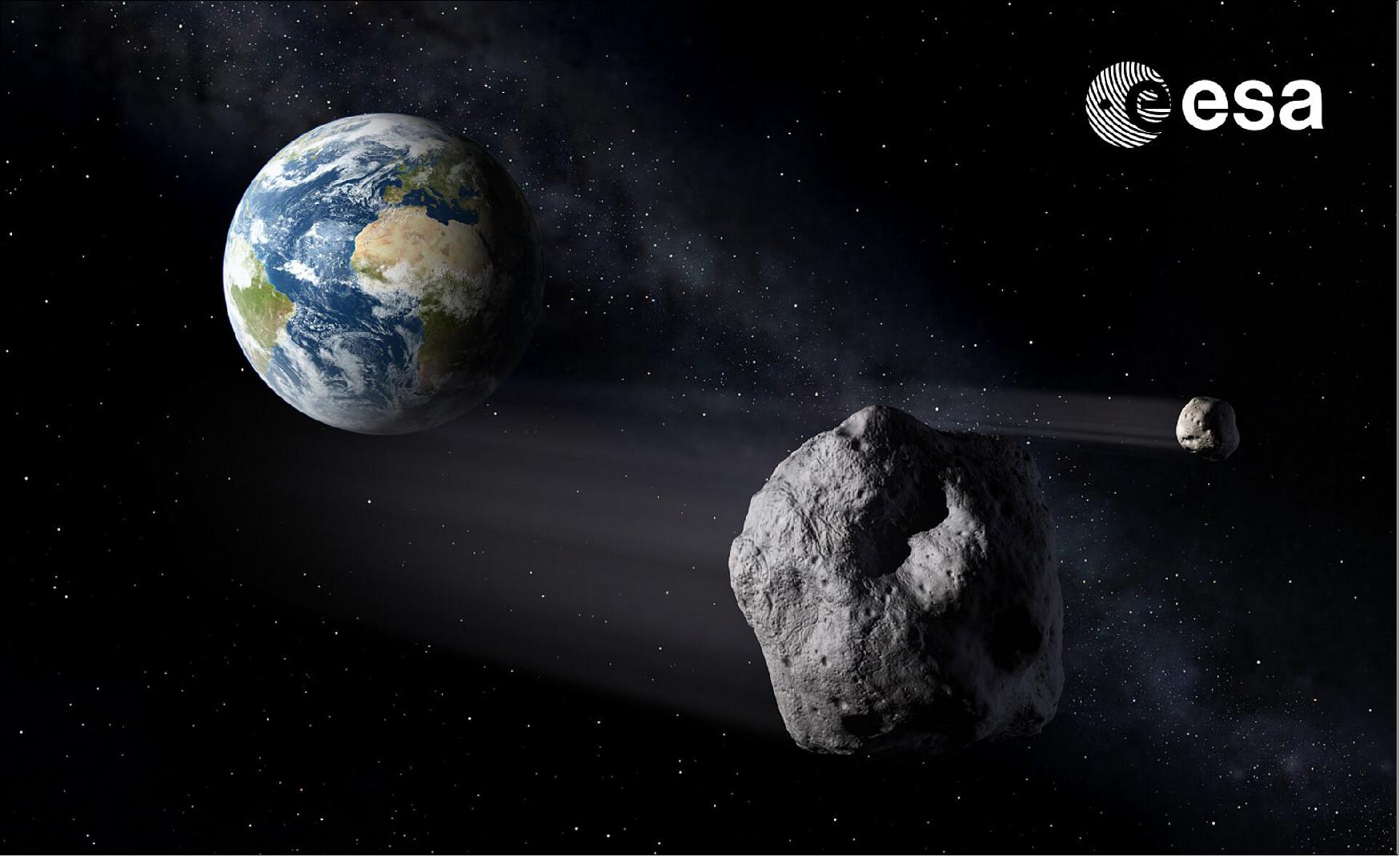
Asteroid Day TV Supported by ESA
- This year, activities to mark Asteroid Day are moving entirely online, and include a month of Asteroid Day TV distributed by the Luxembourg-based Asteroid Foundation and including programming by ESA as well as top content makers including Discovery Science, TED, IMAX, BBC, CNN, ESO and other educational producers.
- Asteroid Day TV will distribute Asteroid Day LIVE from Luxembourg starting 30 June at 12:00 CEST including five hours of ESA and Asteroid Day program segments newly produced for 2020 in English.
- ESA is also planning new program segments in Dutch, French, German, Italian and Spanish. These will premiere in advance of 30 June.
- All segments will be broad- and webcast to the public via AsteroidDay.org, via SES Satellite and to other broadcasters via satellite and digital CDN via RTL’s Broadcasting Center Europe (BCE).
- Segments will also be available via ESA Web TV and ESA’s YouTube channel.
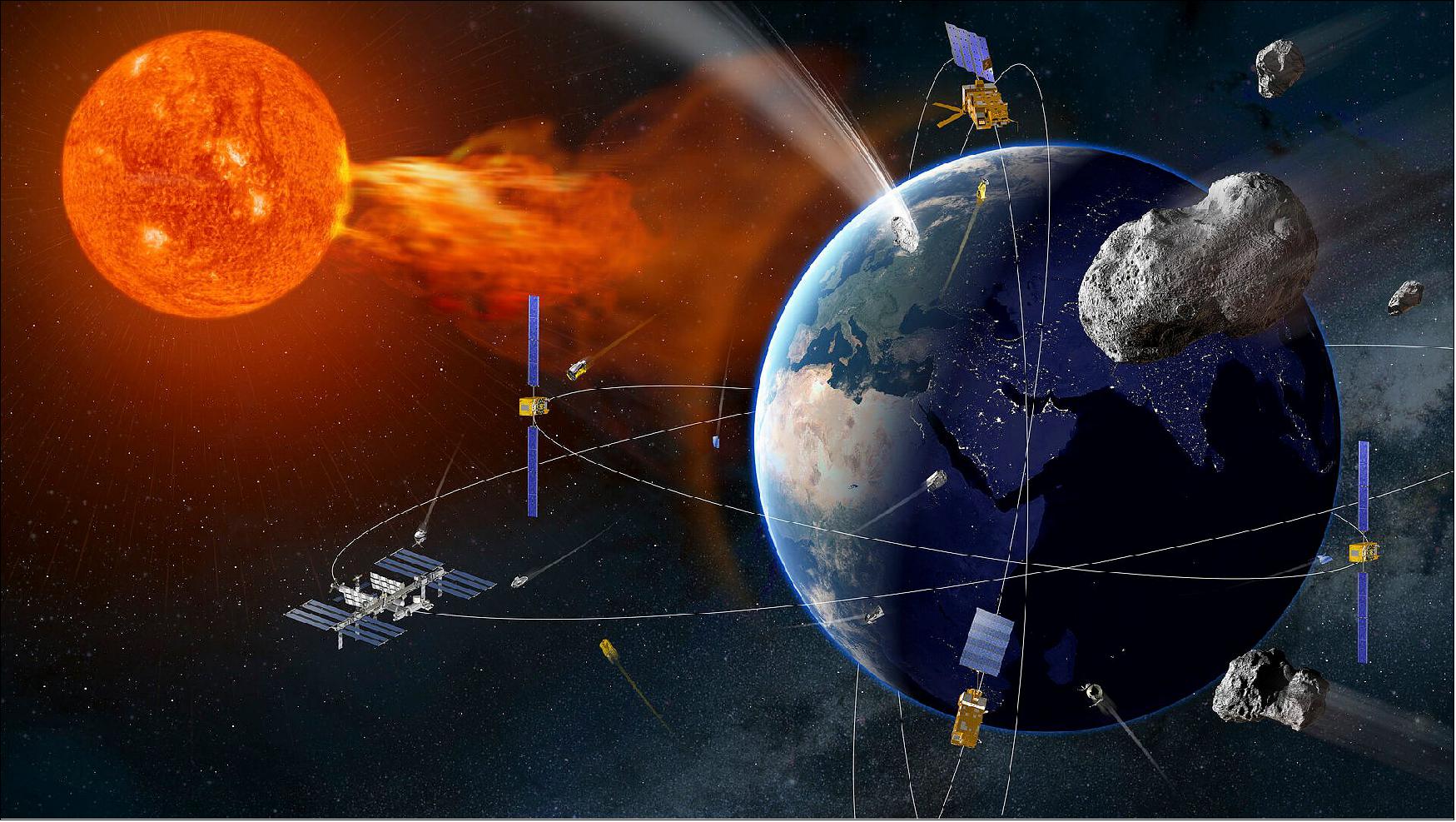
• June 2, 2020: Queen guitarist and astrophysicist Brian May has teamed up with asteroid researchers to investigate striking similarities and a puzzling difference between separate bodies explored by space probes. The research team ran a supercomputer-based ‘fight club’ involving simulated large asteroid collisions to probe the objects’ likely origins. Their work is reported in Nature Communications. 23) 24)
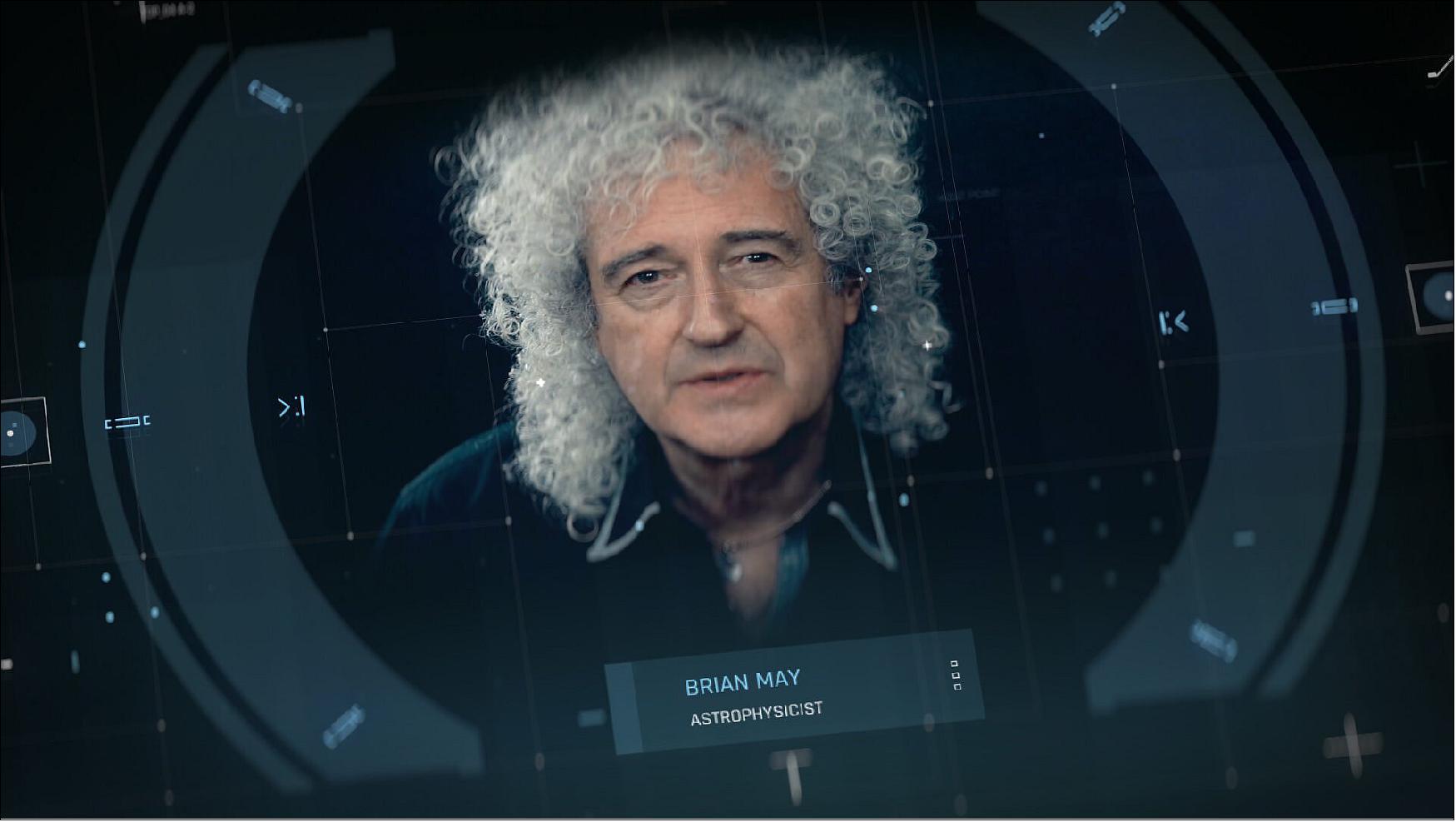
- Both the 525-m diameter Bennu asteroid visited by NASA’s OSIRIS-REx and 1-km diameter Ryugu asteroid reached by Japan’s Hayabusa2 possess the same distinct spinning-top shape and similar material densities. However the pair contain differing amounts of water, as revealed in spectral mapping of hydrated materials. Ryugu appears weakly hydrated compared to Bennu, despite being a comparative youth in asteroid terms, estimated at a mere 100 million years old.
- “The shapes of asteroids and their hydration level can serve as real tracers of their origin and history,” says co-author Brian May.
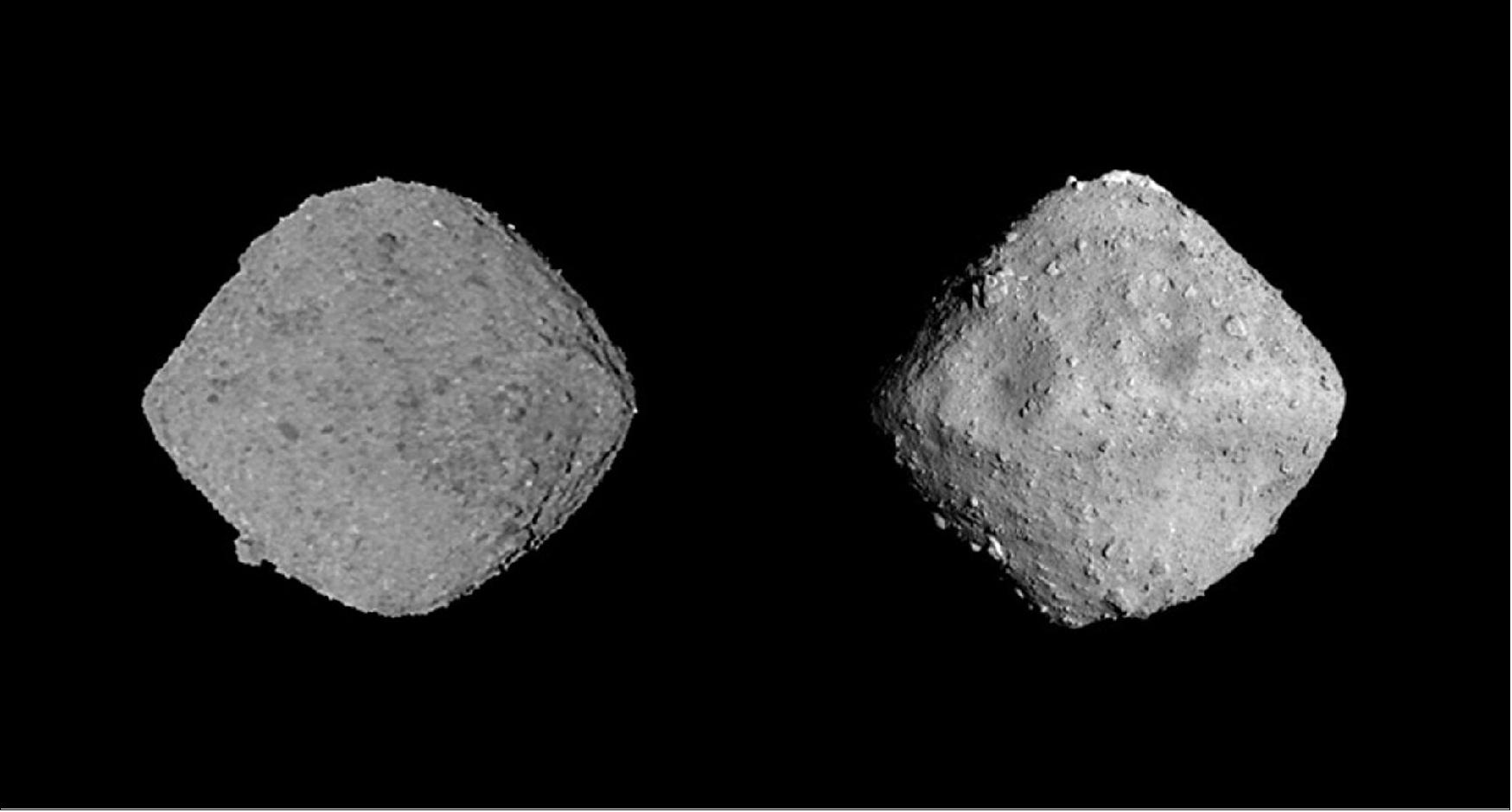
Spinning-top-shaped Mystery
- The study was led by Patrick Michel, CNRS Director of Research of France’s Côte d'Azur Observatory, also lead scientist of ESA’s Hera mission for planetary defence. He notes that this research also has relevance for Hera, which will explore the Didymos binary asteroid system following the orbital deflection of the smaller of the two bodies by NASA’s DART spacecraft.
- “This spinning top shape of Bennu and Ryugu – including a pronounced equatorial bulge – is shared by many other asteroids, including the primary 780-m Didymos asteroid,” explains Patrick.
- “A leading hypothesis has been that a high rate of spin leads to centrifugal force changing their shape over time, as material flows from the poles to the equator. Such a spin can be built up over time by the gradual warming of sunlight – known as the Yarkovsky–O'Keefe–Radzievskii–Paddack (YORP) effect, named after four different asteroid researchers.
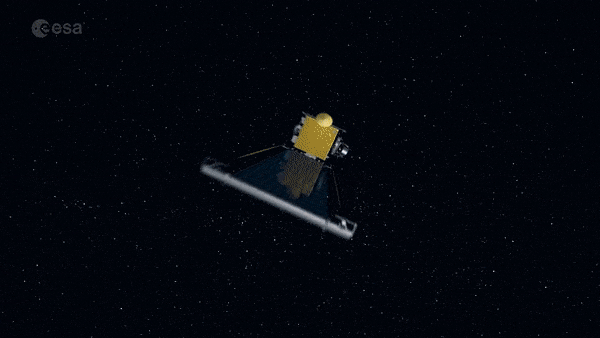

- “For Didymos, this might explain where Didymos A’s smaller moonlet came from – forming out of material that broke free of the fast-spinning equator. In the case of Bennu and Ryugu there is a problem however: close-up inspection by their respective spacecraft has revealed large cratering on their equatorial ridges, suggesting these features formed very early in the asteroids’ history.”
- The findings posed a question, explains co-lead author Ron Ballouz of the Lunar and Planetary Laboratory at the University of Arizona: “Are these properties – asteroid shape, density, more or less high hydration levels – the consequence of the evolutions of these objects, once formed, or the immediate outcome of their formation?”
Step Back in time with Supercomputer Simulations
- As a way of looking back in time, the researchers ran numerical simulations of 100-km class asteroids being disrupted by collisions, releasing plentiful fragments that gradually reformed into aggregate bodies – believed to be the way that most asteroids larger than 200 m have been formed.
- The simulations were run using the Bluecrab supercomputer cluster operated by the Maryland Advanced Research Computing Center, through the Johns Hopkins University and University of Maryland.
- “The simulation runs were extremely computational intense, and took several months to perform,” adds Patrick Michel. “The most challenging part was simulating the re-accumulation process, which included detailed coding for particle contact including rolling, sliding and shear friction. We also looked at the heating level of the post-impact fragments, determining their hydration level.
- “What we found was, while the re-accumulation process led to a wide variety of shapes, there is a tendency towards a spinning-top because the aggregating material can be captured in a central disc and eventually forms a spinning top or at least a re-accumulated spheroid. This spheroid can then be spun up by the YORP effect to form an equatorial bulge in a rapid timescale in asteroid terms, of less than a million years, explaining what we see on Bennu and Ryugu.”
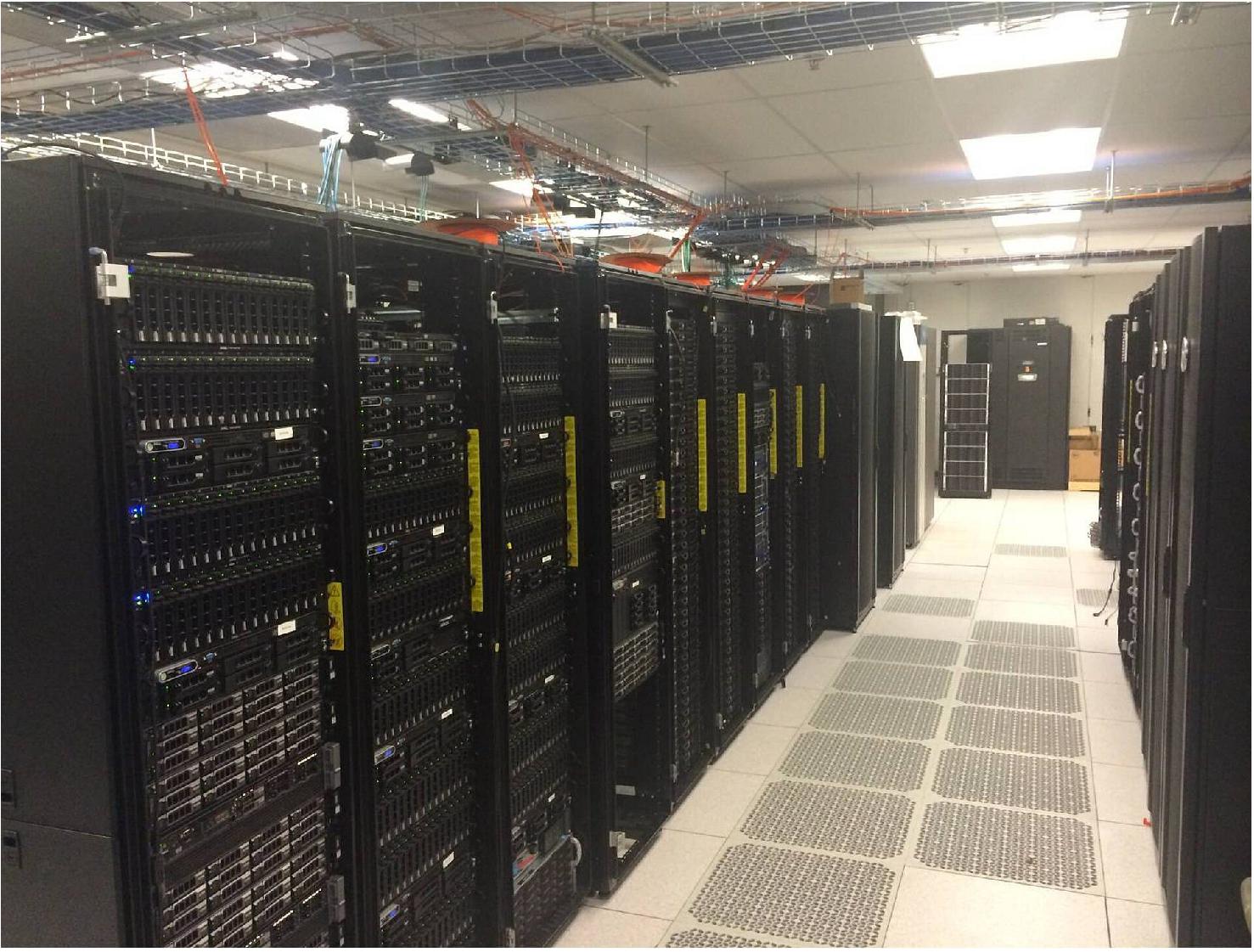
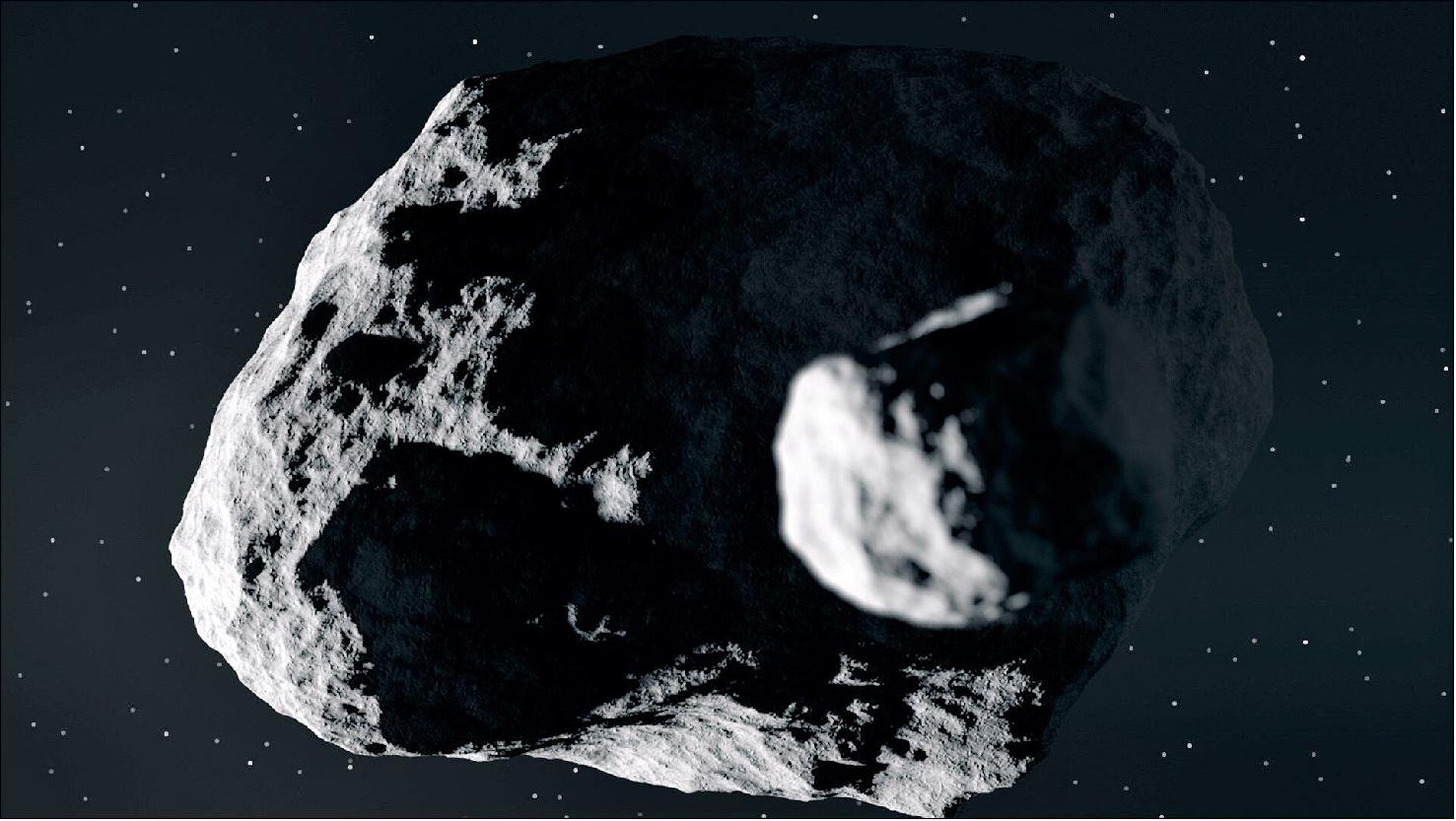
- The team’s other finding is that final hydration levels can vary markedly among the aggregates formed by the disruption of their parent body. Brian May worked with Claudia Manzoni of the London Stereoscopic Company to produce stereogram 3D images of the immediate aftermath of impacts, revealing individual fragments show a broad diversity in heating levels, and therefore hydration.
- “During a collision, it is thus possible to form an aggregate like Bennu, that experienced little impact heating, and another with more heated material, such as Ryugu” explains Brian May.
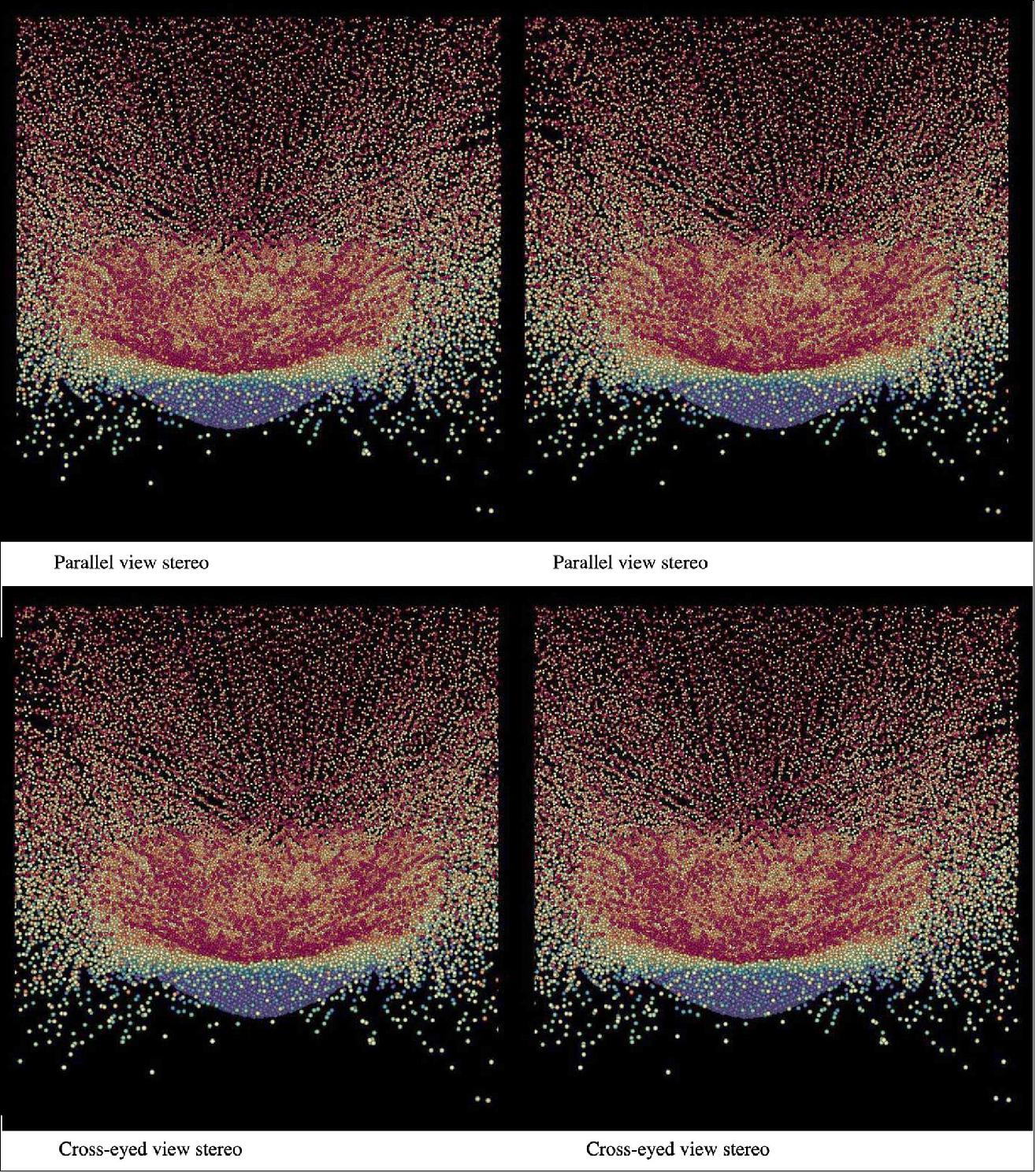
Asteroid Family Trees
- Patrick Michel adds: “The upshot is that Bennu and Ryugu might actually be part of the same asteroid family, originating from the same parent, despite their very different hydration levels now. We know they come from the same region of the Asteroid Belt, which makes this more likely, although we will only know for sure when we can analyze the asteroid samples due to be returned by Hayabusa2 and OSIRIS-REx.”
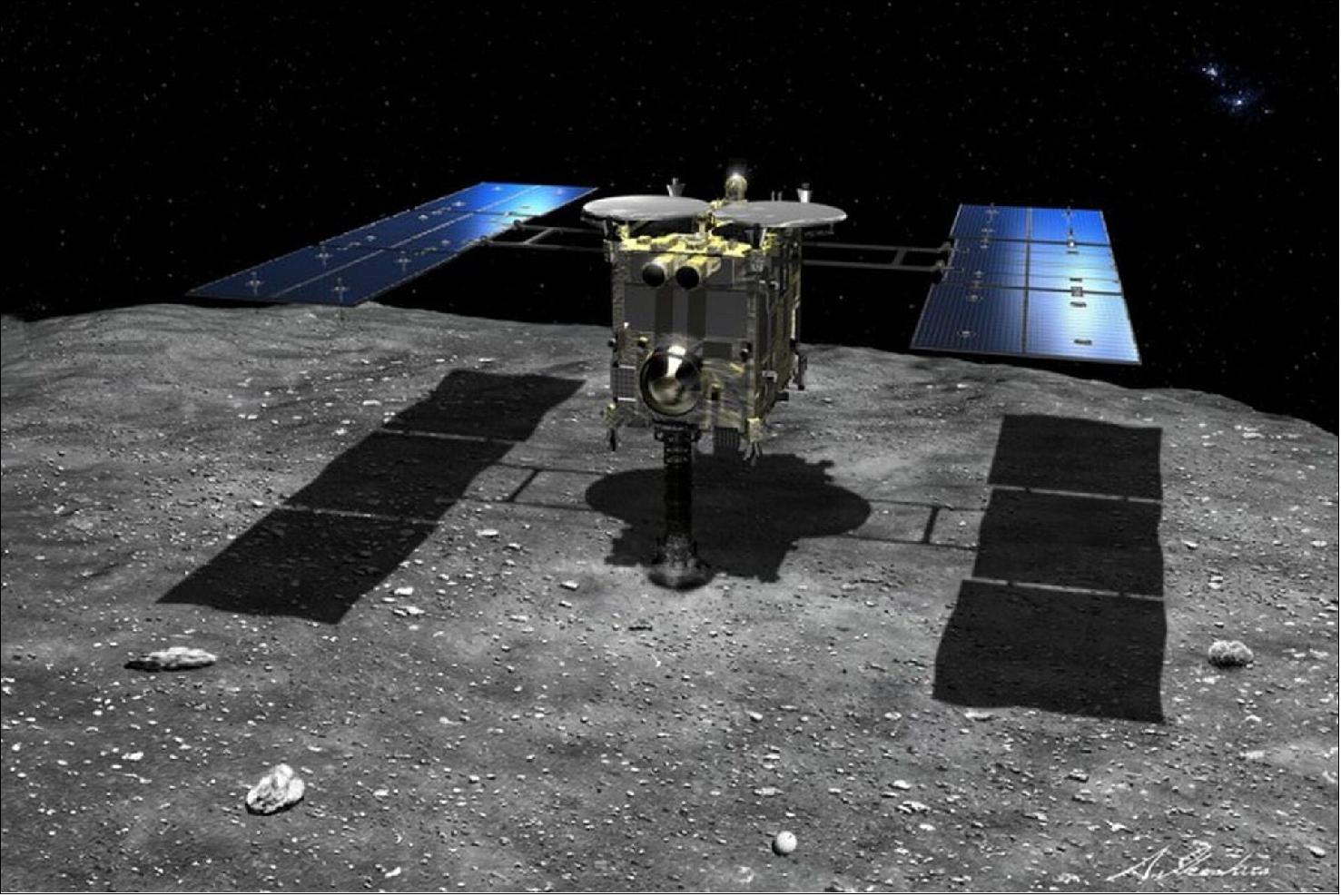
- Brian May’s involvement came out of his asteroid research activities, including working on the Hayabusa2 and OSIRIS-REx science teams and as a member of the Advisory Board of the Near-Earth Object Modelling and Payload for Protection (NEO-MAPP) project, funded by the H2020 program of the European Commission.
- This month, ESA is celebrating the UN-recognized Asteroid Day, to inspire the world about asteroids and their role in the formation of our solar system, how we can use their resources, how asteroids can pave the way for future exploration and how we can protect our planet from asteroid impacts. More information, and a month of programming, via asteroidday.org.
• April 15, 2020: A test of the automated navigation system being developed for ESA’s Hera mission. A space-grade camera is imaging a model binary asteroid system in dark conditions, representative of deep space illumination. 25)
- Hera will be humankind’s first probe to rendezvous with a binary asteroid system, a little understood class making up around 15% of all known asteroids. NASA will first perform a kinetic impact on the smaller of the two Didymos asteroids, then Hera will follow-up with a detailed post-impact survey will turn this grand-scale experiment into a well-understood and repeatable planetary defense technique. Being able to deflect the orbit of an incoming body in this way could one day help prevent a devastating strike on Earth.
- This ‘hardware-in-the-loop’ testing is being performed by GMV in Spain, responsible for developing the Hera mission’s guidance, navigation and control system. To see more, watch GMV’s video.
• November 29, 2019: Europe’s space ministers gathered at Space19+ in Seville, Spain in November 2019 have approved ESA’s Hera asteroid mission for construction and launch, as part of the Agency's broader planetary defence initiatives that aim to protect European and world citizens. 26)
- Hera will be humanity's first-ever spacecraft to visit a double asteroid, the Didymos binary system. First, NASA will crash its DART spacecraft into the smaller asteroid - known as Didymoon - before ESA's Hera comes in to map the resulting impact crater and measure the asteroid's mass. Hera will carry two CubeSats on board, which will be able to fly much closer to the asteroid's surface, carrying out crucial scientific studies, before touching down. Hera's up-close observations will turn asteroid deflection into a well-understood planetary defence technique.
• November 26, 2019: Amateur astronomers around the world are being asked to help the proposed ESA asteroid mission. As well as exploring its final destination – the Didymos binary asteroid system – the Hera spacecraft could potentially fly past one or more bodies on the way. But the mission team require additional observations to help select their targets. 27)
- “Asteroid research is one area of astronomy where amateur observers continue to make an essential contribution,” says Prof. Alan Fitzsimmons of Queen's University Belfast, part of the Hera investigation team.
- “The flyby candidates we have identified so far are little more than tiny dots of light in the sky, so faint they are invisible to the naked eye. We need as much help as possible to refine their orbits and measure their properties, which could give clues to their characteristics in advance of Hera’s launch.”
- The flyby opportunity arises because Hera will be headed out to match Didymos’s 770-day orbit around the Sun, which circles from less than 10 million km from Earth to out beyond Mars, at more than double Earth’s Sunward distance. In the process Hera will pass multiple asteroids and the inner edge of the main Asteroid Belt.
- ESA/ESOC has come up with a flyby shortlist, explains ESA’s Hera project scientist, Michael Küppers: “For a 2-5 km asteroid employing Hera’s main Asteroid Framing Camera, we would aim for a flyby distance of 500 km – but close approaches without real flybys are still useful, as they allow asteroid observations from angles unachievable from Earth.”
- The precise targeting will come right down to the day of launch, how much fuel remains after fine-tuning Hera’s trajectory to Didymos, and how accurately it will be possible to refine the potential flyby targets’ orbits. The amount of fine-tuning will also be dependent on the Ariane 6 launcher which will place Hera onto its interplanetary trajectory.
- From ESOC’s full set of flyby possibilities Prof. Fitzsimmons and the Hera investigation team have come up with an initial list of seven candidate asteroids they would like amateur astronomers to observe.
- “Only three of these bodies have known diameters and albedos, or surface brightness,” adds Prof. Fitzsimmons. “And none of them have known rotation periods – this is something experienced amateurs could try and measure for us, especially for the brighter objects.”
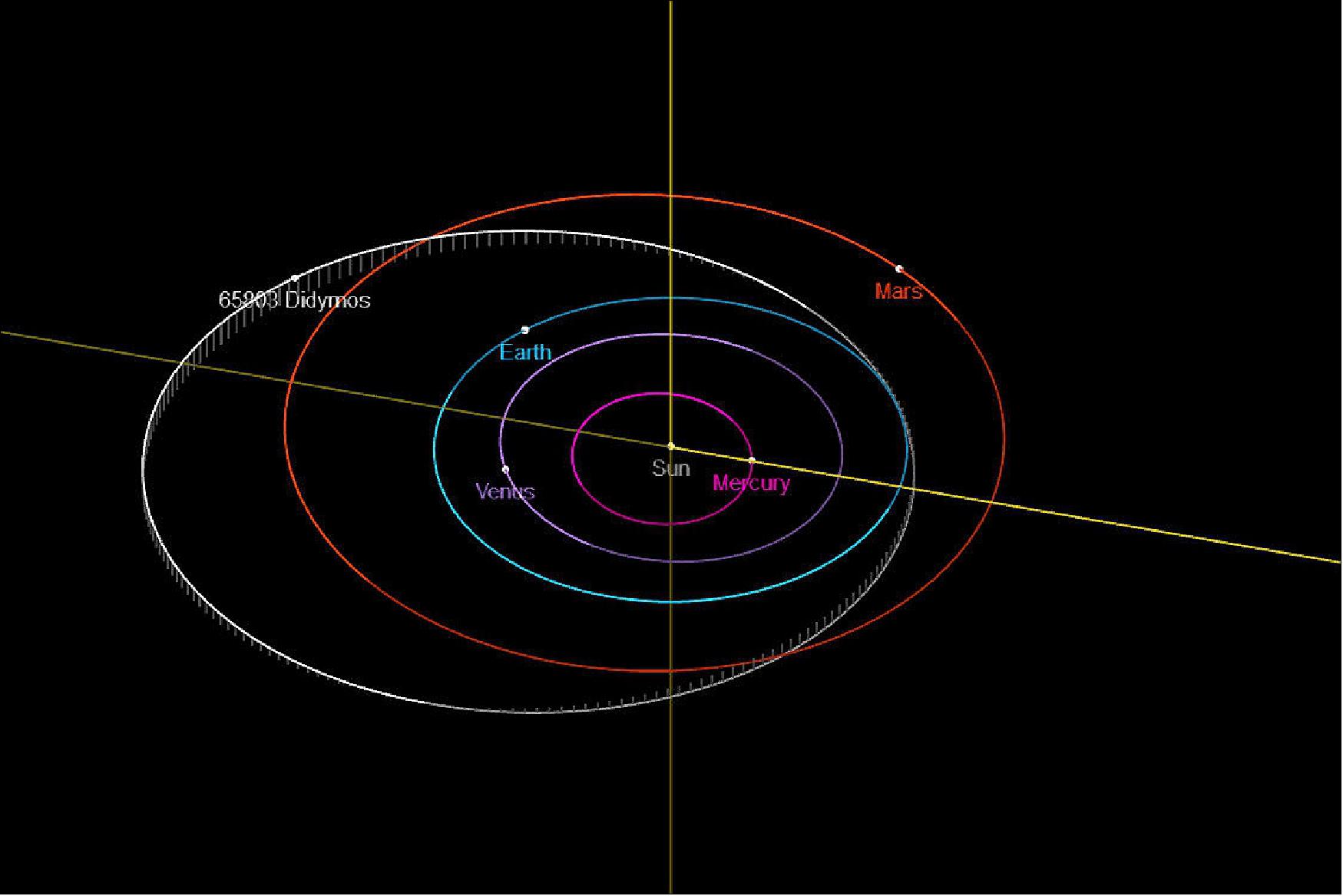
- ESA’s first experience with asteroid flybys came during Europe’s Rosetta mission, when the comet chaser passed two Main Belt asteroids in 2008 and 2010, giving the spacecraft an early opportunity to try out its suite of scientific instruments ahead of reaching comet 67P Churyumov–Gerasimenko in 2014.
- But Rosetta was a lorry-sized spacecraft on a 10-year cruise phase with multiple planetary flybys, while Hera will be only the size of a desk, headed on a more straightforward route through deep space for a little over two years.
- So any additional asteroid encounter cannot be taken for granted, but would be a scientifically valuable extra. And the entire amateur astronomer community can help select potential flyby targets.
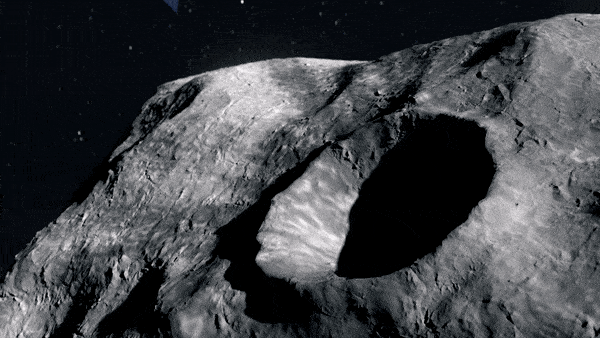
• November 22, 2019: The Planetary Society, the world's largest independent space interest organization, issued the following statements in support of the proposed European Space Agency (ESA) mission, Hera: 28)
- "Defending the Earth from asteroid impacts is, by definition, a global effort. The European Space Agency, in addition to supporting ground-based observations of near-Earth objects, has the opportunity to partner with NASA to validate asteroid deflection technology—a critical capability for preventing devastating impacts.
- ESA's proposed Hera mission would complement NASA's Double Asteroid Redirection Test (DART) mission by providing precise measurements that would refine our understanding of the effectiveness of impact deflection methods. Never before has humanity validated this capability with a real asteroid system.
- Hera would increase confidence in humankind's ability to deflect a threatening asteroid. It is affordable and timely. It addresses a fundamental issue related to the safety and security of the human species. In addition to asking our members in Europe to sign an open letter of support for Hera, The Planetary Society official urges ESA's member states to embrace and prioritize this important mission."
• November 5, 2019: Having spent much of the 21st century developing planetary defence techniques, Apollo astronaut Rusty Schweickart is a strong supporter of ESA’s proposed Hera mission. In general, when it comes to asteroid deflection, he says, two spacecraft are better than one. 29)
- “For asteroid deflection by kinetic impact, we stopped talking about a single deflection mission and we’ve started talking about a deflection campaign instead, based on an observer spacecraft as well as the impactor spacecraft,” explains Schweickart, who became the first astronaut to fly the Lunar Module during the Apollo 9 mission in March 1969.
- After departing NASA, Schweickart remained active in the space arena, working with cosmonauts to establish the Association of Space Explorers. Then in 2002 he helped found the B612 Foundation, devoted to saving Earth from asteroid impacts – its name taken from the planetoid in children’s classic The Little Prince.
- Now, after years of patient research and advocacy, the first practical test of planetary deflection is going to happen. NASA’s DART (Double Asteroid Redirect Test) will slam into the smaller of the Didymos binary asteroids in late 2022. Then – if approved at ESA’s Space19+ gathering of Europe’s space ministers in late November – ESA’s Hera mission will perform a close-up survey of the asteroid and human-made crater after impact.
- He explains: “With Hera we’ll be able to validate a significant proportion of what an operational observer spacecraft would do: for instance, find out how precisely we can determine the post-impact orbit – what is the level of accuracy we’re going to achieve?
- “And one of the key unknowns of the kinetic impactor technique is a term we call ‘beta’ – when we hit the asteroid, how much stuff is going to come flying off? If it’s moving at greater than escape velocity, then that adds to the momentum shifting the orbit, boosting the technique’s effectiveness. That factor depends on the asteroid’s composition and structure, and we need a close-up look to find out what that is.”
Spotting a Space Rock with the Naked Eye
- Schweickart recalls one semi-close encounter with a space rock: “During the Apollo 9 mission we were dark-adapted for an experiment, looking at the spectacular night-time Earth, watching weather fronts, thunder storms and lightning, a really great sight out of the window. Then, who knows who said it first, but one of us said they saw a little flash down there and someone else says ‘yeah, I saw it too,’ but you wouldn’t have mentioned it if the first person hadn’t said it.
- “And then we realized: that was a meteor, burning up below us. Wow, below us – which meant it came down through our altitude!”
- He ascribes his current interest in planetary defence to the rise of astrobiology in the 1990s, which included a focus on the earliest possible life on Earth. “One of the related questions was the impact history of Earth, and the incredible levels of energy released by these asteroid strikes.”
- That led in turn to a natural follow-up discussion: “We’re discovering more and more asteroids, and if we find one headed our way, what can we do? Is technology at a point where there’s anything we can do? The answer was a tentative yes, so we formed the B612 Foundation to advance the idea of deflecting asteroids.
Changing the Orbit of an Asteroid
- “We came up with our Kennedyesque statement that we were going to change the orbit of an asteroid in a controlled way. It’s a straightforward enough goal but the orbital mechanics are really a non-trivial element, because it’s a multi-body problem, involving the asteroid plus Earth and other planets in solar orbit.
- “Being an astronaut, and in particular working on early rendezvous techniques, was important for understanding the orbital dynamics. There are areas in space called ‘keyholes’ where asteroid orbits are shifted by the influence of Earth and other planets, and most bodies that strike Earth will have passed through such keyholes. In astronautic terms it’s like they undergo a burn, a change in velocity.”
Hit Hard or Pull Softly
- While on the one hand emphasizing the importance of early detection, on the other the B612 Foundation examined various deflection approaches. Kinetic impact is the current baseline method, but less violent techniques are also under consideration, such as a ‘gravity tractor’ which involves flying a spacecraft close enough to an asteroid so its gravitational attraction gradually pulls the body off course.
- As opposed to the experimental DART-Hera test, in an operational version of a deflection campaign the observer spacecraft would ideally reach the target asteroid first. As Schweickart notes: “The first thing to do is for it to observe the orbit with very high accuracy and then nine times out of ten find out it’s not going to hit Earth at all.
- “Or, if the impact probability remains unacceptably high, the kinetic impactor is launched and the observer spacecraft watches the impact from a safe distance, then comes back to make a precise determination of the new orbit, to check if the deflection is successful, or maybe it has actually nudged the asteroid towards another keyhole, risking an eventual collision.
- “In that case the observer spacecraft would have another job to do – to switch to gravity tractor mode, using altimeters and ion engines to stay just away from the asteroid, and nudge its orbit enough to miss the keyhole as well as the planet.”
A Planetary Decision
- If the technical challenges today seem just about surmountable – with sufficient early warning – Schweickart says the larger geopolitical issues are still to be considered. Deciding to mount an asteroid deflection would be a huge decision, needing debate on a planetary scale. “Who, for instance, decides how high the impact risk has to be before we launch? Is it one in 20? How about one in 12, one in 10? The Association of Space Explorers has been working to get the world community to look at this.”
- So operational asteroid deflection campaigns will most likely be international in nature, as this first experiment will become, if a European spacecraft does indeed follow the US impactor mission to Didymos.
• October 4, 2019: The logo for Hera, ESA’s proposed asteroid mission for planetary defence, has already reached space, thanks to ESA astronaut Luca Parmitano, who snapped this photo from the cupola of the International Space Station. The Hera mission itself is seeking final approval for development at the Space19+ Ministerial Council this November. 30)
- “The Hera team welcomes this high-profile appearance,” says Ian Carnelli, managing Hera. “The next time our logo will get anywhere near this high would be for its initial moments of flight, covering the fairing of its Ariane 6 launcher.”
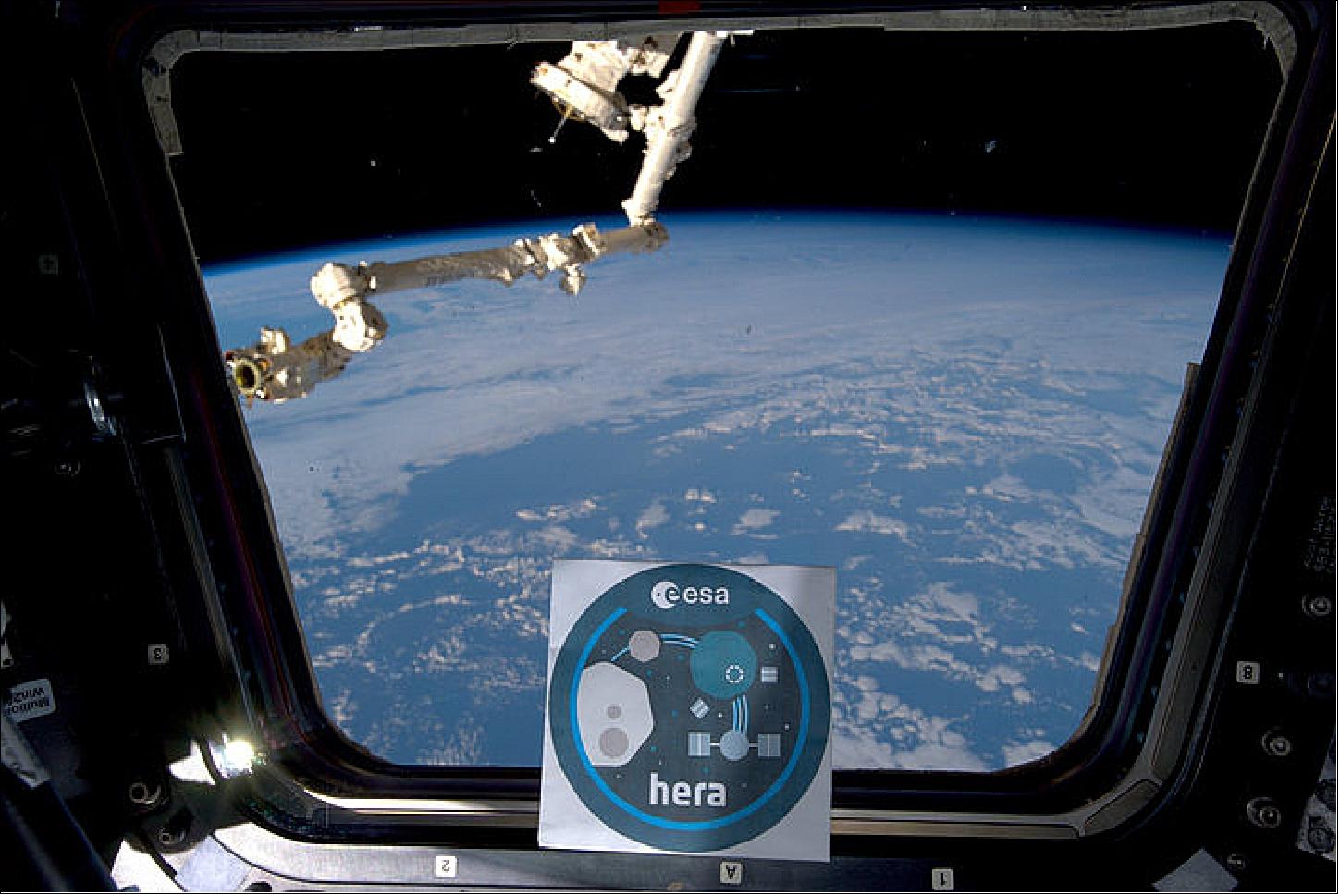
- Part of ESA’s new Space Safety program, Hera is planned as Europe’s contribution to an audacious planetary defence experiment. In the summer 2022, NASA’s DART mission will impact the smaller of the Didymos binary asteroids, in an attempt to deflect it.
- Hera would then perform a detailed post-impact survey of the deflected body, measuring its mass and the size and shape of the crater left by DART, to turn planetary deflection into a well-understood technique that could be performed against various scales of targets if ever needed to actually defend Earth.
- “Asteroids hold unique information about Solar System formation and ultimately about our own origins,” comments Luca. “They are tracers of Solar System formation where collisions played a fundamental role.
- “Understanding the impact processes at scales beyond what is achievable in laboratories provides important clues on the evolution of the Solar System, including our own planet. It is fascinating to think that the same science can protect our planet from asteroid impacts.”
- The Hera logo summarizes key goals of the Hera mission: protection from asteroid impact, modelling binary asteroid systems, preventing asteroid collisions and developing new technology – including the two CubeSats the spacecraft will deploy to perform close-up surveys.
• August 13, 2019: We have learned a lot from visiting the Moon, and even more from visiting other planets, but what about the thousands of other small objects that share our Solar System? Space agencies have sent several spacecraft to asteroids, comets, dwarf planets and small moons, and have ambitious plans to send more in the future. 31)
- Asteroids and comets are believed to be leftover debris from the formation of the Solar System, meaning they can help trace its history. What’s more, these objects may have played a vital role in the development of our planet and terrestrial life by colliding with Earth in catastrophic impact events, bringing life-sparking organic compounds. Such collisions were more common in the early Solar System, but small objects can still impact Earth, damaging life, nature and infrastructure.
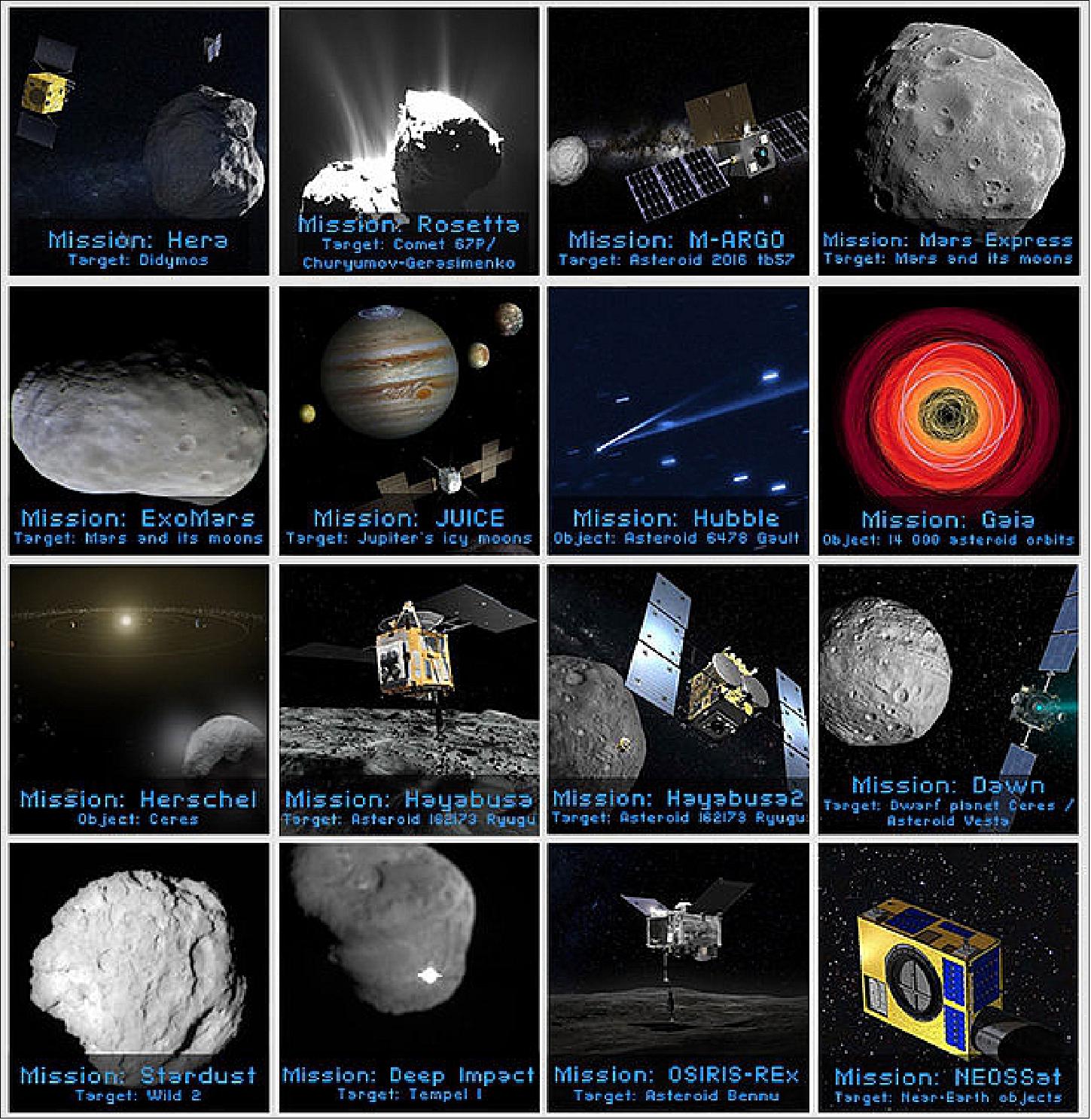
- Such objects may also have brought organic matter to other planets and moons, some of which – Jupiter’s moon Europa or Saturn’s moon Enceladus, for example – may possess the right conditions for hosting some form of life. For all these reasons, and many more, it is important to study these objects and find out more about them.
Discovery & Preparation Activities
- Laying the groundwork for ESA’s future activities, Discovery & Preparation supports exploratory research into new concepts. Several Discovery & Preparation studies have investigated different elements of possible future missions to explore small extraterrestrial objects.
- Asteroids and comets whose orbits come close to or even cross that of Earth are known as near-Earth objects (NEOs), and they can pose an impact threat. To mitigate this threat, the first step is to search for NEOs and map their orbits. Discovery & Preparation supported a study that explored using star trackers – already on board many spacecraft for orientation calculation – to search for NEOs.
- Another challenge we face from extraterrestrial objects is that dust on their surfaces may affect visiting spacecraft, landers and astronauts. The Dusty Plasma Environments study was the first step in developing a set of models that could assess the effects of dusty plasma on future exploration units.
- Recent exploration probes and rovers host mini laboratories for in-situ research, but sophisticated laboratories on Earth can perform even more advanced tests. One Discovery & Preparation study explored how to set up a facility on Earth that could safely handle such precious and potentially hazardous samples that were brought back from these space rocks. The investigation was based on previous Mars sample return facility studies.
- Another study explored how to land safely on a low-gravity object. It was carried out primarily by the German Aerospace Center (DLR), who developed the MASCOT lander for the Japanese Hayabusa2 asteroid mission. The study looked into developing a second lander, MASCOT-2, designed to land on Didymoon – the target of ESA’s proposed Hera mission.
- Hera will host two CubeSats that will be able to get closer to Didymoon. Being versatile, small and relatively cheap, many Discovery & Preparation studies have investigated how CubeSats could be used to explore smaller space objects. Several of these studies focused specifically on Hera’s companions.
- A very forward-thinking study even explored how astronauts could use ESA’s Neutral Buoyancy Facility to train for trips to these interplanetary objects, where gravity would be present but very weak. More Discovery & Preparation activities focusing on asteroids, comets and moons can be found in the Nebula Library of studies.
ESA-wide Activities
- Now a fully-fledged proposed mission, Hera falls under ESA’s Space Situational Awareness (SSA) initiative, which enables Europe to detect, predict, and assess the risk of NEOs. The SSA NEO Segment (SSA-NEO) observes NEOs, predicts their orbits, produces impact warnings when necessary, and is involved in potential mitigation measures.
- Now a fully-fledged proposed mission, Hera falls under ESA’s Space Safety activities, which enable Europe to understand and minimize the dangers of risky asteroids, extreme solar events and space debris. The Planetary Defence Office observes near-Earth objects, predicts their orbits, produces impact warnings when necessary, and is involved in potential mitigation measures.
- ESA also made history by orbiting a comet with the Rosetta mission. Remaining with Comet 67P/ Churyumov-Gerasimenko for over two years, Rosetta found out a plethora of information about periodic comets, and even released a lander to get closer to the surface of this mysterious object.
- Next, ESA has its eyes on an asteroid. The Agency recently signed a contract with GomSpace Luxembourg SARL to design the first ever nanosatellite to rendezvous with an asteroid. The Miniaturized Asteroid Remote Geophysical Observer (M-ARGO) will be a 12-unit CubeSat with its own propulsion system. This is being funded though ESA’s General Support Technology Program (GSTP), which is also supporting updates to a tool that will support future ESA lander missions by modelling surfaces of small bodies in our Solar System and providing photo-realistic images.
- ESA is already involved in asteroid research, through testing three grains of rock brought back from asteroid Itokawa by Japan’s Hayabusa mission. This is contributing to our knowledge about the surface environment of asteroids.
- Planetary missions are also contributing to our understanding of extraterrestrial objects. Whilst orbiting Mars with Mars Express and the ExoMars Trace Gas Orbiter, ESA observed Mars’ moons, Phobos and Deimos. Moving further afield, The JUpiter ICy moons Explorer (JUICE) mission will investigated three of Jupiter’s largest moons – Ganymede, Europa and Callisto – to determine whether any of them may be habitable.
- But we don’t necessarily need to get close to these objects to learn about them. ESA’s space telescopes, including Hubble, have photographed numerous small bodies throughout the Solar System to discover more about their characteristics and orbits. Hubble recently captured an image of a rare self-destructing asteroid, Gaia collected information on more than 14 000 asteroids, Herschel discovered water vapor around dwarf planet Ceres, and the Infrared Space Observatory discovered twice as many asteroids as were previously believed to exist.
What are other space agencies doing in this area?
- Aside from landing on two different asteroids with their Hayabusa and Hayabusa2 missions, JAXA is currently planning a mission to survey Mars’ two moons: Phobos and Deimos. The mission, Martian Moons eXploration (MMX), even plans to collect a sample from one of the moons and bring it back to Earth.
- NASA has also visited extraterrestrial objects in the past, with the Dawn mission being the first to orbit a dwarf planet – Ceres – and also visiting the biggest asteroid in the Asteroid Belt, VESTA. Dawn discovered that Ceres was previously an ocean world and found organic material. It also confirmed that Vesta is the source of many meteorites found on Earth.
- The US Stardust mission collected dust from comet Wild-2, which indicated that comets may have formed very differently than was originally believed. Deep Impact also visited a comet – Temple 1, crashing an impactor into the comet’s surface to expose materials such as water ice and organic matter. These results suggest that comets may have played an essential role in the initiation of life on Earth.
- Right now, NASA’s OSIRIS-REx spacecraft is orbiting an NEO. OSIRIS-REx plans to bring back a sample to Earth to support investigations into how planets formed and life began. The Canadian Space Agency (CSA) participated in OSIRIS-Rex by providing an instrument that is mapping the asteroid’s surface, allowing scientists to select a suitable sample site. CSA also developed the Near-Earth Object Surveillance Satellite (NEOSSat), dedicated to detecting and tracking asteroids that may someday pass close to Earth.
- And it’s not only space agencies that are involved in finding out more about NEOs – the European Southern Observatory (ESO) also dedicates time to this cause. Recently ESO’s Very Large Telescope imaged a double asteroid that came close to Earth. This provided a good opportunity to rehearse how space organizations would work together if a hazardous NEO ever threatened Earth directly. The project was coordinated by the International Asteroid Warning Network (IAWN), a collaboration between many space organizations aiming to protect Earth from NEOs.
• June 28, 2019: ESA’s Hera mission for planetary defence, being designed to survey the smallest asteroid ever explored, is really three spacecraft in one. The main mothership will carry two briefcase-sized CubeSats, which will touch down on the target body. A French team has been investigating what might happen at that initial instant of alien contact. 32)
- “We’ve customized an existing drop tower and rigged it up with a system of pulleys and counterweights in order to simulate a low gravity environment,” explains researcher Naomi Murdoch of the Institut Supérieur de l'Aéronautique et de l'Espace (ISAE-Supaero), part of the University of Toulouse.
- “We can go down to a few percent of Earth’s gravity within the test box that we place within the drop tower, containing a model lander and simulated asteroid terrain.
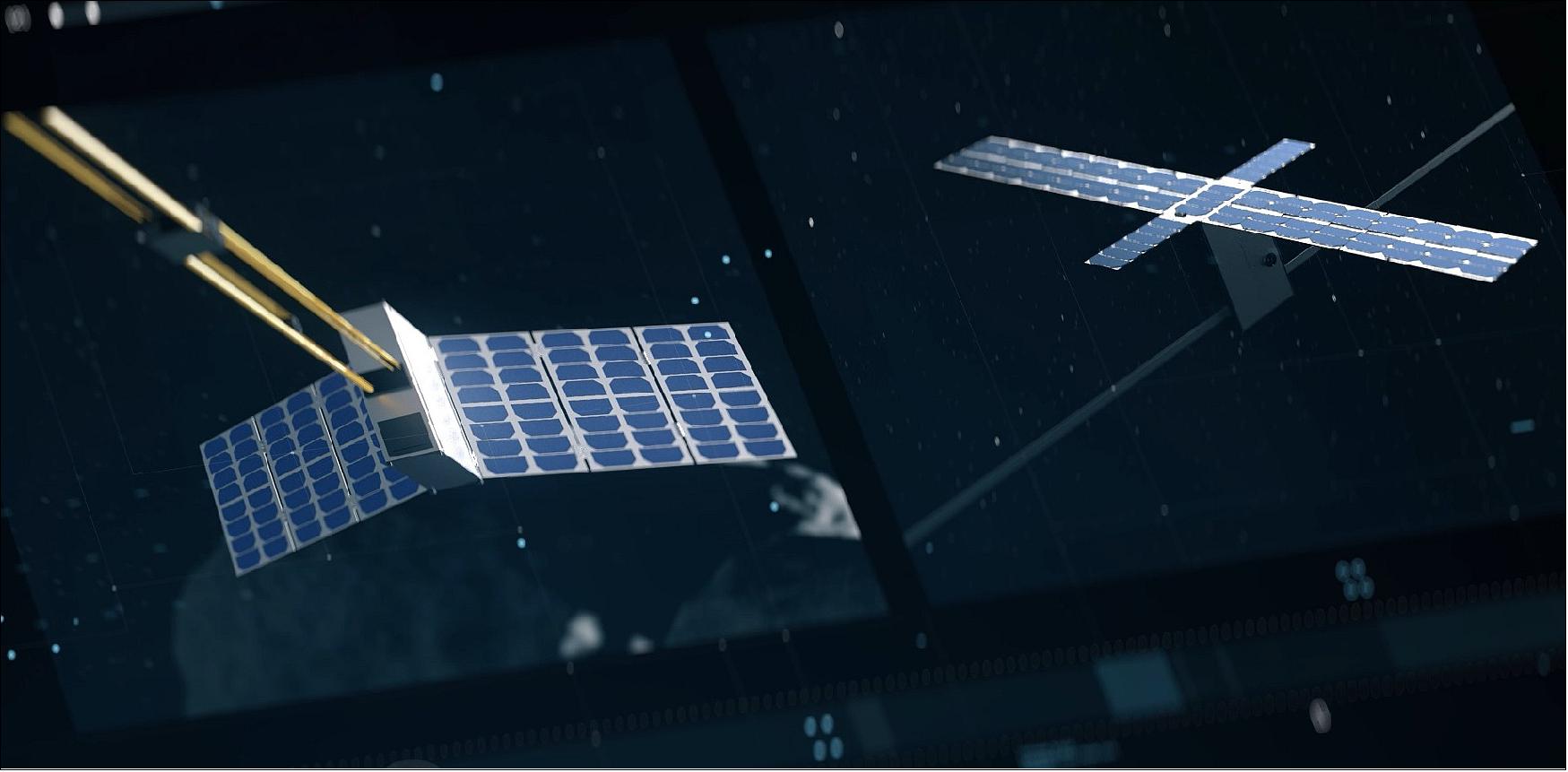
- “Our team started out with a spherical lander touching down on a sandy surface, but we’ve progressed to cubic shapes more representative of the actual CubeSats. We’ve also been studying the influence of different surface materials, and sought to understand how the landing process varies with different material properties, gravity levels and velocities.
- “This is necessary because each time we go to a different asteroid we end up surprised by what we find. For instance, Japan’s Hayabusa2, currently exploring the Ryugu asteroid, has found much scarcer ‘regolith’ dust and more boulders than researchers had expected.”

- Hera’s Juventas CubeSat will perform the first radar probe of an asteroid, while the APEX CubeSat will perform a multispectral mineral survey of its makeup.
- These two nanosatellites will fly closer to their target asteroid and take more risks than the main Hera spacecraft, and will both end up landing on the surface once their main mission goals are achieved.
- The pull of gravity involved is less than one hundred thousandth of Earth’s, far lower than can be reproduced by the ISAE-Supaero team. This means the touchdown itself will be more like a spacecraft docking than a traditional planetary landing.
- “Imagine, for instance, if the CubeSats are released 200 m from the asteroid surface, then they will take over an hour to cover that brief distance to the surface,” adds Naomi. “Everything moves in a kind of slow motion. Then there is also the possibility of bouncing off again.
- “The Rosetta comet-chaser’s Philae lander bounced off the surface of comet 67P/Churyumov–Gerasimenko repeatedly before finally coming to rest. Certainly if you were an astronaut on the surface you would have to walk with incredibly gentle steps to avoid leaving the surface and never coming back.”
- The hope is that both CubeSats survive their descent to return some observations, including close-up views of the surface material. But the main purpose of the ISAE-Supaero testing is to squeeze as much valuable data out of that initial moment of contact.
- “We’ve fitted our test lander with accelerometers similar to those that one of the Hera CubeSats will be carrying,” says Naomi. “We can see for example how the impact dynamics vary based on the material properties, from sand to large gravel, influencing how much we penetrate into the surface and how long the collision lasts.
- “And we are learning how results differ based on how the CubeSats land, whether they come down corner or face first – a face-down landing would give a higher peak acceleration. At the end of our testing we hope to have a set of data to better interpret the actual landings – and prove useful for understanding other missions’ interactions with asteroids as well.”
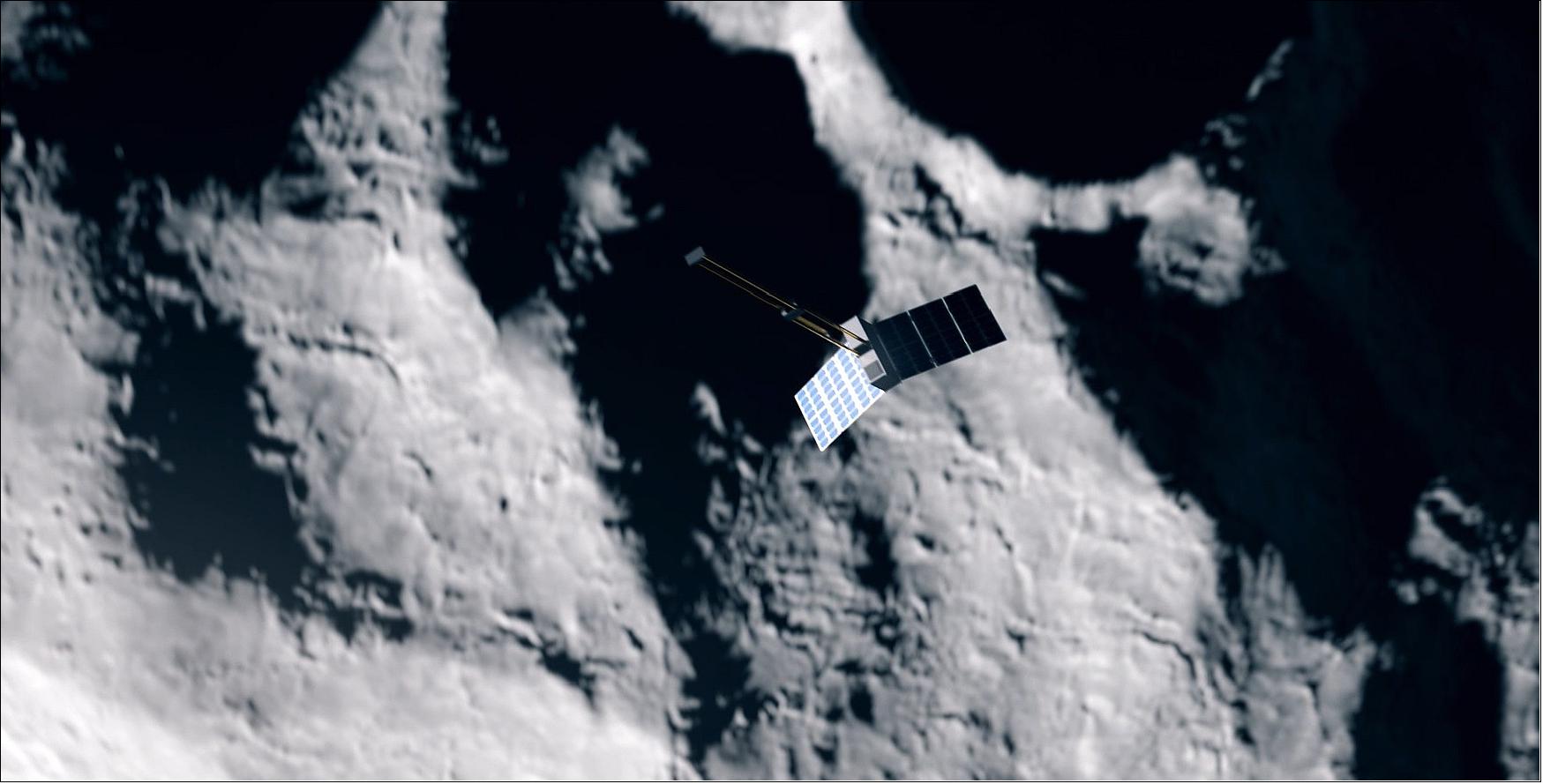
• June 11, 2019: At the heart of ESA’s Hera mission to the double Didymos asteroids will be an onboard computer intended to be failure-proof. Designed to operate up to 490 million km away from Earth and withstanding four years of harsh radiation exposure, Hera’s computer must run smoothly without locking up or crashing – on pain of mission failure, while pushing the limits of onboard autonomy. 33)
- Development of the Hera mission for planetary defence is taking place across Europe, to finalize a ready-to-build design to present to Europe’s space ministers at the Space19+ Ministerial Council this November. Hera’s onboard computer is being overseen by QinetiQ Space in Belgium, also the makers of the Proba family of technology-testing minisatellites.
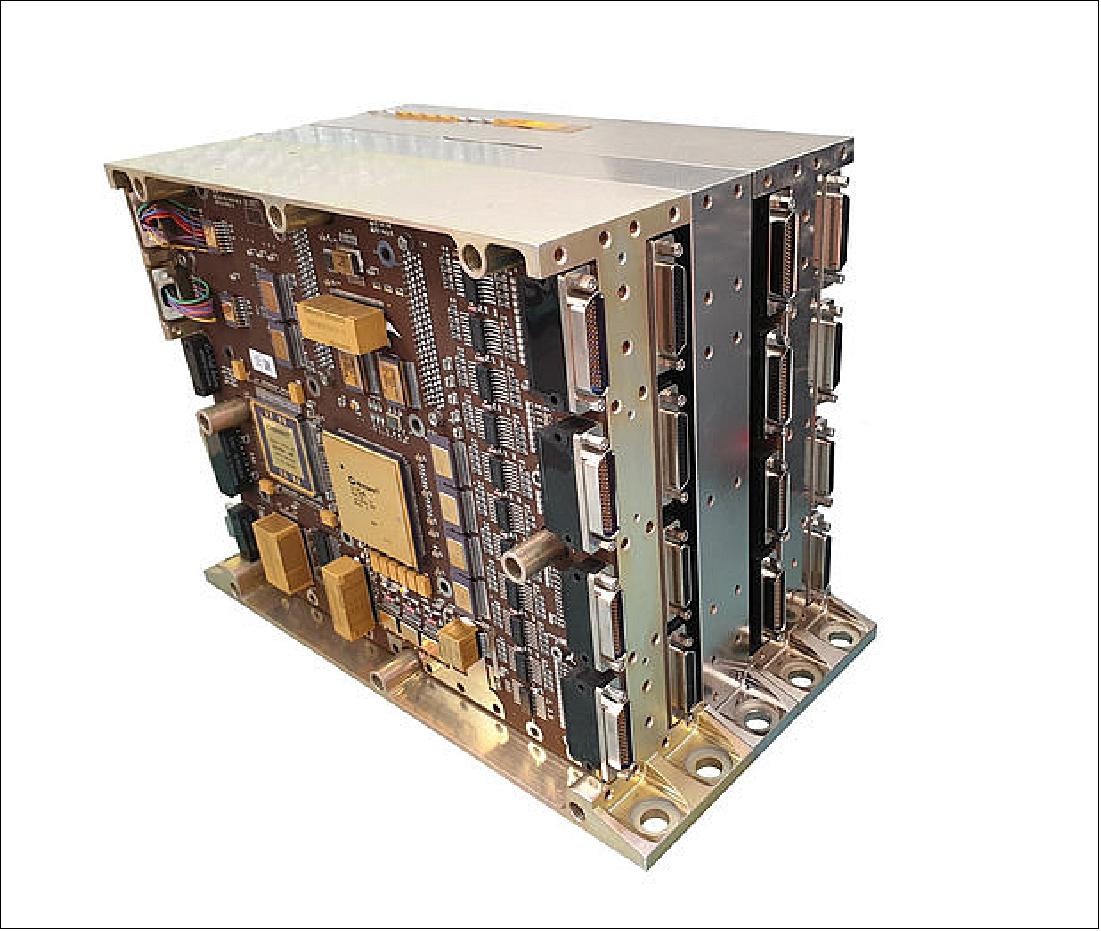
- Peter Holsters of QinetiQ Space explains: “A popular analogy is that if a satellite’s platform is like a bus – with the science-generating payloads like passengers on its seats – then the onboard computer is the driver of the bus. It is the brain of the entire mission, coordinating and operating the various onboard systems and payloads.”
Beyond Earth Orbit
- The challenge is that this particular onboard computer will be operating much further away than a typical mission in Earth orbit. In order to intercept the Didymos pair of near-Earth asteroids the desk-sized spacecraft will be venturing far into deep space, slightly beyond the orbit of Mars. - “Going so far away means operating in a different radiation environment for a start, which requires very careful component selection as well as specific software strategies,” adds Peter.
- Beyond the protection of Earth’s magnetic field, space is riddled with charged particles from the wider cosmos, as well as solar storms from our own Sun. These particles are energetic enough to pass through surface shielding to ‘flip’ individual memory bits – potentially corrupting computer memory – or do permanent damage called ‘latch-ups’, equivalent to tiny short circuits.
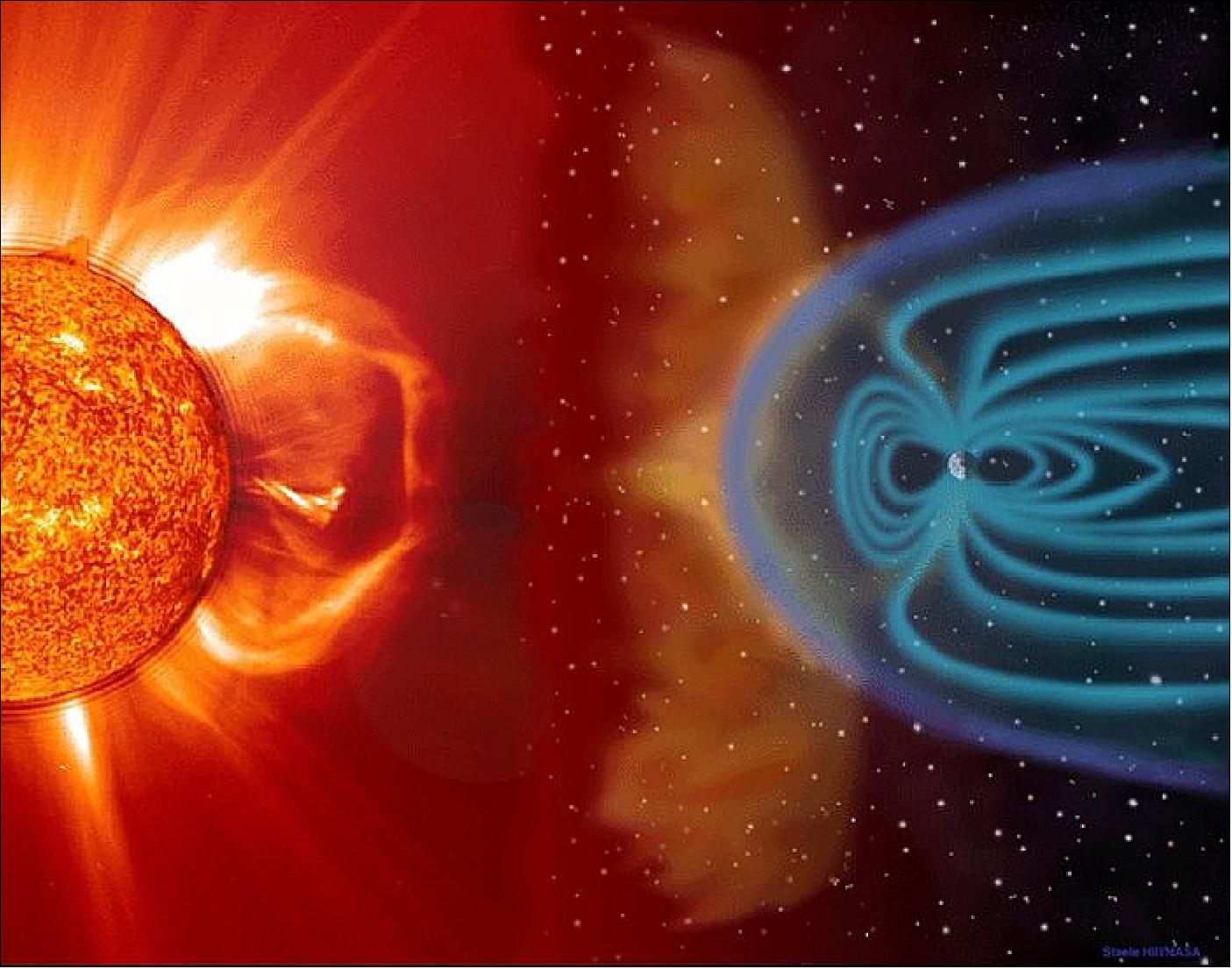
- “Our computers use flash memory – the same as in your own laptop or smartphone – but we perform rigorous radiation testing to ensure the batches we use meet the necessary performance standards,” adds Peter.
- “The next level of managing the problem is on the software side, with speedy error detection and checking in the memory management, including the ability to identify and work around ‘bad blocks’ in memory.”
- Venturing far from the Sun also means the onboard computer – like the spacecraft as a whole – will have to get by on less power than in its home planet’s orbit, as available sunshine shrinks.
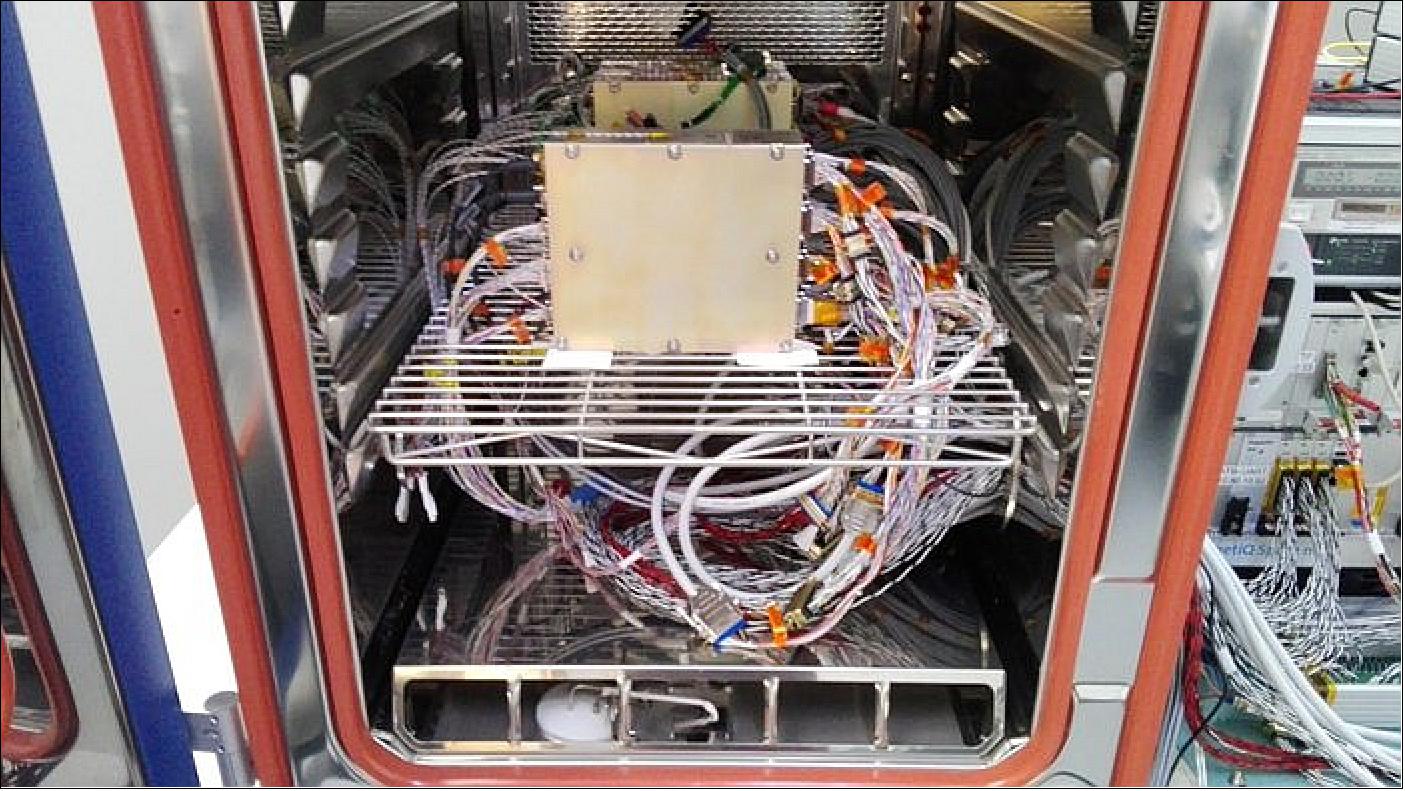
Pushing the boundaries of autonomy
- As for all deep-space missions, support from ground control will be constrained as well. The sheer distance involved means that real-time control will not be feasible. Hera’s computer will be capable of making many of its own decisions. In addition, in the complex double asteroid environment of Didymos, switching into safe mode during critical close-proximity operations must be avoided.
- “In Earth orbit a mission’s computer going into safe mode is no big deal – the satellite itself is not going anywhere, there’s time to reconfigure it,” says Peter. “But in deep space, with big asteroids whirling around, any recovery from failure will have to be done autonomously, and as quickly as possible.
- “That implies maximum redundancy and fast switch-over times from the failing element to its backup. We actually have good experience of such hot redundancy from another company project: developing a safety-critical docking mechanism according to the International Birthing and Docking Mechanism Standard, which is used for making the connection between crewed and uncrewed spacecraft on one end and the International Space Station or in future the Lunar Gateway station, on the other.
- ”Our benchmark for Hera is that reconfiguration from any computer failure should be extremely fast, a matter of 10 to 20 seconds. Another design strategy is to deliberately not have all the functionality in the central onboard computer. On Hera the image processing – which can potentially be used for autonomous spacecraft navigation – will be performed by a dedicated unit, being developed by GMV in Romania.”
- It’s a similar approach to having a separate graphics card to make your home computer run video games better – avoiding clogging up the computer with computationally intensive but non-core tasks.
From the Proba fold
- Hera’s computer will run on a powerful dual-core LEON-3 processor – part of a family of ESA-developed microprocessors for space. Its overall design is developed from the ADPMS – Advanced Data and Power Management System – computer flown on Proba-2, Proba-V and the forthcoming Proba-3 mini-satellites. This computer has demonstrated more than 15 years of in-orbit operations with very high reliability.
- “We’ve reached the engineering model phase of our upgraded ADPMS design, which will serve the Altius ozone-monitoring mission as well as Hera.
- “This testing – supported through ESA’s General Support Technology Program – is taking place under our ProbaNEXT project, which is developing our next-generation Proba platform for a wide variety of uses and users.
- “Currently, we are qualifying the redundancy and fast switch-over time element of the design. This testing is allowing us to demonstrate all relevant functioning that Hera needs, so once the decision is made to fly the mission then we will be ready.”
• May 01, 2019: Small enough to be an aircraft carry-on, the Juventas spacecraft (CubeSat) nevertheless has big mission goals. Once in orbit around its target body, Juventas will unfurl an antenna larger than itself, to perform the very first subsurface radar survey of an asteroid. 34)
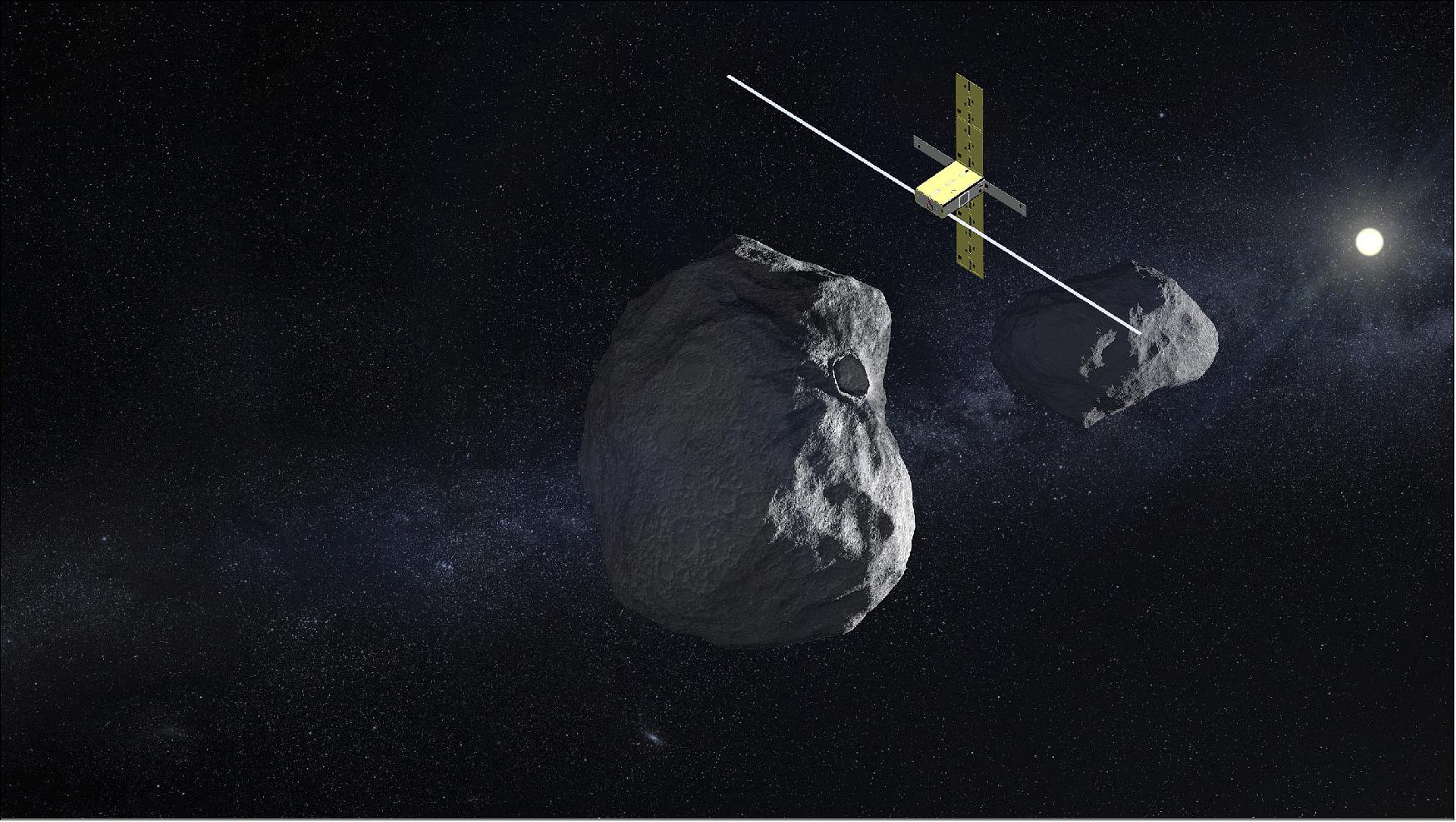
- ESA’s proposed Hera mission for planetary defence will explore the twin Didymos asteroids, but it will not go there alone: it will also serve as mothership for Europe’s first two ‘CubeSats’ to travel into deep space.
- Juventas will be a 6U CubeSat, selected to fly aboard Hera along with the similarly-sized APEX (Asteroid Prospection Explorer), built by a Swedish-Finnish-German-Czech consortium. 35)
- Juventas – the Roman name for the daughter of Hera – is being developed for ESA by the GomSpace company and GMV in Romania, together with consortia of additional partners developing the spacecraft instruments.
- “We’re packing a lot of complexity into the mission,” notes GomSpace systems engineer Hannah Goldberg. “One of the biggest misconceptions about CubeSats is that they are simple, but we have all the same systems as a standard-sized spacecraft.
- “Another reputation of CubeSats is that they don’t do that much, but we have multiple mission goals over the course of our month-long mission around the smaller Didymos asteroid. One of our CubeSat units is devoted to our low-frequency radar instrument, which will be a first in asteroid science.”
- Juventas will deploy a 1.5 m long radar antenna, which will unfurl like a tape measure, and was developed by Astronika in Poland. This instrument is based on the heritage of the CONSERT radar that flew on ESA’s Rosetta comet chaser, overseen by Alain Herique of the Institut de Planétologie et d'Astrophysique de Grenoble (IPAG).
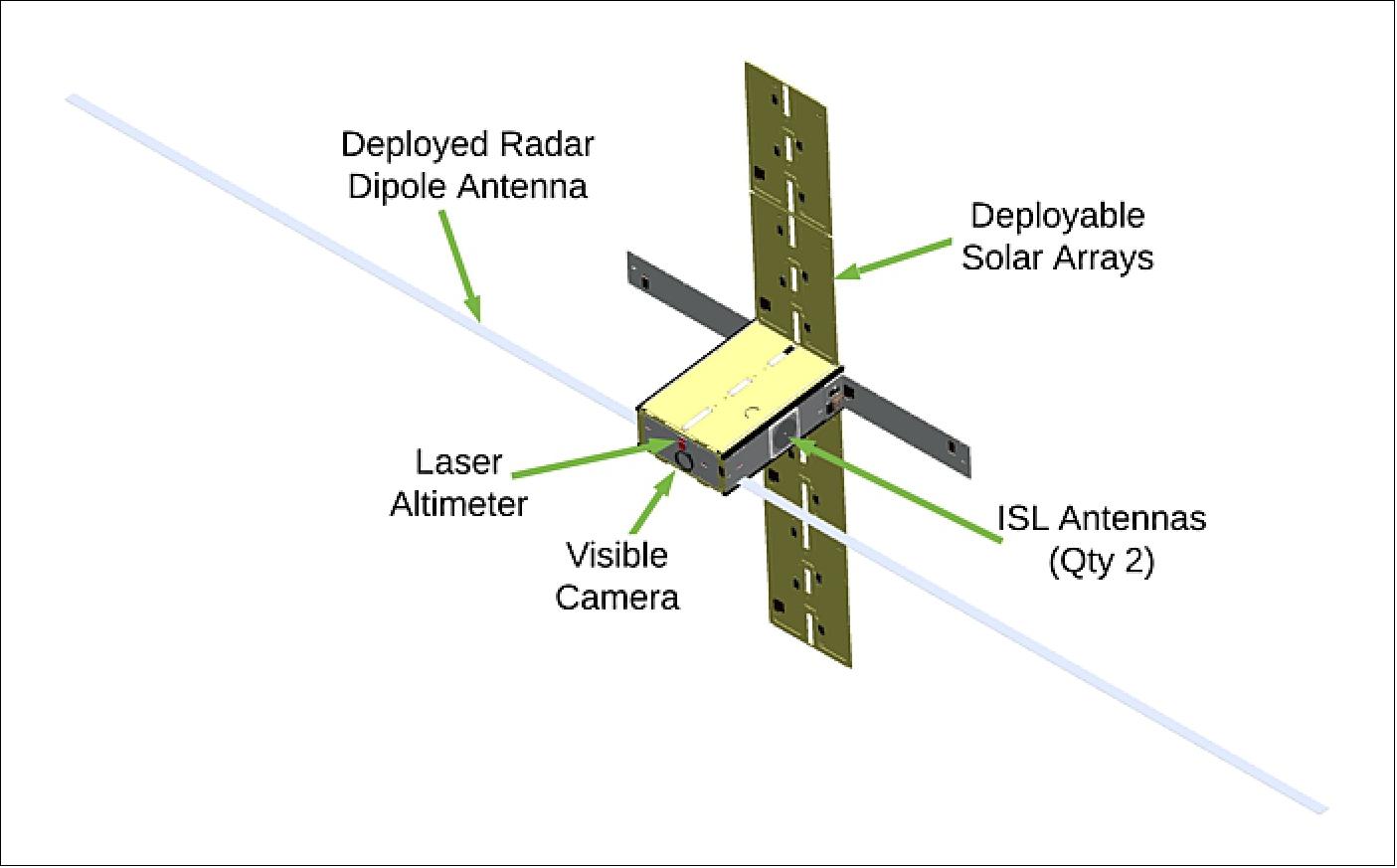
- The radar signals should reach 100 m down, giving insight into the asteroid’s internal structure. “Is it a rubble pile, or something more layered, or monolithic?” adds Hannah, who previously worked at asteroid mining company Planetary Resources before moving to GomSpace.
- “This is the sort of information that is going to be essential for future mining missions, to estimate where the resources are, how mixed up they are, and how much effort will be required to extract them.”
- ESA radar specialist Christopher Buck has worked on the instrument design with IPAG: “Our radar instrument’s size and power is much lower than those of previous missions, so what we’re doing is using a pseudo-random code sequence in the signals – think of it a poor man’s alternative. Navigation satellites use a comparable technique, allowing receivers to make up for their very low power.
- “We send a series of signals possessing constantly shifting signal phase, then we gradually build up a picture by correlating the reflections of these signals, employing their phase shifts as our guide. One reason we are able to do this is that we will be orbiting around the asteroid relatively slowly, on the order of a few centimeters per second, giving us longer integration times compared to orbits around Earth or other planets.”
- The technology proved itself with the Rosetta, where the CONSERT radar peered deep inside comet 67P/Churyumov–Gerasimenko and helped locate the Philae lander on the comet’s surface. Juventas uses a more compact ‘monostatic’ version of the design.
- As Juventas orbits, the CubeSat will also be gathering data on the asteroid’s gravity field using both a dedicated 3-axis ‘gravimeter’ – first developed by the Royal Observatory of Belgium for Japan’s proposed Martian Moons eXploration mission – as well as its radio link back to Hera, measuring any Doppler shifting of communications signals caused by its proximity to the body.
- “But the mission is being designed to operate with minimal contact with its mothership and the ground, operating autonomously for days at a time,” says Hannah. “This is a big difference from Earth orbit, where communications are much simpler and more frequent. So we will fly in what is called a ‘self-stabilizing terminator orbit’ around the asteroid, perpendicular to the Sun, requiring minimal station-keeping maneuvering.”
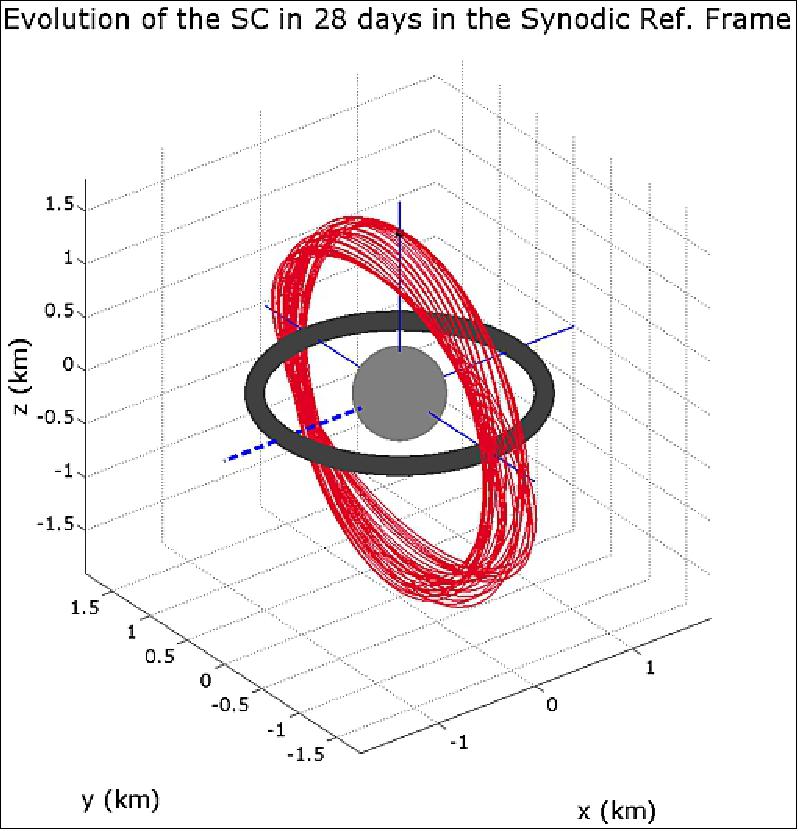
- The final phase of the mission will come with a precisely-controlled attempt to land on the asteroid.
- “We’ll have gyroscopes and accelerometers aboard, so we will capture the force of our impact, and any follow-on bouncing, to gain insight into the asteroid’s surface properties – although we don’t know how well Juventas will continue to operate once it finally touches down. If we are able to successfully operate after the impact, we will continue to take local gravity field measurements from the asteroid surface.”
- The Hera mission, including its two CubeSats, will be presented to ESA’s Space19+ meeting this November, where Europe’s space ministers will take a final decision on flying the mission.
• April 9, 2019: Engineers designing the European Space Agency (ESA)’s Hera planetary defense mission to the Didymos asteroid pair are developing advanced technology to let the spacecraft steer itself through space, taking a similar approach to self-driving cars. 36)
- “If you think self-driving cars are the future on Earth, then Hera is the pioneer of autonomy in deep space,” explains Paolo Martino, lead systems engineer of ESA's proposed Hera mission. “While the mission is designed to be fully operated manually from ground, the new technology will be tested once the core mission objectives are achieved and higher risks can be taken.”
• March 15, 2019: The mission to the smallest asteroid ever explored will employ the same main camera as the mission to the largest asteroids of all. ESA’s proposed Hera spacecraft to the Didymos asteroid pair has inherited its main imager from NASA’s Dawn mission to the Vesta and Ceres asteroids. 37)
- Hera is currently the subject of detailed design work, ahead of being presented to Europe’s space ministers at the Space19+ Ministerial Council at the end of this year. The spacecraft will survey a tiny 160-m diameter moon of the 780-m diameter Didymos asteroid, in the aftermath of a pioneering planetary defence experiment.
- But the Asteroid Framing Camera (AFC) Hera will use to navigate through space and survey its targeted double asteroids is already built and ready. Two of these cameras – Hera will carry a pair, for redundancy – are sitting in protective nitrogen gas inside a clean room in Göttingen, Germany.
- “The AFC was designed specifically for NASA’s Dawn mission to the two largest bodies in the Asteroid belt: Vesta, at 525 km across, and 946 km diameter Ceres,” explains Holger Sierks of the Max Planck Institute for Solar System Research.
- “There was no other camera aboard the spacecraft so the AFC had a mission-critical role, being employed both for navigation and scientific investigation. The AFC worked like Swiss clockwork throughout Dawn’s 11-year lifetime. Before Dawn finally ended in November 2018 the spacecraft came as close as 30 km from the surface of Ceres, and returned spectacular views of its striking bright spots. At the same time the camera, equipped with seven spectral filters from the visible to the near-infrared, was able to gather spectral information on these formations, as well as the rest of the asteroids. An eighth clear filter was used when the AFC was employed for navigation purposes and for broadband surface science.”
- Two AFC flight units were supplied to NASA by the Institute, in cooperation with the DLR German Aerospace Center and the Technical University of Braunschweig’s Institute of Computer and Network Engineering. A spare camera was built and kept at the Institute to replace a flight unit if needed.
- “We still had spare, flight quality subsystems including the optics that we could integrate into a full camera, so ended up with two flight ready spares on the shelf,” adds Holger. “We wanted to find a flight use for them, and decided we should contribute these fully mission proven cameras to Europe’s next asteroid mission free of charge.”
- The 5.5 kg AFC resembles a computer printer-sized box containing power and mass memory with a thermally insulated telescope extending out from it. Maximum image sensitivity is ensured by cooling the telescope’s CCD light detector down to -60 °C.
- One qualification model camera has already been lent to GMV in Spain as they develop autonomous navigation systems for Hera. This allows the team to test their feature-detecting algorithms with the same hardware as will actually be flown.
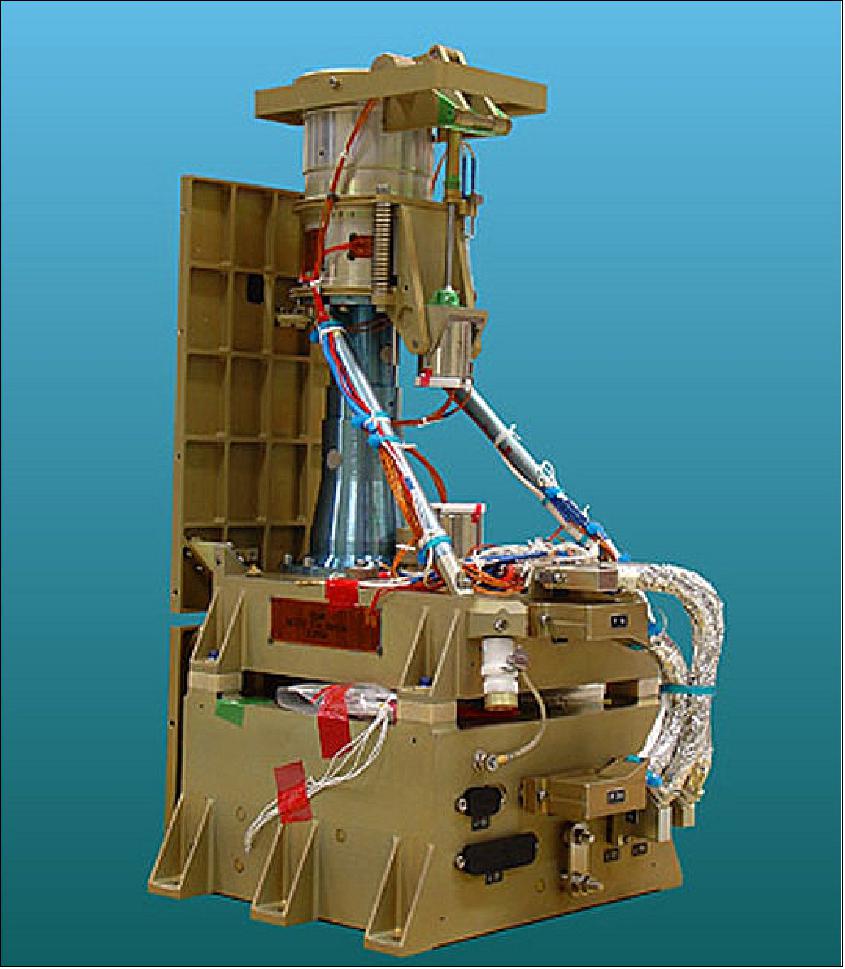
- While the AFC was designed specifically for Vesta and Ceres, Holger explains the camera is also a very good fit for Hera – especially with its dual science and navigation functionality: “When we designed it, those two asteroids were only known to us as little dots in the sky, just a few pixels across at best using the Hubble Space Telescope, like the Didymos system today. The camera’s optics – the work of the Kayser-Threde company in Munich, now owned by OHB – are distortion free with a sharp focus, right down to 150 m from the target surface.”
- The Max Planck Institute for Solar System Research also built the Rosetta comet chaser’s main Osiris science imager, so has plenty of experience in imaging distant planetoids close up. “These bodies would be dark like charcoal to the human eye, so it takes highly sensitive detectors and carefully judged exposure times to see what we see.”
- Hera’s planetary defence purpose feels personal to Holger and the rest of the Institute team. The team recently met in the German town of Nördlingen, located inside a 24-km diameter crater, formed by an impacting binary asteroid just like Didymos and its moon an estimated 14 million years ago.
• March 5, 2019: In the coming days the largest and most powerful telescopes in Europe and South America will be trained on a single spot in the sky, gathering details of twin asteroids to help guide the design of ESA’s proposed Hera mission, headed for the Didymos pair in late 2023. 38)
- Right now the Didymos asteroids are in opposition, meaning they are visible on the opposite side of the sky than the Sun. Currently some 145 million km from Earth, the main Didymos asteroid is around 780 m across with the smaller ‘Didymoon’ about 160 m across, orbiting around 1 km away from its parent.
- At such a distance, even observed through our planet’s largest telescopes, the asteroid pair appear as no more than a single bright point – about 200,000 times fainter than the faintest stars visible to the naked eye. But tiny variations in that brightness over time can give vital insights into the Didymos system.
- The observing campaign will commence over three nights from 8 March with the 10.4 m diameter Gran Telescopio Canarias telescope – the world’s largest single aperture optical reflector – located at the El Roque de los Muchachos Observatory on the island of La Palma, in the Canaries, Spain, and managed by the Instituto de Astrofísica de Canarias.
- The observations will progress over the next four nights using the 4.2 m diameter William Herschel Telescope – Europe’s second largest optical telescope –at the same site.
- In April the campaign will shift to the southern hemisphere, with three nights of observation during the month from the VLT (Very Large Telescope) – an interlinked quartet of 8.2 m diameter telescopes – at the European Southern Observatory site on a flattened mountaintop in Paranal, Chile. These observations will be led by astronomers Benoit Carry of the Observatoire de la Côte d’Azur, in Nice, France and Colin Snodgrass of the UK’s Open University.
- The observing campaign is being coordinated by a group of leading European astronomers, known as the Hera Remote Observations Working Group, supporting the planning of ESA’s Hera planetary defence mission.
- “Didymos is at its brightest at the moment, so we submitted a series of observing requests that were all accepted by the observatories,” explains astronomer Julia de Leon of the Instituto de Astrofísica de Canarias. The asteroids are too far away to resolve any features directly, but we use advanced CCD light detectors to measure small changes in brightness over time, which we can then convert into ‘lightcurves’. These are patterns of light shifts which we can employ in turn to derive details of the Didymos system.”
- The collective brightness of the pair varies as the two objects rotate, and also as Didymoon passes in front of, then behind, Didymos. Sharpening the lightcurves through fresh observations should yield valuable new information.
- “To achieve this, we really need the largest aperture, best telescopes in the world,” comments astronomer Petr Pravec of Ondřejov Observatory in the Czech Republic. “We need enough precision to pinpoint tiny details in the shape of the lightcurve. In particular, the shape and rotation of the secondary asteroid is still unknown.”
- Pravec, together with Petr Scheirich from the same institution, is in charge of analyzing the lightcurve data to interpret it and model the binary asteroids.
- As astronomer Alan Fitzsimmons, of the UK Queen's University Belfast, notes: “We assume Didymoon is tidally locked to its parent like our own Moon, which always presents the same face to Earth, but we want to be sure as the Hera mission design gets underway. This is especially important as the state of the Didymos system is set to change after 2022, when the US DART spacecraft will impact Didymoon in a historic first test of asteroid deflection techniques. Then in 2026 Hera arrives to take a close-up look.”
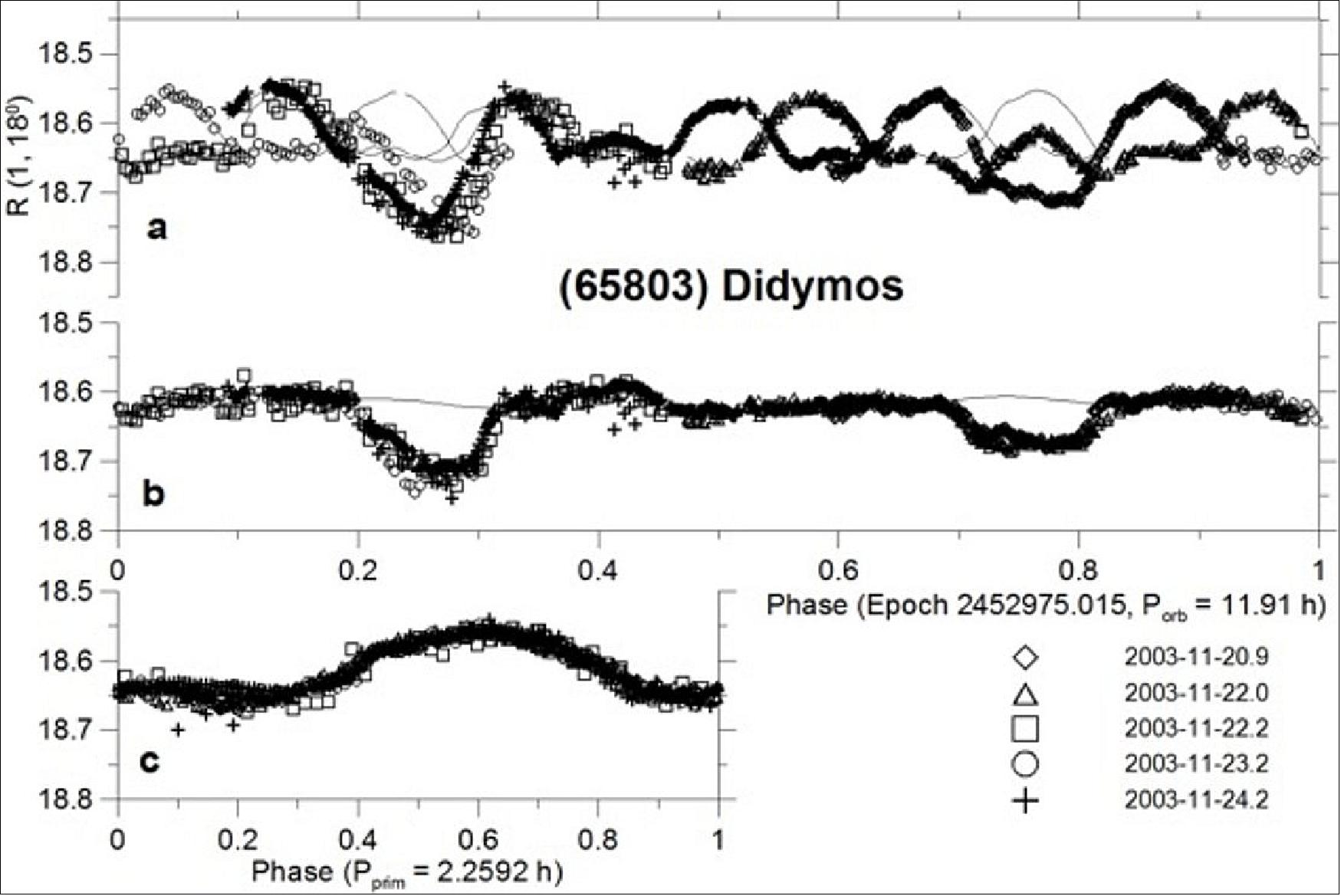
- Hera is being designed to gather essential knowledge to develop planetary defence techniques that is impossible to be gleaned from astronomical observations alone, or the imagery DART returns before its collision (the US spacecraft will also carry an Italian-made 'SelfieSat' CubeSat). Chief among these are the mass of Didymoon and the size and shape of the crater left by DART's impact.
- A parallel group of US astronomers is supporting the DART mission, undertaking their own campaign, and the two groups coordinate observations and share data.
• February 20, 2019: ESA’s proposed Hera mission will already visit two asteroids: the Didymos binary pair. The Hera team hopes to boost that number by performing a flyby of another asteroid during the mission’s three-year flight. 39)
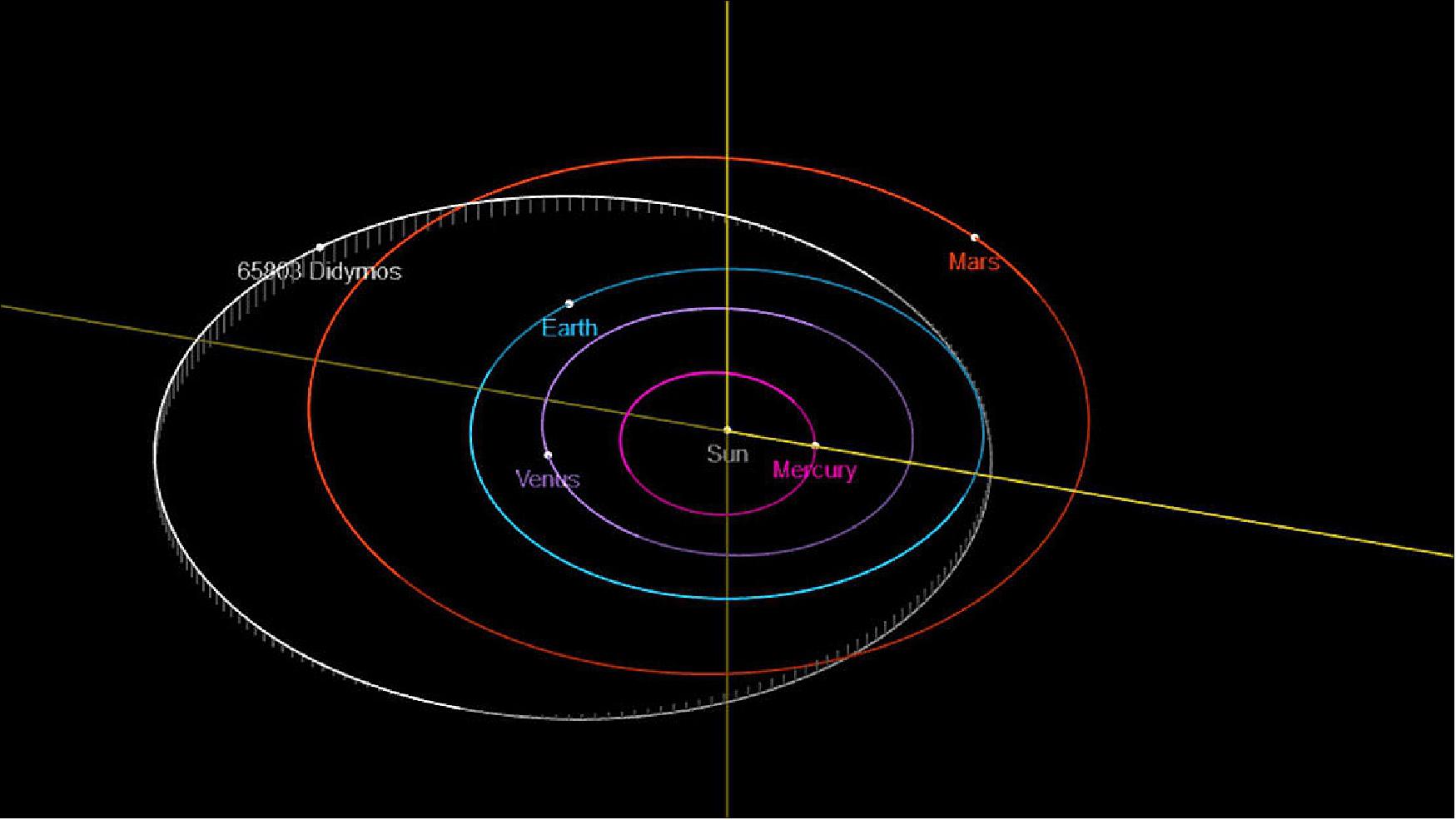
- The opportunity arises because Hera will be flying out to match Didymos’ 770-day orbit, which circles from less than 10 million km from Earth to out beyond Mars, at more than double Earth’s distance from the Sun.
- In the process Hera will pass both multiple near-Earth asteroids and the inner edge of the main Asteroid Belt. Initial studies at ESA’s European Space Operations Center have turned up dozens of candidate asteroids across different mission scenarios.
- “Ideally we would like a flyby of another binary asteroid, to enable comparisons with Didymos,” explains ESA’s Hera project scientist, Michael Küppers.
- “We would choose something of a different taxonomic type from the S-type asteroids like Didymos. We would also prefer a larger object: its greater size would allow us to resolve it meaningfully from further away.”
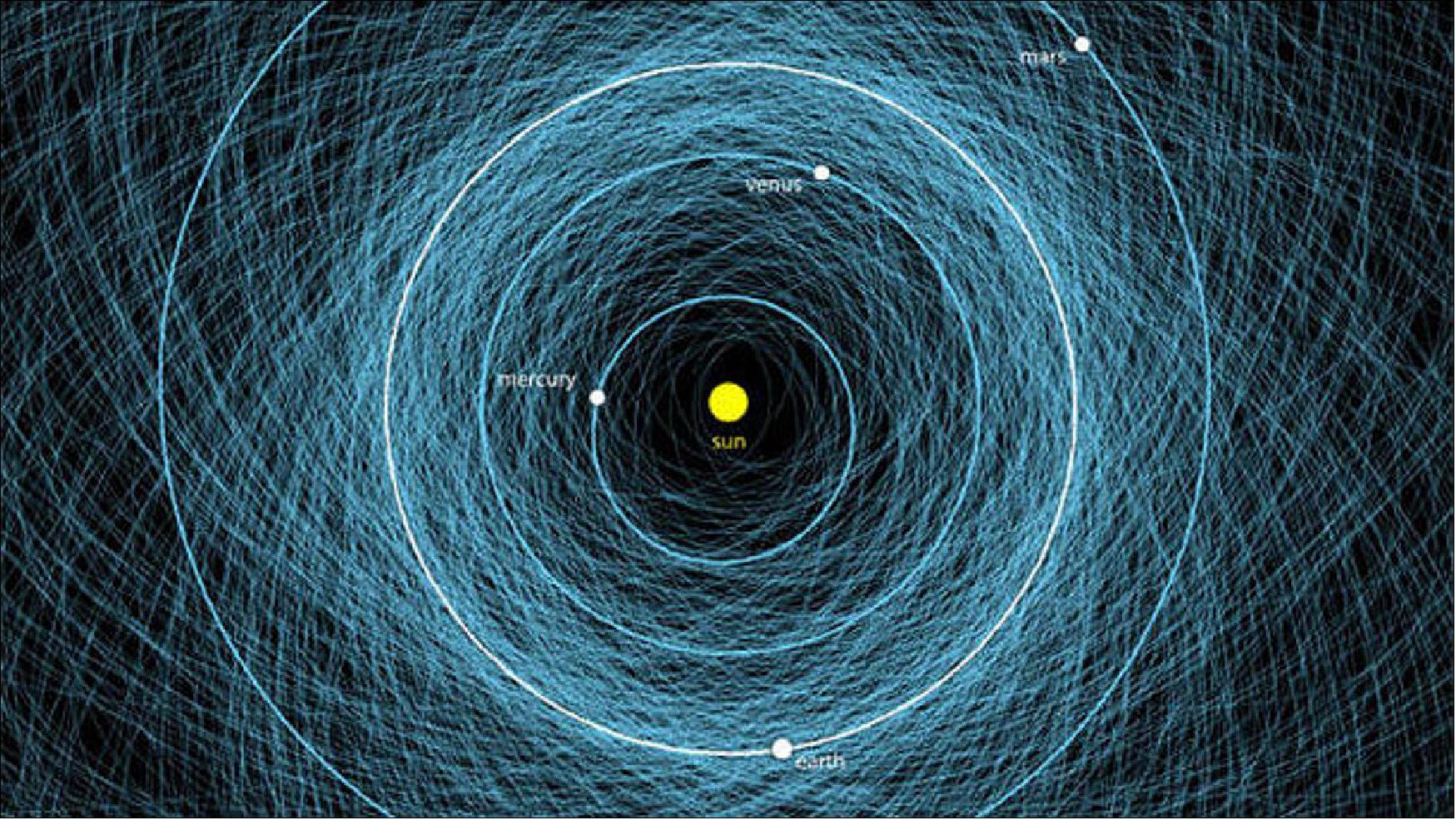
- Take as an example one body researchers would like to see: the 2121 Sevastopol binary pair in the inner belt has an 8.6 km diameter main body with a 3.5 km diameter moon.
- This system is a member of the poorly understood ‘Flora’ family of main belt stony asteroids, produced by a collision event a relatively recent 100 million years ago – theorized to be associated with the Chicxulub impact that killed the dinosaurs.
- The next step would be to create a shortlist of targets, which could then be the subject of ground-based observations to determine more about their properties and sharpen knowledge of their orbits.
- ESA’s Rosetta comet-chaser performed two asteroid flybys as it passed through the main belt during its decade-long flight to comet 67P/Churyumov–Gerasimenko, passing the 5-km diameter diamond-shaped 2867 Šteins and the mammoth 120-km diameter 21 Lutetia.
- “To make flybys happen, we have to know where our trajectory will pass relatively close to asteroids if we do nothing,” notes Michael Khan, heading Mission Analysis at ESA’s Flight Dynamics division. “Then we tweak the trajectory to make a specific difference to that distance, bringing us much closer.
- “With Rosetta we had a lot of capability, because it was a large spacecraft with extra fuel in in the tanks to get the mission back on track in case something went wrong. Plus we were performing lots of gravity-assist flybys around Earth and Mars, and massaging those flybys slightly gave us a lot of freedom to maneuver.
- “Hera is not Rosetta, however: this will be a smaller mission with a shorter cruise phase and lower performance limits. We will still try, but the constraints are such that we won’t know for certain which asteroids we could target until after Hera’s launch. It will come down to what day within Hera’s launch window that we take off, and also the precision of that take-off – it is possible that any extra fuel earmarked for asteroid flybys might be needed to fine-tune our trajectory to Didymos. But any flyby would be an excellent opportunity to boost Hera's science return even further.”
- To compare the two missions, Rosetta was lorry-sized, while Hera will be the scale of a desk. But any asteroid flyby would benefit its end mission as well as offering plentiful bonus science.
• January 7, 2019: When ESA’s planned Hera mission journeys to its target binary asteroid system, it will not be alone. The spacecraft will carry two tiny CubeSats for deployment around – and eventual landing on – the Didymos asteroids. Each companion spacecraft will be small enough to fit inside a briefcase, as compared to the desk-sized Hera. 40)
- CubeSats are nanosatellites based on standardized 10 cm-sized units. Hera has room to deliver two ‘six-unit’ CubeSat missions to the Didymos asteroid system – a 780 m-diameter mountain-sized main body is orbited by a 160 m moon, informally called ‘Didymoon’, about the same size as the Great Pyramid of Giza.
- The Hera mission received proposals for CubeSats from across Europe, and an evaluation board has now made the final selection.
- “We’re very happy to have these high-quality CubeSat missions join us to perform additional bonus science alongside their Hera mothership,” explains Hera manager Ian Carnelli. “Carrying added instruments and venturing much closer to our target bodies, they will give different perspectives and complementary investigations on this exotic binary asteroid. They will also give us valuable experience of close proximity operations relayed by the Hera mothercraft in extreme low-gravity conditions. This will be very valuable to many future missions.”
- Paolo Martino, Hera spacecraft lead engineer adds: “The idea of building CubeSats for deep space is relatively new, but was recently validated by NASA’s InSight landing on Mars last November, when a pair of accompanying CubeSats succeeded in relaying the lander’s radio signals back to Earth – as well as returning imagery of the Red Planet.”
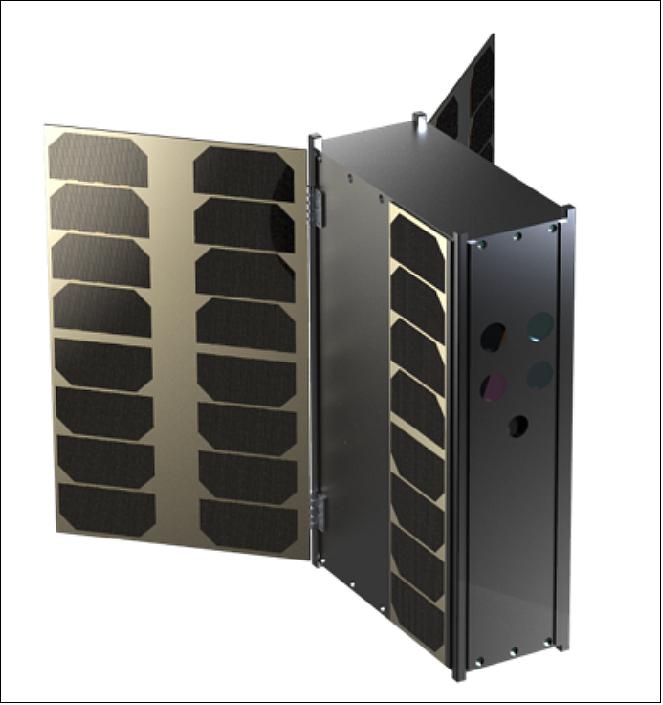
- APEX was developed by a Swedish/Finnish/Czech/German consortium. It will perform detailed spectral measurements of both asteroids’ surfaces – measuring the sunlight reflected by Didymos and breaking down its various colors to discover how these asteroids have interacted with the space environment, pinpointing any differences in composition between the two. In addition, APEX will make magnetic readings that will give insight into their interior structure of these bodies.
- Guided by a navigation camera and a ‘laser radar’ (lidar) instrument, APEX will also make a landing on one of the asteroids, gathering valuable data in the process using inertial sensors, and going on to perform close-up observations of the asteroid’s surface material.
- The other CubeSat is called Juventas, developed by Danish company GomSpace and GMV in Romania, and will measure the gravity field as well as the internal structure of the smaller of the two Didymos asteroids.
- In close orbit around Didymoon, Juventas will line up with Hera to perform satellite-to-satellite radio-science experiments and carry out a low-frequency radar survey of the asteroid interior, similar to performing a detailed ‘X-ray scan’ of Didymoon to unveil its interior. The adventure will end with a landing, using the dynamics of any likely bouncing to capture details of the asteroid’s surface material – followed by several days of surface operations.
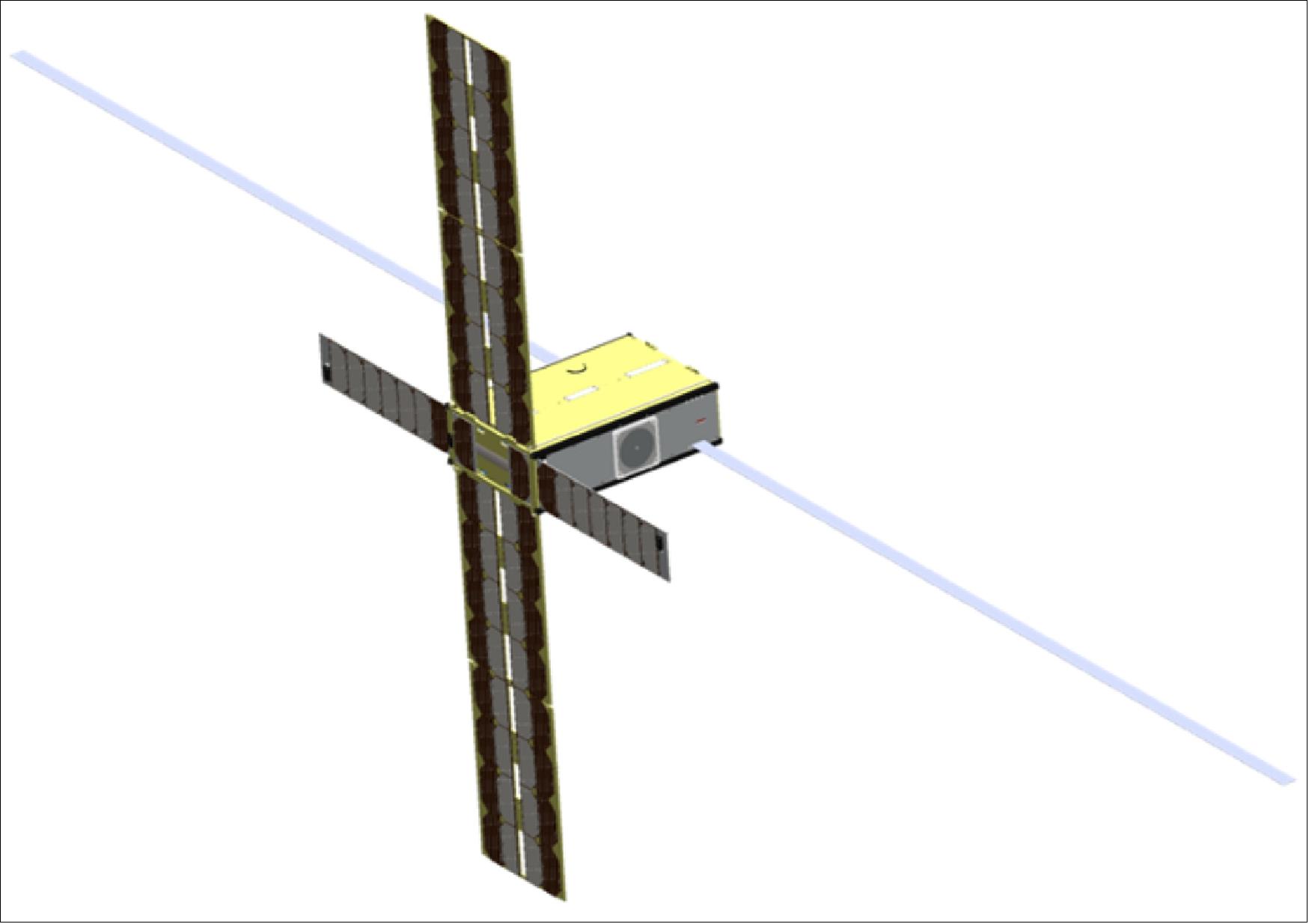
• October 31, 2018: A Halloween view inside one of the darker recesses of ESA’s technical heart. Shaded to resemble the blackness of deep space, the GRALs (GNC Rendezvous, Approach and Landing Simulator) is seen being used to test vision-based navigation algorithms under development for the proposed Hera binary asteroid mission. 41)
- Hera, Earth’s first mission to a binary asteroid system, would use vision-based algorithms to map surface features on an automated basis to plot its position in space and plan its onward route.
- Part of the Agency's Orbital Robotics and Guidance, Navigation and Control Laboratory in its ESTEC technical center in the Netherlands, GRALS is used to simulate close approach to uncooperative targets such as asteroids or drifting satellites.
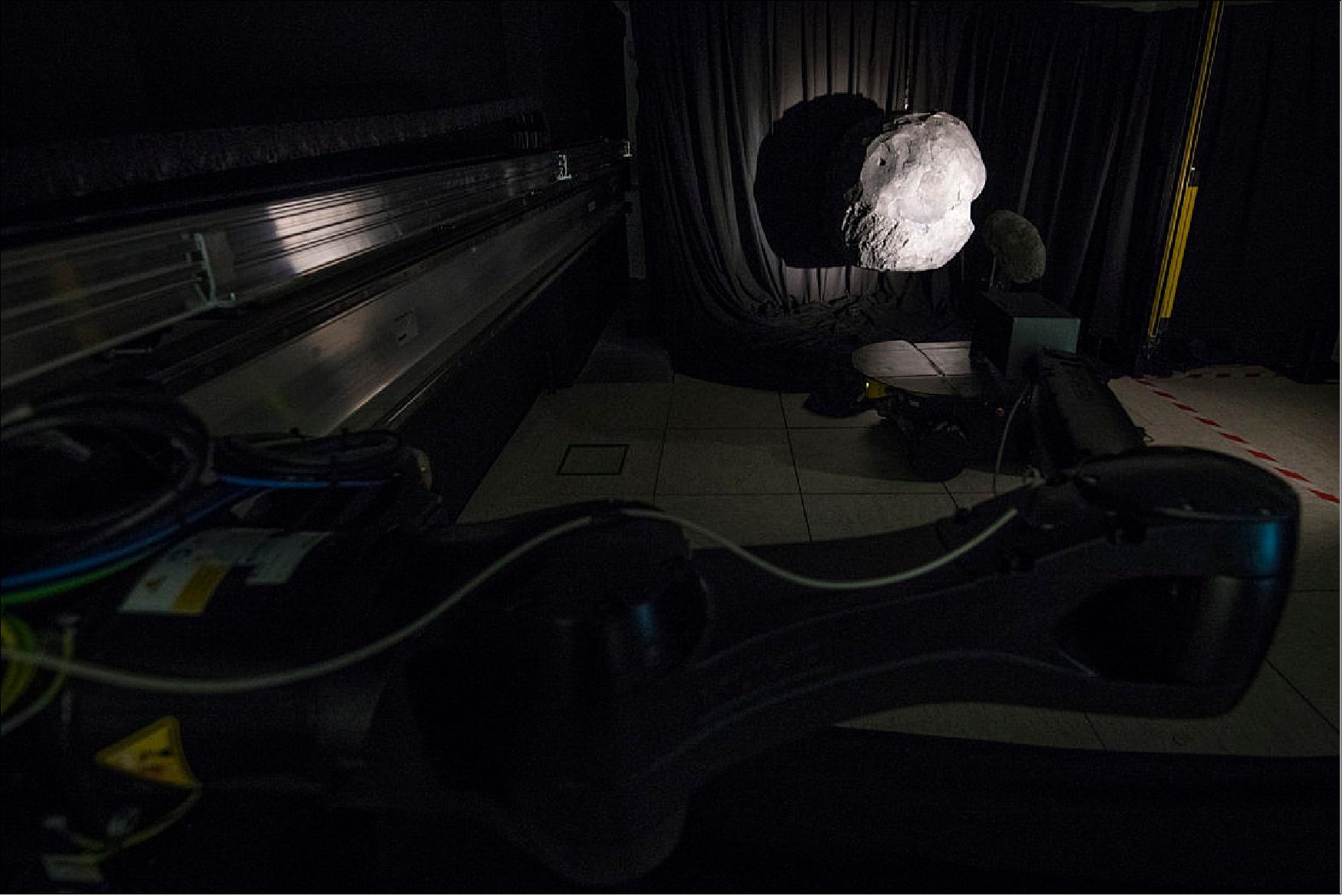
• September 25, 2018: As the world marvels at the hopping mini-rovers deployed on asteroid Ryugu by Japan’s Hayabusa-2, ESA is due to decide on the CubeSats planned for delivery to a binary asteroid system by its proposed Hera mission. 42)
- This week an ESA evaluation board decides which two 6U CubeSat missions will ride with the next-decade Hera mission to the Didymos asteroid system. The CubeSats will be deployed around the smaller of the two bodies for eventual landing.
- Landing in a low-gravity environment is a rare event – more akin to a docking than a traditional touchdown – so the Hera team has been following Hayabusa-2’s deployment closely. Famously the Philae lander of ESA’s Rosetta mission bounced off the surface of Comet 67P/Churyumov–Gerasimenko during its 2014 landing, coming down in a shady spot that drained its solar arrays and limited its lifetime.
- The MINERVA mini-lander accompanying Japan’s Hayabusa-1 to asteroid Itokawa was lost in space in 2005 when Itokawa’s gravity failed to bring it down. The two MINERVA-II mini-rovers deployed last week are designed to hop across Ryugu’s surface because traditional wheeled motion would cast them up into space again.
- The MINERVA-II mini-rovers weigh in at about 1.1 kg each, compared to Philae’s 100 kg. Hayabusa-2 is planned to deliver a larger 10 kg Mascot lander on 3 October – built by DLR (German Aerospace Center), responsible for Philae, in cooperation with the French space agency CNES – which will similarly be able to hop. By comparison Hera’s 6U CubeSats will be intermediate in size, around 6 kg each.
- “The CubeSats we are selecting have a different operating concept, intended to fly close above their asteroid with their own propulsion systems,” explains ESA space scientist and Rosetta veteran Michael Küppers, today serving as Hera project scientist.
- “At just 160 m across, the smaller component of the Didymos binary asteroid is too small to truly orbit around, but instead these CubeSats will fly Rosetta-like hyperbolic arcs, maintained by maneuvers every few days, hopefully culminating in landings.
• August 10, 2018: ESA’s proposed Hera mission, humankind’s first visit to a binary asteroid system, is set to undergo detailed study led by OHB System AG in Germany. 43)
- A multi-million euro contract awarded this week to the Bremen-based space company involves progressing the Hera mission, a further optimization of the previous AIM mission. This will render Hera ready for presentation to European space ministers at ESA’s Ministerial Council next year, to take a final decision on flying the mission.
- Building on the legacy of Europe’s Rosetta comet mission, Hera would fly to another small Solar System body, the Didymos pair of near-Earth asteroids.
- A 160 m moon, informally called ‘Didymoon’ – about the same size as the Great Pyramid of Giza – orbits the 780 m-diameter mountain-sized main body. This smaller moon is Hera’s main focus. By 2026, when Hera is expected to arrive, Didymoon will have achieved historic significance: the first object in the Solar System to have its orbit measurably shifted by human effort.
- A NASA mission called the Double Asteroid Redirection Test, or DART, is planned to collide with Didymoon in October 2022, attempting to deflect its orbit in a pioneering test of planetary defense. Hera will map the resulting crater as it surveys Didymoon’s surface, while also performing close-up measurement of the asteroid’s mass, building up a fuller picture of the collision and its aftermath.
- Hera is envisaged as a technology-testing mission, featuring onboard autonomy resembling that of driverless cars, and two CubeSats to be deployed in the vicinity of Didymoon. These will enable testing of multi-satellite intersatellite link technology as well as gathering experience of low-gravity operations with miniaturized systems, paving the way for future asteroid mining efforts.
• June 25, 2018: Planning for humankind’s first mission to a binary asteroid system has entered its next engineering phase. ESA’s proposed Hera mission would also be Europe’s contribution to an ambitious planetary defense experiment. 44)
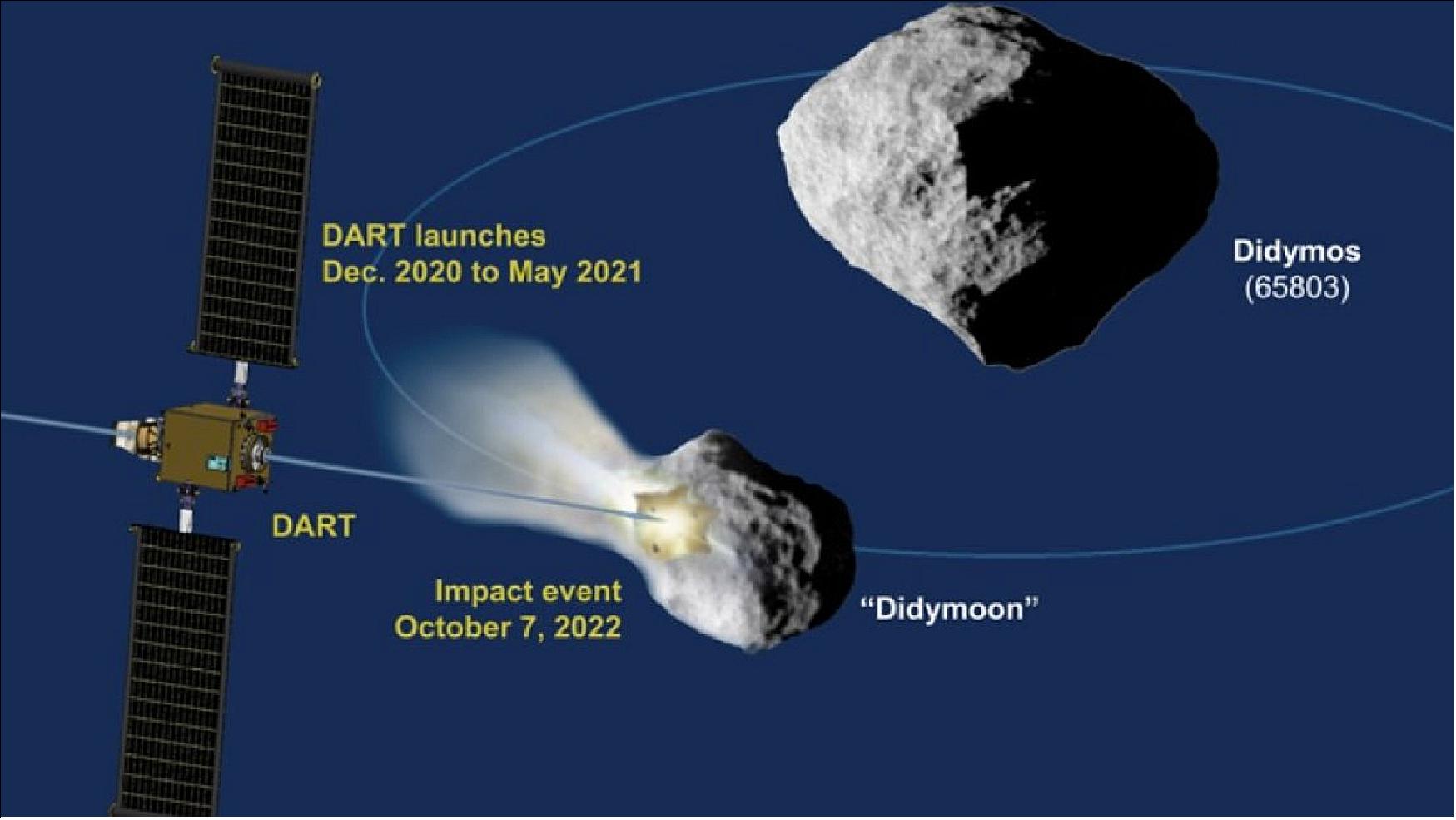
Sensor Complement
Gyroscope
• December 11, 2020: The very first sensor to be used by ESA’s Hera asteroid mission for planetary defence is currently being manufactured in Ireland. A gyroscope unit manufactured by Dublin-based InnaLabs will track the spacecraft’s spin rate as it tumbles away from its Ariane 6 launcher, allowing it to safely orient its solar panels to the Sun and come to life. 45)
Then, when Hera reaches the double-asteroid Didymos system, the gyro unit will give backup orientation information from the spacecraft’s main startracker system, whose optical view may be impacted by sun glare or asteroid dust.
The gyro will also ensure the spacecraft will speedily recover from any malfunction, switching into a steadily positioned ‘safe mode’ from which ground controllers can bring it back to full operation.
“This 3-axis gyro unit including electronics and shielding is only 1.5 kg in mass, but is really crucial to the mission,” explains Steeve Kowaltschek, Head of ESA’s Attitude and Orbit Control and Guidance Navigation and Control Sensors unit.
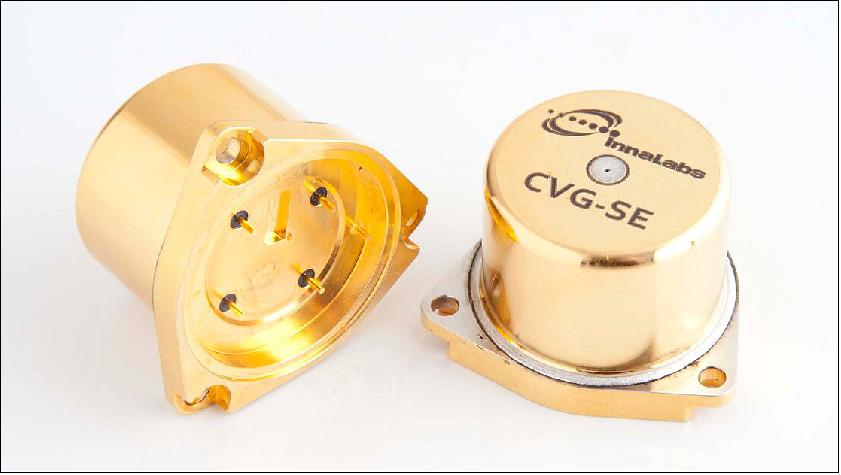
“ESA has been working with InnaLabs on its design and testing for the last three and a half years, using commercial off the shelf parts but qualified individually and collectively to space standards.”
With no up or down in space, gyros are used aboard many space missions. In function, they resemble the fast-spinning gyroscopes traditionally employed aboard submarines, aircraft, and missiles, whose spin maintains a fixed orientation, just like a child’s spinning top.
But modern solid-state gyros do without moving parts, instead relying on electrically-excited vibration of a solid cylindrical element whose pitch changes as its orientation does: rub a wineglass to make it ‘sing’ and its tone will change if you tilt it.
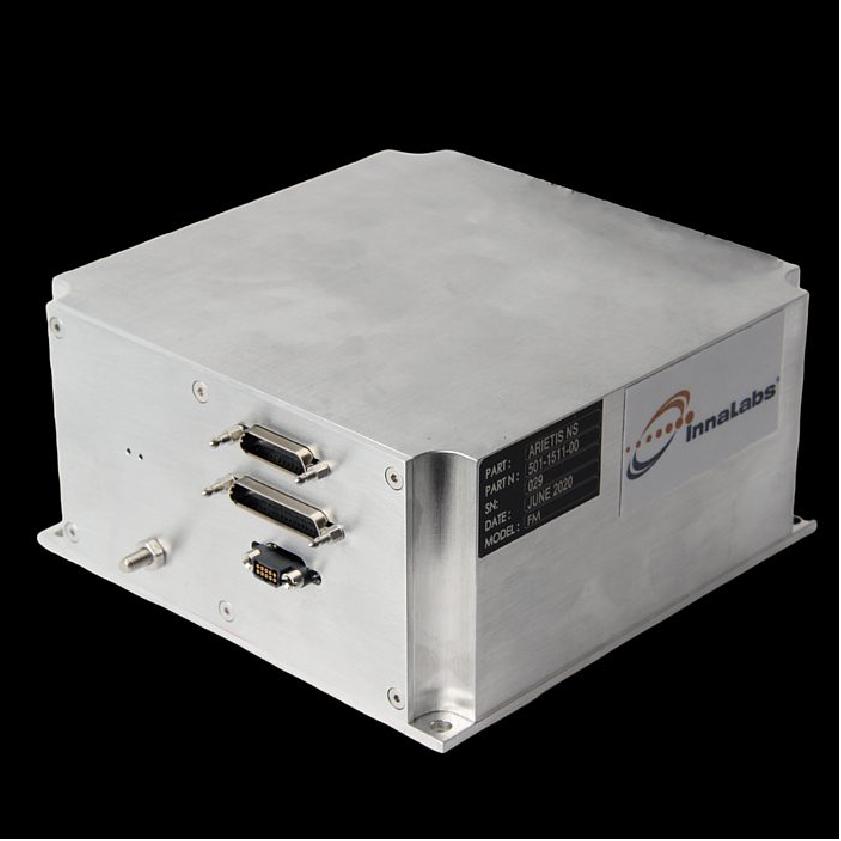
Camera
June 30, 2021: This is the main camera that ESA’s Hera mission for planetary defence will be relying on to explore and maneuver around the Didymos asteroid system. 46)
Hera – named after the Greek goddess of marriage – will be, along with NASA's Double Asteroid Redirect Test (DART) spacecraft, humankind’s first probe to rendezvous with a binary asteroid system, a little understood class making up around 15% of all known asteroids.
The DART spacecraft – due for launch this November – will first perform a kinetic impact on the smaller of the two bodies. Hera will follow-up with a detailed post-impact survey to turn this grand-scale experiment into a well-understood and repeatable asteroid deflection technique.
Produced by Jena-Optronik in Germany, this lightweight camera is being supplied to OHB System AG, leading the Hera industrial consortium for ESA. The camera will be used both for spacecraft navigation and scientific study of the two asteroids’ surfaces.
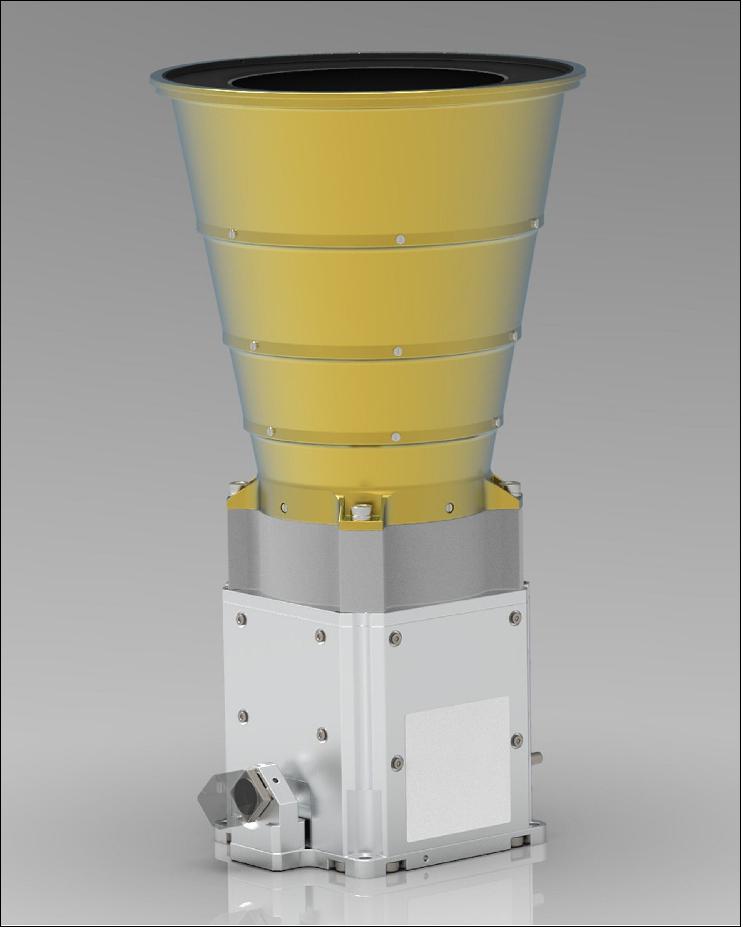
References
1) ”Hera,” ESA, 2018, URL: https://m.esa.int/Our_Activities/Space_Engineering_Technology/Hera/Hera2) ”Testing deflection,” ESA, 9 May 2018, URL: http://m.esa.int/spaceinimages/Images/2018/06/Testing_deflection
3) Patrick Michel, Michael Kueppers, Ian Carnelli, ”New Knowledge Gained from the Hera Mission: the European Component of the Asteroid Impact and Deflection Assessment (AIDA) Cooperation,” Proceedings of the 69th IAC (International Astronautical Congress) Bremen, Germany, 1-5 October 2018, paper: IAC-18.A3.4A.6, URL: https://iafastro.directory/iac/proceedings/IAC-18/IAC-18/A3/4A/manuscripts/IAC-18,A3,4A,6,x43215.pdf
4) ”ESA plans mission to smallest asteroid ever visited,” ESA, 4 February 2019, URL: http://m.esa.int/Our_Activities/Space_Engineering_Technology/Hera/ESA_plans_mission_to_smallest_asteroid_ever_visited
5) ”GMV leads the system that "drives" the HERA mission for planetary defence,” Space Daily, 14 December 2018, URL: http://www.spacedaily.com/reports/GMV_leads_the_system_that_drives_the_HERA_mission_for_planetary_defence_999.html
6) Ian Carnelli, Michael Kueppers, Patrick Michel, Paolo Martino, Massimo Casasco, Jesus Gil Fernandez, Paolo Concari, Ana Rugina, Borja Garcia Gutierrez, Michael Khan, Alberto Valverde Carretero, ”Hera mission to asteroid Didymos: ESA contribution to the AIDA international collaboration,” Proceedings of the 70th IAC (International Astronautical Congress), Washington DC, USA, 21-25 October 2019, paper: IAC-19-A3.1.4A, URL: https://iafastro.directory/iac/proceedings/IAC-19/IAC-19/A3/4A/manuscripts/IAC-19,A3,4A,9,x49489.pdf
7) ”Hera mission timeline,” ESA, 4 June 2018, URL: https://m.esa.int/spaceinimages/Images/2018/06/Hera_mission_timeline
8) ”ESA plans mission to smallest asteroid ever visited,” ESA, 04 February 2019, URL: http://m.esa.int/Our_Activities/Space_Engineering_Technology/Hera/ESA_plans_mission_to_smallest_asteroid_ever_visited
9) ”Hera mission logo,” ESA, 3 May 2019, URL: http://www.esa.int/spaceinimages/Images/2019/05/Hera_mission_logo
10) ”CubeSat named for pioneer of European planetary defence,” ESA Safety & Security, 30 June 2021, URL: https://www.esa.int/Safety_Security/Hera/CubeSat_named_for_pioneer_of_European_planetary_defence
11) ”Hera asteroid mission’s first step,” ESA Enabling & Support, 15 June 2022, URL: https://www.esa.int/ESA_Multimedia/Images/2022/06/Hera_asteroid_mission_s_first_step
12) ”Backbone of Hera asteroid mission,” ESA-Agency, 10 March 2022, URL: https://www.esa.int/About_Us/Week_in_images/Week_in_images_7_-_11_March_2022
13) ”Testing mini-radar to peer inside asteroid,” ESA Safety & Security, 11 November 2021, URL: https://www.esa.int/ESA_Multimedia/Images/2021/11/Testing_mini-radar_to_peer_inside_asteroid
14) ”The Incredible Adventures of the Hera mission – Presenting Hera,” ESA Safety & Security, 01 June 2021, URL: https://www.esa.int/Safety_Security/Hera/The_Incredible_Adventures_of_the_Hera_mission_Presenting_Hera
15) ”Drone test of Hera mission's asteroid radar,” ESA Safety & Security, 14 April 2021, URL: https://www.esa.int/ESA_Multimedia/Images/2021/04/Drone_test_of_Hera_mission_s_asteroid_radar
16) ”Brian May helps show Hera’s target asteroid may be ‘dust bunny’,” ESA Safety & Security, 30 March 2021, URL: https://www.esa.int/Safety_Security/Hera/Brian_May_helps_show_Hera_s_target_asteroid_may_be_dust_bunny
17) Yun Zhang, Patrick Michel, Derek C. Richardson, Olivier S. Barnouin, Harrison F. Agrusa, Kleomenis Tsiganis, Claudia Manzoni, Brian H. May, ”Creep stability of the DART/Hera mission target 65803 Didymos: II. The role of cohesion,” Icarus, Volume 362, 1 July 2021, 114433, https://doi.org/10.1016/j.icarus.2021.114433
18) ”Hera – ESA’s planetary defence mission (preview of fulldome planetarium show),” ESA Safety & Security, 02 February 2021, URL: https://www.esa.int/Safety_Security/Hera/ESA_s_planetary_defence_mission_full_dome_show
19) ”Industry starts work on Europe’s Hera planetary defence mission,” ESA Safety & Security, 15 September 2020, URL: https://www.esa.int/Safety_Security/Hera/Industry_starts_work_on_Europe_s_Hera_planetary_defence_mission
20) ”Hera and its asteroid target,” ESA, 24 June 2020, URL: http://www.esa.int/ESA_Multimedia/Images/2020/06/Hera_and_its_asteroid_target
21) ”Name given to asteroid target of ESA’s planetary defense mission,” ESA Safety & Security, 23 June 2020, URL: http://www.esa.int/Safety_Security/Hera/Name_given_to_asteroid_target_of_ESA_s_planetary_defence_mission
22) ”ESA highlights protection for our planet ahead of Asteroid Day,” ESA Safety & Security, 22 June 2020, URL: http://www.esa.int/Safety_Security/ESA_highlights_protection_for_our_planet_ahead_of_Asteroid_Day
23) ”Queen’s Brian May works to probe origin of asteroids,” ESA / Safety & Security / Hera, 2 June 2020, URL: http://www.esa.int/Safety_Security/Hera/Queen_s_Brian_May_works_to_probe_origin_of_asteroids
24) P. Michel, R.-L. Ballouz, O. S. Barnouin, M. Jutzi, K. J. Walsh, B. H. May, C. Manzoni, D. C. Richardson, S. R. Schwartz, S. Sugita, S. Watanabe, H. Miyamoto, M. Hirabayashi, W. F. Bottke, H. C. Connolly, M. Yoshikawa & D. S. Lauretta, ”Collisional formation of top-shaped asteroids and implications for the origins of Ryugu and Bennu,” Nature Communications, Volume 11, Article No 2655, Published: 27 May 2020, https://doi.org/10.1038/s41467-020-16433-z, URL: https://www.nature.com/articles/s41467-020-16433-z.pdf
25) ”Seeing asteroids in the dark,” ESA Enabling & Support, 15 April 2020, URL: http://www.esa.int/ESA_Multimedia/Images/2020/04/Seeing_asteroids_in_the_dark
26) ”ESA’s Hera asteroid mission is go,” ESA Safety & Security, 29 November 2019, URL: http://www.esa.int/ESA_Multimedia/Videos/2019/11/ESA_s_Hera_asteroid_mission_is_go
27) ”Amateur astronomers: help choose asteroid flybys for Hera,” ESA / Safety & Security / Hera, 26 November 2019, URL: https://www.esa.int/Safety_Security/Hera/Amateur_astronomers_help_choose_asteroid_flybys_for_Hera
28) ”The Planetary Society Urges ESA's Member States to Fund the Hera Mission,” The Planetary Society, 22 November 2019, URL: https://www.planetary.org/press-room/releases/2019/planetary-society-supports-the-hera-mission.html
29) ”Apollo astronaut champions Hera for planetary defence,” ESA / Safety & Security / Hera, 5 November 2019, URL: http://www.esa.int/Safety_Security/Hera/Apollo_astronaut_champions_Hera_for_planetary_defence
30) ”Hera logo aboard ISS,” ESA, 4 October 2019, URL: http://www.esa.int/spaceinimages/Images/2019/10/Hera_logo_aboard_ISS
31) ”Asteroids, comets and moons,” ESA, 13 August 2019, URL: http://www.esa.int/Our_Activities/Preparing_for_the_Future/Discovery_and_Preparation/Asteroids_comets_and_moons
32) ”When CubeSats meet asteroid,” ESA, 28 June 2019, URL: http://www.esa.int/Our_Activities/Space_Safety/Hera/When_CubeSats_meet_asteroid
33) ”Hera asteroid mission’s brain to be radiation-hard and failure-proof,” 11 June 2019, URL: http://www.esa.int/Our_Activities/Space_Safety/Hera/Hera_asteroid_mission_s_brain_to_be_radiation-hard_and_failure-proof
34) ”Hera’s CubeSat to perform first radar probe of an asteroid,” ESA, 01 May 2019, URL: http://www.esa.int/Our_Activities/Space_Safety/Hera/Hera_s_CubeSat_to_perform_first_radar_probe_of_an_asteroid
35) ”Hera’s APEX CubeSat will reveal the stuff that asteroids are made of,” ESA, 02 May 2019, URL: http://www.esa.int/Our_Activities/Space_Safety/Hera/Hera_s_APEX_CubeSat_will_reveal_the_stuff_that_asteroids_are_made_of
36) ”Self-driving space exploration - A new spacecraft from the European Space Agency will be able to steer itself through space,” ESA, Science Node, 9 April 2019, URL: https://sciencenode.org/feature/Self-driving%20spaceship.php
37) ”ESA’s Hera asteroid mission borrows eyes of NASA’s Dawn,” ESA, 15 March 2019, URL: http://m.esa.int/Our_Activities/Operations/Space_Safety_Security/Hera/ESA_s_Hera_asteroid_mission_borrows_eyes_of_NASA_s_Dawn
38) ”World’s best telescopes target asteroids for ESA’s Hera mission,” ESA, 5 March 2019, URL: http://m.esa.int/Our_Activities/Space_Engineering_Technology/Hera/World_s_best_telescopes_target_asteroids_for_ESA_s_Hera_mission
39) ”Close encounters: planning for extra Hera flyby,” ESA, 20 February 2019, URL: http://m.esa.int/Our_Activities/Space_Engineering_Technology/Hera/Close_encounters_planning_for_extra_Hera_flyby
40) ”CubeSats joining Hera mission to asteroid system,” ESA, 7 January 2019, URL: http://m.esa.int/Our_Activities/Space_Engineering_Technology/Hera/CubeSats_joining_Hera_mission_to_asteroid_system
41) ”Darkened GRALS chamber,” ESA, 31 October 2018, URL: http://m.esa.int/spaceinimages/Images/2018/10/Darkened_GRALS_chamber
42) ”ESA choosing CubeSat companions for Hera asteroid mission,” ESA, 25 September 2018, URL: http://m.esa.int/Our_Activities/Space_Engineering_Technology/Hera/ESA_choosing_CubeSat_companions_for_Hera_asteroid_mission
43) ”Germany’s OHB to bring ESA’s Hera asteroid mission to next level,” ESA, 10 August 2018, URL: http://m.esa.int/Our_Activities/Space_Engineering_Technology/Hera/Germany_s_OHB_to_bring_ESA_s_Hera_asteroid_mission_to_next_level
44) ”Earth's first mission to a binary asteroid, for planetary defence,” ESA, 25 June 2018, URL: https://www.esa.int/Our_Activities/Space_Engineering_Technology/Hera/Earth_s_first_mission_to_a_binary_asteroid_for_planetary_defence
45) ”Ireland helping ESA’s Hera asteroid mission find its way,” ESA Safety & Security, 11 December 2020, URL: https://www.esa.int/Safety_Security/Hera/Ireland_helping_ESA_s_Hera_asteroid_mission_find_its_way
46) ”Eye of ESA’s asteroid mission,” ESA Safety & Security, 30 June 2021, URL: https://www.esa.int/ESA_Multimedia/Images/2021/06/Eye_of_ESA_s_asteroid_mission
Spacecraft Launch Development Status Sensor Complement References Back to top